



Feature image: Still from Dreams Rewired: original source Das Auge der Welt (Germany 1935); dir: C. Hartmann
Dreams Rewired / Mobilisierung der Träume – Trailer from Amour Fou on Vimeo.
The 2015 film Dreams Rewired, recently shown at the Watermans Digital Weekender in London on 12-13 November, will be screened again at Watermans on 3 December. Directed by Manu Luksch, Martin Reinhardt and Thomas Tode, the film has the tagline ‘Every age thinks it’s the modern age’. It looks back to the early 20th Century, to the development and implementation (first locally, then globally) of the telephone, the radio and television.
The makers of Dreams Rewired unearthed and arranged early film recordings and brought them into the 21st century context. This was done via a playful narrative written by Manu Luksch and Mukul Patel and read by Tilda Swinton. The tagline was well chosen; almost everything Swinton says would have been relevant at almost any point within the last century. Time periods, machineries and political movements are connected in clever and unexpected ways, meaning that Dreams Rewired, a durational video whose narrative follows a recognisable storytelling structure, makes numerous links between times, places and people, which branch off from the safety of its linear structure.
Dreams Rewired is something of a treasure trove, not only for the glimpses its found-footage building-blocks gives into a past era but also because of the inter-generational, inter-national, inter-thematic connections it makes. Frequently while watching the film I felt the urge to burrow into an investigation of one of the clips, stories or introduced contexts. To emulate this ‘tip of the iceberg’ effect, this review will pull words directly from the film, linking quotations to some of the themes which appear and reappear throughout.
“A new electric intimacy”
With new media come new practices of communication. One of the recurring themes described in Dreams Rewired is the coupling of intimacy and invasion of privacy introduced to society along with a new communication method. Just as a new invention is prototyped, its social implementation causes new prototypical behaviours – new ways of caring, new ways of injuring, new comings-together, new separations. Uncertainty is inherent to experimentation.
“The waves travel at the speed of light, defining what simultaneous means. Information can travel no faster.”
When something is newly possible it also newly achievable – new precedents are set and new avenues opened for exploration. There is a flurry of activity, a rapid diversification. For those looking to gain or retain power over others, this is a problem; diversity requires more effort to manage. Initial flurries of activity are curtailed by the introduction of rules, the setting of precedents.
This limitation sets new targets to meet, new challenges to overcome. The cycle starts again as those in power look for ways to consolidate it while those without look to gain what they can. This is a simplistic, but not inaccurate, description of the machinery of the capitalist world.
This cycle of diversification and restriction is always coupled with the establishment and transcendence of thresholds. Experimentation with a new technology reveals some of its limits. (Side note – of course, what is understood as a limit is defined by wider cultural contexts.) “Information can travel no faster” is a provocation to speed up.
“Geography is history”
New advances cause conceptual shifts. Early telephony and television shrunk the gap in time between a thought or plan and its activation. Understandings of time and geography changed, and it became possible to move into new spaces and in new ways at socially impressive speeds. New powers, in short, were available to those who knew how to access them, to those who understood the preceding context well.
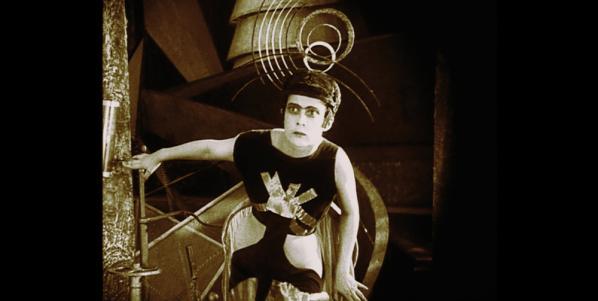
“A model of the new human is put into circulation”
A network grows, its complexity and partner processes intensifying. The machinery of daily life is altered, and daily life is a testing ground. Social interactions change as the new set of behaviours required to work the new machinery collide with existing social norms and rituals. New jobs and new workplace structures appear and people previously without responsibility or power find themselves in contact with it (though they may not understand the possibilities at first). People are no longer the same beings as before. Cycles of experimentation and consolidation reach into the body.
“Someone will have to lift us up. But who will lift them up?”
The flurry of excitement surrounding a new invention is based on the idea that ‘our’ lives will be improved, that ‘we’ will be able to do, see, have more. There is a problem here. The words ‘we’ and ‘us’ are too abstract – they bracket whoever the speaker wants them to bracket and recapitulate the prejudices they have. Anyone who is not included as part of the ‘we’ simply does not exist. This is convenient for the ‘us’ – while ‘we’ rush excitedly towards a future in which we have more and better, what ‘they’ do is of little concern. The ‘us’ does not care – or even think much – about the ‘them’. The ‘us’ cannot understand why the ‘them’ has not joined the ‘us’. After all, the ‘us’ is at a new threshold – who would not want to reach the other side?
“Personal profiles, passwords, biometrics..fully documented. Every trace filed. Bigger data, better analytics. Opt out, and we lose our place in the world. So…we share the keys to our desire, our habits, to ourselves.”
To be part of the ‘us’ and the ‘we’ requires effort. To ‘opt in’ requires sacrifice. At the same time, ‘opting in’ is the easiest thing in the world when ‘opting out’ means facing a void. Advice on how to do well, how to achieve, how to be healthy is easy to come by, but there is little guidance for those who find themselves, or wish themselves, outside the mainframe. Losing one’s place in the world means losing access to that mainframe and the stability that comes with a highly legible structure. Today the legible structure is far-reaching and well established, to the extent that opting out is dealt with violently. The new models of human coming into circulation have trouble recognising the old. There is a mutual rejection.

“Government regulation stifles amateur culture – military and commercial interests occupy most of the spectrum … transmission becomes a privilege, not a right”
As I wrote earlier, the ‘us’ and ‘them’ structure is too simple. It would be more accurate to think of people as communicating on multiple frequencies. The machinery of society is complicated to say the least, and made more so by the mainframe, which amplifies transmissions at some frequencies while restricting others. In the early 20th Century, multiple obscure radio channels were repressed, responsibility placed with public backlash following rumours that amateur radio was responsible for the sinking of the Titanic. Side questions: where did the rumours come from? What were they based on? How was the public response measured?
“For the first time he hears himself as others do. A voice absolutely familiar but estranged…But her power also grows: by controlling his voice she controls her time”
There is a strange relationship between the controller and the controlled. For every CEO there is a team whose own agenda seeps into the workings of the company. Dislocated power and fragmented or unplaceable identity are some of the symptoms of a complex system undergoing change. When a system is so complex as to involve multiple timescales, spaces, materials and structures, it is impossible to predict the future.
—
Dreams Rewired is part of the Technology is Not Neutral Symposium
3 December 2016
Watermans, London
https://www.watermans.org.uk/events/technology-is-not-neutral-symposium/
Megan Prelinger is an historian/archivist (originally from Oregon) who in 2004 co-founded a bibliophile’s utopia: the Prelinger Library. Tucked away in the SOMA district of San Francisco–and now highly regarded by researchers from around the world–the library has quietly become a California landmark. The myriads of materials contained there (books and ephemera “geospatially” arranged by Megan and her partner Rick) are made available to the public at least once a week for in-situ use (and one needn’t have academic credentials to enter).
In addition to being a world-renowned sharer (and repairer!) of books though, Megan Prelinger has also authored several. Inside the Machine–her latest work–is a book that traces a visual history of all manner of electronics from roughly the interwar era to the early space age. But it derives its narrative, she says, from exactly and only one source: “the intersection of commerce and graphic art.” As with her previous book (which presents commercial artists’ depictions of early space travel and rocket tech), Inside The Machine is a story told largely through the illustrations that one finds scattered throughout archival tech ephemera–of the sort that line many a shelf at the Prelinger Library. Prelinger’s visually rich book deftly guides the reader through countless innovations that preceded today’s computers, all with an eye towards celebrating the power and reach of the human imagination.
[The following interview was conducted via email.]
Montgomery Cantsin: You say that the Prelinger Library and its community constitute the “rhythmic pulse” which sustains your work as a writer of nonfiction. I wonder if you can say a bit more about that, and how that maybe differs from the situation of many nonfiction writers–that of being ensconced in a bureaucratic university setting. Also, how much of the material in your newest book was discovered there on your own shelves in San Francisco?
Megan Prelinger: During the research and writing of Inside the Machine, between 2011 and 2014, I was simultaneously engaged in a number of projects. You ask about how my situation differs from that of an academic historian: The academic model did not fully “take” in my mind when I was younger. It was introduced to me as one option among many, and I elected take the option of being an independent and self-supporting contributor to the human knowledge project. Throughout the duration of the library project, and my life for that matter, I have therefore always engaged in a number of different types of work more or less simultaneously; types of work that fall in different places on the spectrum between “day job” and freelance artist or knowledge-producer.
My work-week during those Inside the Machine years, as before and since, was a cycle of different forms of research, engagement, and production. The common anchor point around which every week “turns” is the public day in the library that happens every Wednesday. On those public days I set aside my own work and face outward, engaging our library visitors and facilitating their work. The Wednesday community is intellectually sustaining, as hundreds of people every year who are engaged in a universe of different kinds of research-based projects stop by and spend time. Our library is a social library, with discussion being one aspect of the access model. As with visitors, the collaborative relationships I’ve had with our volunteers and artists-in-residence such as yourself have put that library environment at the center of my social, intellectual and creative life since we opened it
To answer the question about how much of the material of the book was discovered on our own shelves: The short answer is “most of it.” There are 184 images in Inside the Machine, I believe, and about 6 of them were sourced from other collections. It was the serendipitous discovery of these overlooked images that drove the research process that became both Another Science Fiction (2010), and Inside the Machine (2015).
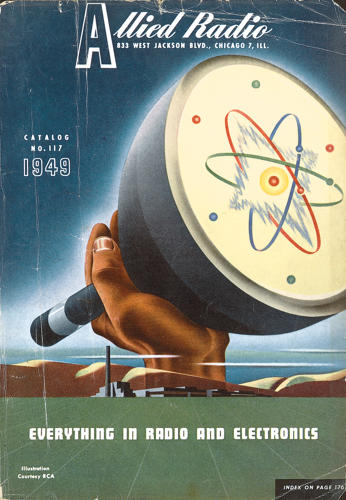
MC: I know that your interest in space travel developed in part due to your love of Star Trek as a youth. Is your interest in electronics something that grew out of that? At what point in your career did you realize you were passionate enough about electronics to write a book? …Have you ever tinkered with the insides of machines?
MP: My love of space exploration has many antecedents and you’re correct that Star Trek: TOS is one of them. I was born in 1967 as Season Two was beginning, just in time to be exposed fairly uncritically to a regular stream of images on television that suggested that space exploration was an emerging and “normal” part of everyday life. I remember watching Apollo astronauts explore the Moon on TV, and as a small child formed the unexamined assumption that Star Trek and the Apollo program were in a fact-and-fiction relationship to one another that was analogous to the relationship between the Little House on the Prairie books (fictionalized history) and the real histories of European colonization of North America (fact).
At the same time my dad was away in Vietnam serving in the U.S. Army construction brigades, while my mom was in college studying to be an archaeologist. Mom exposed me to Native American history, and Dad exposed me to the challenges of reintegrating into society as a damaged war veteran. Dad then became an architect. Those two parental models oriented me to the ground-based world that I lived in. I grew up sharply aware of divisions in society because of these two models, and had a sense of myself as an actor in a distinctly ground-based society. I studied anthropology and became a writer in order to develop tools to understand and affect the course of society and history.
The area of my psychogeography that was shaped by visions of space exploration were filled in by science fiction, which formed a bridge between ground-based and space-based spheres. In my thirties I discovered the left-behind literature of the mid-century space industry, and discovered that those handy tools of cultural analysis and writing would enable me to make an original contribution to the cultural history of space exploration. I was gobsmacked by this discovery. It was an unexpected point of integration between realms of my intellectual life and psychogeography that had previously been united only in the lifelong practice of reading and appreciating science fiction.
Coincidentally, in the course of taking that degree in anthropology I was required in college to take a year of science as a distribution requirement. This was actually a wish come true, since part of me had wanted to be a math major from the beginning but I lacked the background to do college-level math. That year-long general science course for non-science majors was possibly my favorite class in college. One third of the years’ curriculum was devoted to exploring electronics, understanding how circuits worked, learning to read circuit diagrams, and ultimately building a simple working radio out of found materials.
When my research on the cultural history of space exploration led me to try to understand space electronics, that history was invaluable. My passion to understand electronics grew directly out of a desire to understand why space exploration technologies matured when they did, apart from geopolitics and funding streams. When I realized that space exploration in the 1950s was reliant on the simultaneous development of very large-scale computers (mainframes) and very small-scale computers (the miniaturization made possible by the transistor), I then felt an overwhelming impulse to share what I had learned with other people. Inside the Machine ended up with a space electronics chapter in the 8th position (out of 9 chapters), but space electronics was the starting point in my research and the rest of the book mushroomed out from it.
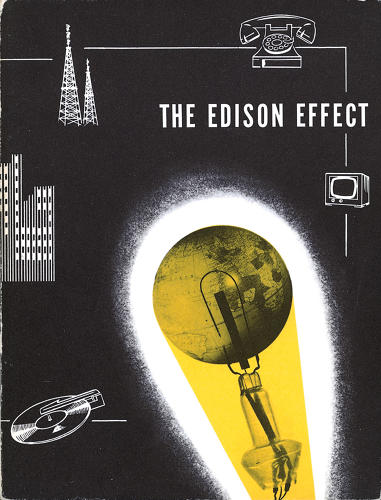
MC: The artists whose work is featured in your book (often anonymous at the time) were given the job of depicting a reality that exists, as you say, “behind reality.” You point to the inherent surrealism of such a task–can you expand on that? …You also note that in 1935, when the electric signals in the human brain were first detected, the study of the electricity, etc, was considered to be “a new assault on the mystery of life…”
MP: The study of the relationship between electricity and the human body is still pretty new. In fact, one reason that I wrote the book is that the future of the practical integration between electronics and the body could be immense enough that its recent history would be overshadowed. That history is already not commonly understood, even as people are increasingly symbiotic with their devices. I wrote the book to serve as a prehistory to counter any historical amnesia that may be induced by possible futures.
The scientific verification, in 1935, that life is reliant on a flow of electricity through the body, proved and extended an idea that Mary Shelley was working with in Frankenstein. Tracing the historical literature it’s interesting to watch the dialogue between electricity and the body migrate out of subcultures and into mainstream hard science over the past 200 years. I’m referring to subcultures like science fiction and also 19th-century experimental para-medical techniques, such as dosing people with electrical current to improve their health. That relationship was subjected to the changing standards of rigor around medical and scientific investigations over the 20th century. Today, work on electronic circuits that could have biomedical applications and that could actually be ingested and dissolved within the body is at the forefront of such research. Assuming that such circuits are developed and proven useful, I wouldn’t be surprised if they came to be a dominant biomedical technology.
When I say “behind reality” I’m referring most literally to the invisibility of the electron stream. While electricity can be made visible as illumination, the flow of electrons through electronic devices, on the other hand, is invisible. Hence, “Inside the Machine.” For a time the components that channeled the flow of electrons, such as vacuum tubes and switches, were visible on the inside of radio cabinets. Some 1930s radio cabinet designs deliberately revealed the circuit board in a gesture to demystify the flow of electrons and glamorize the components. That short window of visibility, however, quickly retreated in the face of ever more complex circuits and ever more “built” environments that housed them. The cultural signification around electronics came to be centered on the integral devices: radio, TV, and eventually computers and everything that flows from them. I felt that there was a cultural history of the components that combine to form electronic devices that needed to be told, and that it was the graphic artists and illustrators working for industry who had made that cultural history–a history that it became my job to expose and interpret for a contemporary audience.
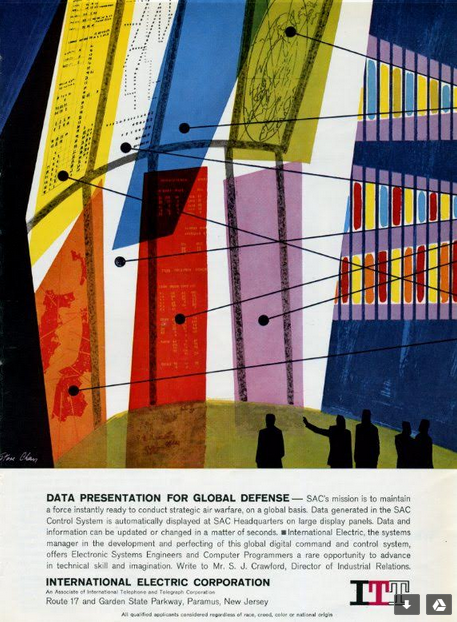
At a more philosophical level, the flow of electrons multiplied our senses. By forming invisible channels through which sounds and images were carried and replicated, electronics created a hierarchy of sense perceptions that had immediate cultural and political significations. How else to characterize that phenomenon besides surreal? Coincidentally the fine art movement known as Surrealism emerged in the 1920s and radios very shortly thereafter, coming to market in the late 20s and exploding in popularity during the 1930s. Think of it this way: multiple electromechanical eyes, faces, ears, and mouths populating homes, offices, and streets, in the form of a proliferation of new gadgets. The world filling with sense receptor multipliers everywhere you look. A mountaintop may be media in the sense that it opens up a perspective impossible to gain any other (unassisted) way, but a climb up a mountain is a unique event offering a unique perspective. Electronic media, in contrast, are most profound in their most ordinary distinguishing feature, which is their simultaneous multiplicity.
MC: You bring up Lewis Mumford in the book, saying that he regarded the craftperson’s bench as a sort of “bridge between art and applied skill.” To what degree has Mumford’s work influenced your thinking?
MP: I discovered the work of Lewis Mumford back in high school and appreciated his broad-spectrum thinking on a range of ground-based systems, like cities and highways. (The first book of his that I read was The Highway and the City.) Back in high school it was a novelty to me that subjects like freeways and cities were written about as subjects in their own right. They hadn’t been previously represented in any spectrum of “subjects” that I had been exposed to. I also liked about Mumford that he incorporated ecological thinking into his philosophies of the built environment, and that his environmental politics predated, and therefore did not fit into, contemporary modes of approaching those subjects.
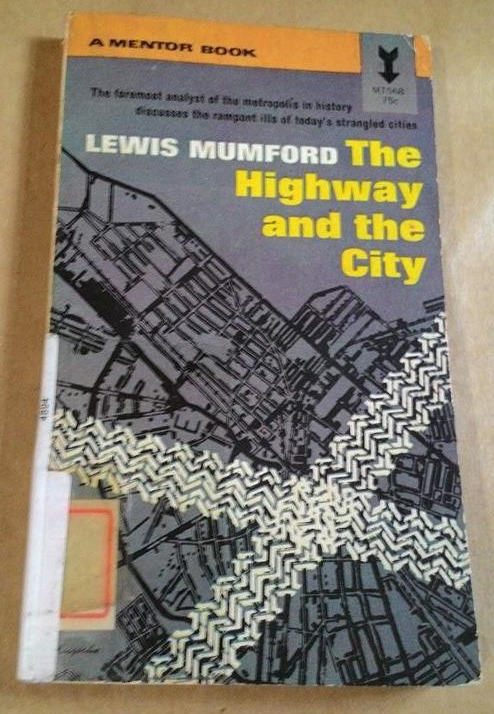
When it came to writing Inside the Machine, I drew on Mumford, who had once been a radio engineer, as a historian of technology (or “technics” in his parlance). His work to elaborate the relationship between fine art and applied art expressed by the craft bench was a needed historical context for discussing the relationship between craft and art.
MC: The constant need for an “enlargement of the military field of perception” has been hugely responsible for innovations in moving-image technology (I am quoting here from Paul Virilio’s book War and Cinema–which I found on your shelves). I wonder how things might have developed differently if such had not been the case? (In other words, if R&D had been guided by the Teslas and the Martenots of the world instead of by Westinghouse, the Pentagon, etc.).
MP: Well… the need for an enlargement of the military field of perception may have been responsible for innovations in moving-image technology, but it must exceed that in the extent to which it influenced space technology! The original satellite programs around the world, both USSR and US, were funded and dedicated to that purpose.
To get back directly, though, to the question you pose: It’s one that opens the door to many interesting possible alternate realities. That’s one reason I became so deeply focused on the work that fine and applied artists did to paint the future of new technologies. If I can make a blanket characterization of those artists as a group: I don’t think they were motivated to pick up a pencil or brush by a desire to enlarge the military field of perception! Instead they were creating all kinds of hybrid visions of the future, including pastoral and surrealist elements that addressed the multiplication of the senses in very humane terms.
There are perhaps more examples of the possibilities you suggest than you might think. For example: the influence of Hugo Gernsback, for whom the science fiction Hugo award is named. Gernsback was an active futurist who promoted science fiction and speculative futures through the mass publication of a wide range of pulp fiction magazines. At the same time he was a serious radio and TV pioneer who founded a radio station, experimented with early television broadcasting, and published “straight” news and craft magazine for radio professionals and amateurs alike, such as Radio-Electronics and Science and Mechanics to name just two. His “straight” news and craft magazines typically had a futurist-oriented editorial edge; one that was uninterested in mapping problems or limits or real-world geopolitics onto the emergence of new technologies. I don’t doubt that Gernsback’s influence was a shaping force on the emergence of electronic technology in ways that may not be fully understood for years. I don’t mean to dwell on Gernsback — he’s been widely written about in histories and biographies and I have never felt the call to add much to his hagiography. But I’m mentioning him here to directly respond to your query of “What if (R&D had been guided by the Teslas and the Martenots of the world)”. One more note: Tesla’s name was not attached to his invention in the way that Edison’s was, but he did invent AC (alternating current). Given that most people in the industrialized world use AC every day, I would argue that Tesla did guide the research and development of some of the essential infrastructure of everyday life.

MC: Toward the end of the book you wonder whether computers will someday be “grown” instead of built. Sounds cool! Brings to my mind certain left-field figures such as Bern Porter. …Porter chose to drop out of professional science (to pursue DIY “sci-art” and many other things) after having worked on the Manhattan Project. I thought of him while looking at your book, since he is also said to have helped develop the cathode ray tube. …I am curious, what you may have learned about humanity’s future by delving into all these inventions of the past?
MP: In crafting that conclusion I was putting together a few different pieces of real evidence and combining them in a hypothetical exercise. I didn’t think it was that crazy. Consider the following verifiable phenomena: The biomedical circuits that can be ingested and dissolved in the human body; the capacity of mycelia networks–underground networks of fungal bodies—to effectively redistribute nutrients between different plants in the soil; the published theory that life itself may have emerged from primordial clay (not “soup”); the wisdom of permaculture.
I’ve read widely about all these phenomena, and other related phenomena. When I try to visualize an answer to the problem of toxic chemicals and heavy metals bound up in electronic devices, it seems reasonable to me that a hundred years from now, or maybe even only twenty years from now, people will have figured out how to extract computational functions from some combination of these kinds of existing features of the natural world. Or will have developed some intelligent permaculture that can perform media functions at the same time as producing food.
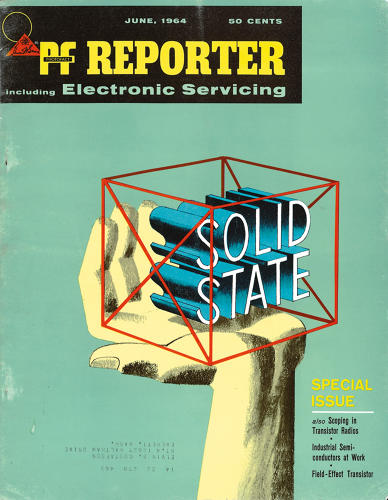
Or, never mind organic phenomena, what if all the essential elements of sand, stone, glass, (plastic) and metal that form electronic machines could be formulated and constructed to smartly dematerialize when they were no longer needed? What if you could drop a laptop into special bin that would use magnets and clean biochemical processes to disassemble all those building blocks, and distill them into measured piles and vials of raw materials for new machines?
Maybe I’ve read too much science fiction… but I’d prefer to believe that I’ve just read too much history to feel that the possibilities for the future are in any way fixed or limited. In human history–in natural history too, for that matter–epochal shifts happen sometimes “overnight” (at least in geological or historical senses), usually from the emergence of a new phenomenon that results from combined antecedents that were hidden below the surface until abruptly transformed and brought to daylight. There’s no reason to think that the dirty century of the 20th/21st centuries couldn’t experience an abrupt paradigm shift in favor of a very different kind of model.
Choose Your Muse is a series of interviews where Marc Garrett asks emerging and established artists, curators, techies, hacktivists, activists and theorists; practising across the fields of art, technology and social change, how and what has inspired them, personally, artistically and culturally.
Annie Abrahams was born in the Netherlands to a farming family in a rural village in the Netherlands. In 1978 she received a doctorate in biology and her observations on monkeys inspired her curiosity about human interactions. After leaving an academic post she trained as an artist and moved to France in 1987, where she became interested in using computers to construct and document her painting installations. She has been experimenting with networked performance and making art for the Internet since the mid 1990s. Her works have been exhibited and performed internationally at institutions such as the National Museum of Modern Art in Tokyo, New Langton Arts in San Francisco, Centre Pompidou in France, Academy of Fine Arts in Helsinki and many other venues.
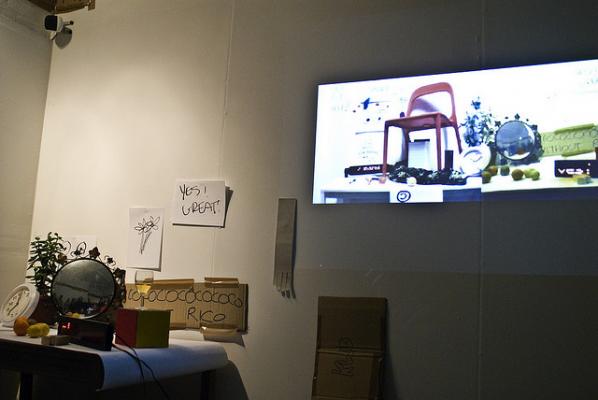
Through the years we have got to know Annie Abrahams via various online, networked artistic collaborations. In 2010, she had a her first one woman show If not you not me in the UK at Furtherfield’s earlier gallery space, the HTTP Gallery. Since then, she has shown at another mixed show at Furtherfield’s current space in Finsbury Park, London. This exhibition, Being Social included other artsists such as Karen Blissett, Ele Carpenter, Emilie Giles, moddr_ , Liz Sterry, and Thomson and Craighead.
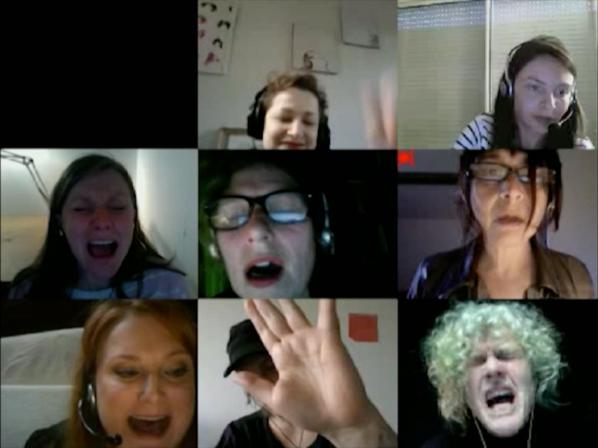
She is known worldwide for her net art and collective writing experiments and is internationally regarded as a pioneer of networked performance art. She creates situations that reveal messy and sloppy sides of human behaviour; capturing real-time moments to illucidate a reality and opening it up, making it available for thought. In an interview with Bomb Magazine in 2014 Abrahams said “My first online performance was my first HTML page. Even then I considered the Internet to be a public space, and everything that I did in that public space asked for a reaction.” [1]
Marc Garrett: Could you tell us who has inspired you the most in your work and why?
Annie Abrahams: Life itself, the people I meet. Until now my basic needs in life have hardly been threatened and so the only real problems I encountered were relational problems. Who are you? Why are you different from me? What does it mean to respect you? Is opposing you necessary? And if so, how can I do that?
MG: How have they influenced your own practice and could you share with us some examples?
AA: My practice was always based on the difficulty of having to live in a world where I don’t understand anything. Every person I meet opens up another view on this impossibility. Sometimes I write short posts about my encounters. Lately I did one on Shirley Clarke and one on Ed Atkins’ No-one is more “Work” than me. aabrahams.wordpress.com
MG: How different is your work from your influences and what are the reasons for this?
AA: My work is made from these influences. In the beginning I thought this was not ok, because I was educated with the idea that you have to be “unique” and make unique artworks. But now I am proud of my sensibility for what others say and do and the way I work with that.

MG: Describe a real-life situation that inspired you and then describe a current idea or art work that has inspired you?
AA: Last summer I made a book called from estanger to e-stranger. Ruth Catlow described it as “all-at-once instruction manual, poetry and a series of vignettes of contemporary encounters in language-less places”. There you can find ideas and art works that inspire me, but in general I am not driven by inspiration, my acts are driven by irritation, my art by incomprehension. Art works sooth, make things bearable and sometimes incite to look beyond habits. Btw I am still continuing my research on how language shapes culture, society and me. http://e-stranger.tumblr.com/
MG: What’s the best piece of advice you can give to anyone thinking of starting up in the fields of art, technology and social change?
AA: Stay close to your own concerns, to things you can have a concrete influence on, observe the results of your actions, pay attention, adapt, and always smile to your neighbour in the morning.

MG: Could you recommend any reading materials or exhibitions past or present that you think would be great for readers to view, and if so why?
AA: For years now every now and then I’ve come back to Darren O’Donnell’s book “Social Acupuncture” and always again I say to myself, “yes, you can think and act art and politics together. Please have a look at the Mammalian Diving Reflex group’s (he is their artistic director) methods. http://mammalian.ca/method/
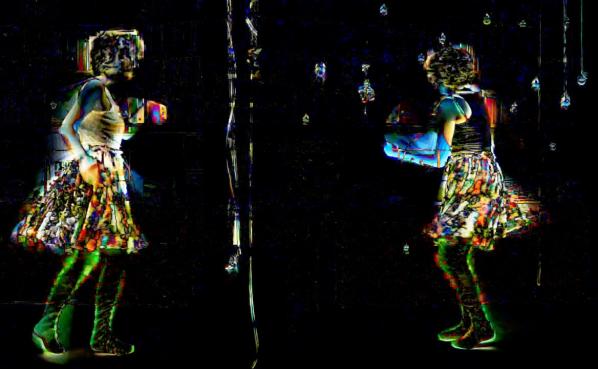
Body Drift: Butler, Hayles, Haraway (Posthumanities)
Author Arthur Kroker. University of Minnesota Press (22 Oct. 2012).
Body Drift by Arthur Kroker, takes the work of three leading women thinkers as its main focus. It therefore would feel strange, before venturing on to the review, not to mention Marilouise Kroker, his wife and collaborator who he credits with shaping the critical direction of his thought “on bodies and power.” [1] Together Marilouise and Arthur Kroker have created an abundance of work in the fields of technology and contemporary culture. They both edit the peer publishing electronic journal CTheory founded in 1996. They co-authored the influential Hacking the Future (1996), and Marilouise Kroker has co-edited and introduced numerous anthologies including Digital Delirium (1997), Body Invaders (1987), and Last Sex (1993) and Critical Digital Studies: A Reader. Marilouise Kroker is Senior Research Scholar at the University of Victoria. A recent bio written about them says “Arthur and Marilouise Kroker are the hipsters of Canadian media theory.” [2]
Arthur Kroker is Canada Research Chair in Technology, Culture and Theory, Professor of Political Science, and the Director of the Pacific Centre for Technology and Culture (PACTAC) at the University of Victoria. His recent publications include The Will to Technology and the Culture of Nihilism: Heidegger, Nietzsche, and Marx (University of Toronto Press) and Born Again Ideology: Religion, Technology and Terrorism. Dr. Kroker’s current research focuses on the new area of critical digital studies and the politics of the body in contemporary techno-culture. http://web.uvic.ca/~akroker/
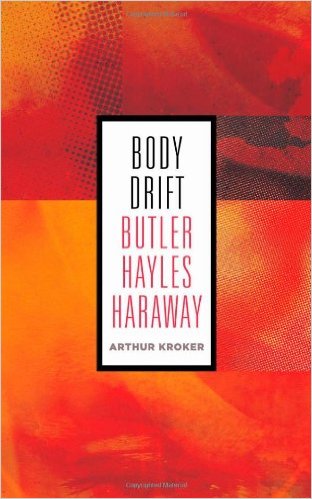
This review is written three years after the publication of the book but it feels even more relevant now than ever for reasons that will, I hope become plain…
Body Drift focuses on three major feminist theorists, Judith Butler, Katherine Hayles and Donna Haraway. They have had a deep influence on my own work and of course on media art culture through the years. They have profoundly altered our views on technology, feminism, queer theory, postmodernism, marxism, hacking, hacktivism, cybernetics, the Internet, network culture, politics and posthumaniism. Re-examining their critical perspectives and creative processes – assemblages, remixing and cyborgs- Kroker terms the emerging technological spectre body drift. He examines the connections between what he sees as Judith Butler’s postmodernism, Katherine Hayles’s posthumanism, and Donna Haraway’s companionism.
Through the spectrum of Body Drift he attempts to find a clearer understanding of the contemporary material body and its societal complexities. He views two opposing forces at work in body drift. One is, the continual disappearance of human things and values, alongside excluded ethnicities and outlawed sexualities. He connects this with an entrapment by social crisis in which actual democratic aspiration is dwindling. In parallel to this mass loss of our freedoms other factors are at work. He sees it as overall, and an eventual series and states of resistances. These are evolutionary forms of hybridity and as such are key paths for what he argues is the function of our posthuman condition. [3]
There are numerous techno-visions expounding how technology will change our lives and futures. What for me, separates a classic posthumanist and a critically aware posthumanist is that the latter is not only aware of the necessity of grass roots culture and inclusion of female voices, but is also critical of domination over others as key when engaging in the processes of innovation. Thus moving beyond existing frameworks that perpetuate patriarchal language, methods of centralization and colonial habits.
In his book You Are Not A Gadget: A Manifesto, Jaron Lanier described Ray Kurzweil’s excitement about The Singularity as apocalyptic. Lanier says “The coming Singularity is a popular belief in the society of technologists. Singularity books are as common in a computer science department as Rapture images are in an evangelical bookstore.” [4] Kurzweil’s digestible techno-bites fit well alongside big business and with Peter Diamandis a wealthy entrepreneur. Dr. Peter H. Diamandis and Dr. Ray Kurzweil co-founded the Singularity University. In To Save Everything, Click Here: Technology, Solutionism, and the Urge to Fix Problems that Don’t Exist, Evgeny Morozov writes that Diamandis “promises us a world of abundance that will essentially require no sacrifice from anyone – and since no one’s interests will be hurt, politics itself will be unnecessary.” [5]
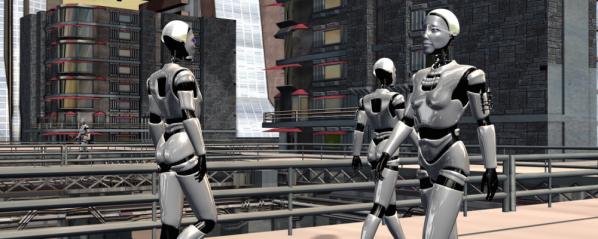
In The Joy of Revolution Ken Knabb wrote, “Marx considered it presumptuous to attempt to predict how people would live in a liberated society. “It will be up to those people to decide if, when and what they want to do about it, and what means to employ.”” [6] Kroker says, “In my estimation, while Marx, Nietzsche and Heidegger may have provided premonitory signs of the charred landscape of the technological blast, it is the specific contribution of Butler, Hayles and Haraway to provide a deeply compelling account of the fate of the body in contemporary society.” [7] This includes how we evolve our Internet freedoms, surveillance, and cyber attacks in a post-Snowden world. While we’re, either reshaping or being reshaped through the constant production of new technologies and political re-invention, it is crucial that there exists regular critique reflecting on these influences and changes on people, animals, society, the planet, and the universe. Thankfully, Butler, Hayles and Haraway disrupt the normalization and dangerously hegemonic acceptance of ‘the male overlord and his machine’ over the rest of us.
How our bodies and the idea of our bodies relate to this complex world is Kroker’s primary interest. In the introduction Kroker says that we no longer inhabit a body in any meaningful sense of the term but rather occupy a multiplicity of bodies – imaginary, sexualized, disciplined, gendered, laboring technologically augmented bodies. [8] Hayles has not only bridged the gap between science and literature, but also media art. In 2000, Hayles wrote an insightful piece on Patchwork Girl, an artwork made by Shelley Jackson in 1995, a hypertext fiction and remix of Mary Shelley’s Frankenstein. When discussing Jackson’s piece Hayles said, “As the unified subject is thus broken apart and reassembled as a multiplicity, the work also highlights the technologies that make the textual body itself a multiplicity.” [9]

Kroker says, “”Like Heidegger before her, Hayles refuses to privilege either interpretation to the exclusion of its opposite, preferring a form of thought similar to “pendurance,” that moment when, in the folded twists of complexity theory, “one comes over the other, one arrives in the other.”” [10] In an interview with Josephine Bosma on the Nettime email list, in Nov 1998, Hayles said “There may be other ways to think about the subject that don’t find themselves first and foremost on this notion of ownership. New technologies open up possibilities for rethinking other ways to begin to construct the subject.” [11] Krokers sees Hayles as providing us with the digital alphabet to explore the complexity and connections of technopoesis. “To read Hayles is, in fact, to begin to experience the fractures, bifurcations, and liminality that stretches across the skin of posthuman culture.” [12]
Donna Haraway in her introduction to A Cyborg Manifesto: Science, Technology, and Socialist-Feminism in the Late Twentieth Century, in 1985 she said, “Though both are bound in the spiral dance. I would rather be a cyborg than a goddess.” This unsettled many feminists at the time. Haraway was not interested in reclaiming what she saw as a lost ideal based on matriarchal values. Instead, she wanted women to re-invent and create their own versions of what a female could be or not be, by playfully exploiting the cyborg myth and concept in the here and now. [13] This reconstruction of the woman, Kroker says, poses particular twists and knots, and contradictions. He emphasises that we’re not discussing a traditional form of feminism but a hybrid vision of feminism. [14]
“Not waiting passively for the capricious experience of biotechnology to produce spliced bodies, Haraway has made of her own mind a biopolitics on creative hyperdrive. Deeply immersed in the (bio)scientific disciplines, always distancing herself from seductions of technological representationality by feminist difference, continuously provoking boundary breakdowns in her own thought by refusing to assent to an anthropomorphic species-heirarchy, Haraway is a theorist of the splice.” [15] Kroker (2012)
Kroker moves on from Haraway’s concepts on the cyborg to her later inter-species theory. He tries to untangle the complexity of her personal, political and theoretical relations in respect to where her critical strength is best engaged. He’s drawn to what he sees as ““Haraway’s profound conceptualization of “companion species.”” Haraway challenges the established role and hierarchical control by us humans over animals, plants, objects, and humans. [16] In her publication The Companion Manifesto: Dogs, People, And Significant Otherness, Haraway says, “I believe that all ethical relating, within or between species, is knit from the silk-strong thread of ongoing alertness to otherness-in-relation.” [17]
Haraway’s text in The Companion Manifesto conveys a shocking sense of freedom as if written by someone who longer gives a damn about her academic reputation. Perhaps, what I mean here is that the thinking reaches further than academia and builds alliances with others who may not have read her other works. In the chapter A Category of One’s own, Haraway says, “Anyone who has done historical research knows that the undocumented often have more to say about how the world is put together than do the well pedigreed.” [18] As with her concept for Situated knowledges her intention is to connect beyond officially accepted canons and norms, and established hegemonies. In his chapter HYBRIDITIES Kroker says “Haraway’s writings reveal the apocalypse that is possibly the end condition of hundreds of years of (Western) scientific experimentalism.” [19] This does not mean the West is doomed. However, Haraway has always been on the side of otherness, whether for humans or nonhuman entities. In her eyes our futures or the world as it actually is may not necessarily be as reliant on technology as we like to think.
“Perhaps most importantly, we must recognise that ethics requires us to risk ourselves precisely at moments of unknowingness, when what forms us diverges from what lies before us, when our willingness to become undone in relation to others constitutes our chance of becoming human.” [20] Judith Butler.
Of this quote from Butler’s Giving an Account of Oneself, 2005 [21], which opens the second chapter in Body Drift, Kroker says, “Could there be any text more appropriate to both understanding and perhaps, if the winds of fate are favorable, transforming contemporary politics than Judith Butler’s eloquent study of moral philosophy..?” [21] In Giving an Account of Oneself, Butler presents us with an outline for a different type of ethical practice and proposes that, before you even ask what ought I to do? Ask yourself the question who is this ‘I’? Butler, proposes that it is “a matter of necessity” that every person should “become a social theorist.” [22] Indeed, in the City Lights interview with Peter Maravelis, Kroker says Butler is speaking in terms of people breaking their silence, such as “the repetition chorus of OCCUPY during the Wall Street insurrection”. [23] And then he says, “In many ways, all of Butler’s thought is “standing as witness.” [24] Butler stands witness to what we now know in the 21st century as a violent regime of heterosexual masculinity spreading its domination over history, technology and life itself.
Butler, Hayles and Haraway are major players in feminist and queer academia and media art culture. They have all been active in breaking away from the traditional behaviours that have kept us caught within loops in various ways. Their fluid and progressive approaches to feminism are not only of value to women alone but it can also help others think beyond restrictive behaviours. Kroker’s book manages to reflect the fluidity of networked and contemporary aspects of body drift well, especially from a critically aware, posthumanist perspective. However, no matter how you slice it, it’s about personal and collective freedoms, how we can somehow reclaim our states of being, and how we can own our subjectivities and our psyches in whatever forms these may take. As artists, as humans and or as posthumans – we need Butler, Hayles and Haraway to guide us through this ever-changing, twisting, everyday, posthuman terrain.
Choose Your Muse is a new series of interviews where Marc Garrett asks emerging and established artists, curators, techies, hacktivists, activists and theorists; practising across the fields of art, technology and social change, how and what has inspired them, personally, artistically and culturally.
Jeremy Bailey is a Toronto based Famous New Media Artist. Recent projects include performances for Rhizome’s Seven on Seven in New York, The Stedelijk Museum in Amsterdam and Tate Liverpool. Recent exhibitions include solo exhibitions at Transmediale in Berlin, and group exhibitions at Mediamatic in Amsterdam, Museums Quartier in Vienna and Balice Hertling in Paris. Recent commissions include projects for FACT in Liverpool, Turner Contemporary in Margate UK, and The New Museum in New York.
Marc Garrett: Could you tell us who has inspired you the most in your work and why?
Jeremy Bailey: Many have inspired my work but likely the most inspiring has been Canadian video performance artist Colin Campbell. He introduced me to video art and video art history as a young university student in Toronto. He made work that was funny, that lampooned the art world and somehow also made art more relevant to my young eyes. Looking back much of what I aspire to do today is directly reflective of what Colin exposed me to so early on.
MG: How have they influenced your own practice and could you share with us some examples?
JB: Absolutely, in my own work I’m often self deprecatingly self reflective of the absurd circumstances and pathos of a new media artist eking out a career against all odds.
One of my all time favourite videos by Colin Campbell is Sackville I’m Yours, in it he plays a small town art celebrity named “Art Star” who conducts a hilariously pathetic mock interview of himself.
https://www.youtube.com/watch?v=oKEzRWgih78
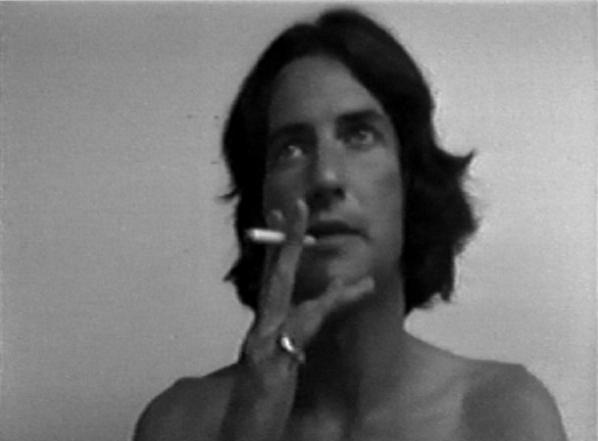
MG: How different is your work from your influences and what are the reasons for this?
JB: My video performance work differs from Colin’s because it was created as video for the Internet where his work was created in the 70s, 80s and 90s, a time where all video ended up on a TV monitor. This is an important distinction, because a lot of early video art was positioned in dialogue with the history of television. The personal narrative, the idea of a non celebrity on TV, that was a new idea. In contrast the Internet was designed from the very beginning to be accessible platform for self expression and distribution. Growing up with the Internet I can remember always feeling like anyone could be famous. No matter how niche or weird you were there was always an audience on the internet. Before I was an artist I was actually known online as a skin designer. Skins were these custom interfaces you could add to your software, usually music software, to make it your own. You can still see my skin designs from that era here http://sblcommunications.com/jbd/
MG: Is there something you’d like to change in the art world, or in fields of art, technology and social change; if so, what would it be?
JB: Yes, I’d like art to reflect positive social change instead of reflecting negative market demands. Artists have this tremendous ability and power to communicate and many are wasting that talent pandering to the decorating desires of the rich and powerful. I understand that everyone needs to make a living, but we also have a responsibility as artists to help make the world a better place. I also don’t see why these two things need to be in conflict.
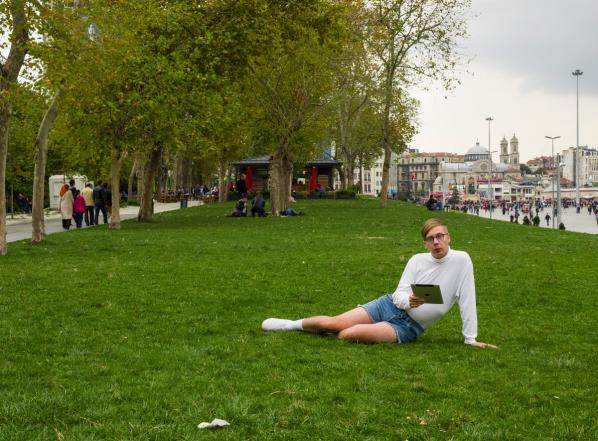
Above image from The You Museum. It was “conceived of in Istanbul during a memorable residency at The Moving Museum that resulted in an exhibition you can read a review of here. The You Museum was inspired by Istanbul’s Gezi Park protests, and the ongoing debates and conflations of public and private entities and spaces in Turkey and abroad (notably by organizations such as the NSA)”
MG: Describe a real-life situation that inspired you and then describe a current idea or art work that has inspired you?
JB: Nearly all of my work is inspired by real life, I often reflect my actual circumstance in my work. My process usually involves searching for a problem and then satirically using technology to solve it poorly. In doing this I usually uncover other problems that run deeper than the initial surface issues. For example I was once invited to do a residency in an impoverished town in the Ukraine where I discovered an unpopular but bureaucratically permanent statue of Stalin in the town square. To help solve the problem of a permanent and unpopular statue I created software that allowed anyone to easily create their own wearable public sculpture that they could change anytime by screaming. This admitedly pathetic solution allowed me to navigate a number of other issues, everything from my family history to the role of art in relation to capital to the subjectivity of historical document. I’m always feeding off and reflecting the world around me. Reality is so much crazier and more interesting than anything I could invent.
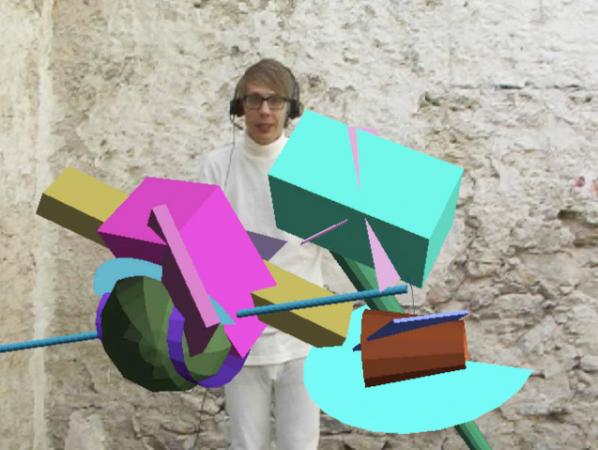
MG: What’s the best piece of advice you can give to anyone thinking of starting up in the fields of art, technology and social change?
JB: This one is obvious, but hard to follow. Don’t be afraid to fail. Failing will help you learn and grow to be a better artist tomorrow. No one ever remembers your failures as well as you do – especially when your new work is good.
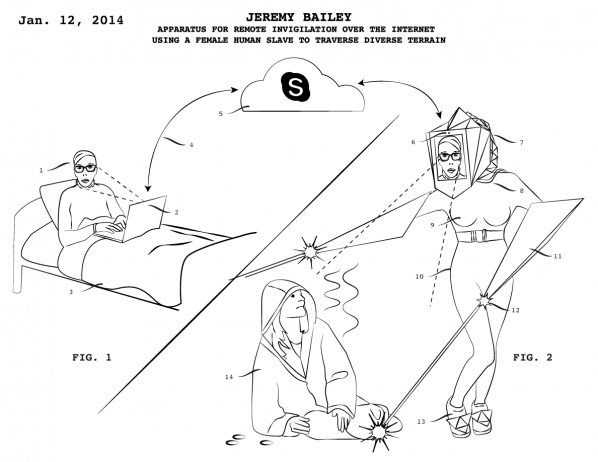
MG: Finally, could you recommend any reading materials or exhibitions past or present that you think would be great for the readers to view, and if so why?
JB: I’m reading a book today called To Save Everything Click Here by Evegeny Morozov about our culture’s obsession with technology as a go to solution for the world’s problems. Most of my work is about this very human hope that someone else has solved or will solve our problems, and many of us believe those people work in technology companies. That’s simply not true. In the book Morozov coins the term Solutionism to describe this mentality. Much of my own work could be called solutionist satire I guess, but the bottom line is we’re all capable of being a part of the solution, of making the world around us better. Ideology, good ideas, have done more to change our world for the better than any technology ever will.

J. R. Carpenter reviews A Geology of Media, the third, final part of the media ecology-trilogy. It started with Digital Contagions: A Media Archaeology of Computer Viruses (2007) and continued with Insect Media (2010). It focuses beyond machines and technologies onto the chemistry and geological materials of media, from metals to dust.
Humans are a doubly young species — we haven’t been around for long, and we don’t live for long either. We retain a fleeting, animal sense of time. We think in terms of generations – a few before us, a few after. Beyond that… we can postulate, we can speculate, we can carbon date, but our intellectual understanding of the great age of the earth remains at odds with our sensory perception of the passage of days, seasons, and lifetimes.
The phrase ‘deep time’ was popularised by the American author John McPhee in the early 1980s. McPhee posits that we as a species may not yet have had time to evolve a conception of the abyssal eons before us: “Primordial inhibition may stand in the way. On the geologic time scale, a human lifetime is reduced to a brevity that is too inhibiting to think about. The mind blocks the information”1. Enter the creationists and climate change deniers, stage right. On 28 May 2015 the Washington Post reported that a self-professed creationist from Calgary found a 60,000-million-year-old fossil, which did nothing to dissuade him of his religious beliefs: “There’s no dates stamped on these things,” he told the local paper.2
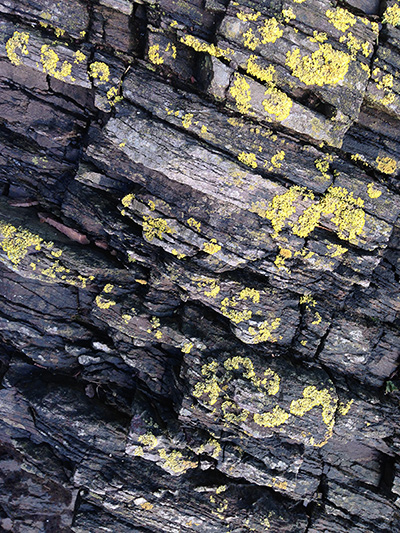
In the late 15th-century, Leonardo Da Vinci observed fossils of shells and bones of fish embedded high in the Alps and privately mused in his notebooks that the theologians may have got their maths wrong. The notion that the earth was not mere thousands but rather many millions of years old was first put forward publicly by the Scottish physician turned natural scientist James Hutton in Theory of the Earth, a presentation made to the Royal Society of Edinburgh in 1785 and published ten years later in two massive volumes3. It is critical to note that among Hutton’s closest confidants during the formulation of this work were Joseph Black, the chemist widely regarded as the discoverer of carbon dioxide, and the engineer James Watt, whose improvements to the steam engine hastened the Industrial Revolution in Great Britain. Geology emerged as a discipline on the eve of a period of such massive social, scientific, economic, political, and environmental change that it precipitated what many modern geologists, ecologists, and prominent media theorists are now categorising as a new geological epoch, the Anthropocene. As Nathan Jones recently wrote for Furtherfield: “The Anthropocene… refers to a catastrophic situation resulting from the actions of a patriarchal Western society, and the effects of masculine dominance and aggression on a global scale.”4
In his latest book, A Geology of Media (2015)5, Finnish media theorist Jussi Parikka turns to geology as a heuristic and highly interdisciplinary mode of thinking and doing through which to address the complex continuum between biology and technology presented by the Anthropocene. Or the Anthrobscene, as Parikka blithely quips. In putting forward geology as a methodology, a conceptual trajectory, a creative intervention, and an interrogation of the non-human, Parikka argues for a more literal understanding of ‘deep time’ in geological, mineralogical, chemical, and ecological terms. Whilst acknowledging the usefulness of the concepts of anarachaeology and varientology put forward by Siefried Zielinski in Deep Time of the Media (2008)6, Parikka calls for an even deeper time of the media — deeper in time and in deeper into the earth.
In Theory of the Earth, Hutton referred to the earth as a machine. He argued: “To acquire a general or comprehensive view of this mechanism of the globe… it is necessary to distinguish three different bodies which compose the whole. These are, a solid body of earth, an aqueous body of sea, and an elastic fluid of air.”13 Of the machine-focused German media theorists, Parikka demands – what is being left out? “What other modes of materiality deserve our attention?”7 Parikka proposes the term ‘medianatures’ — a variation on Donna Haraway’s ‘naturecultures’8 — as a term through which to address the entangled spheres and sets of practices which constitute both media and nature. Further, Parikka reintroduces aspects of Marxist materialism to Friedrich Kittler’s media materialist agenda, relentlessly re-framing the production, consumption, and disposal of hardware in environmental, political, and economic contexts, and raising critical social questions of energy consumption, labour exploitation, pollution, illness, and waste.
Drawing upon Deleuze and Guattari’s formulation of a ‘geology of morals’9, Parikka writes: “Media history conflates with earth history; the geological materials of metals and chemicals get deterritorialized from their strata and reterritorialized in machines that define our technical media culture”10. Within this geologically inflected materialism, a history of media is also a history of the social and environmental impact of the mining, selling, and consuming of coal, oil, copper, and aluminium. A history of media is also a history of research, design, fabrication, and the discovery of chemical processes and properties such as the use of gutta-percha latex for use the insulation of transatlantic submarine cables, and the extraction of silicon for use in semiconductor devices. A history of the telephone is entwined with that of the copper mine. How can we possibly think of the iPhone as more sophisticated than the land line when we that know that beneath its sleek surface – polished by aluminium dust – the iPhone runs on rare earth minerals extracted by human bodies labouring in deplorable conditions in open-pit mines?

Jussi Parikka is a professor in technological culture and aesthetics and Winchester School of Art. Although his his definition of media remains rooted in the disciplinary discourses of media studies, media theory, media history, and media art, he advocates for and indeed actively engages in an interdisciplinary approach to media theory. He cites a number of excellent examples from contemporary media art, not as illustrations of his arguments but rather as guides to his thinking. He also draws upon a wide range of other references from visual art, science, literature, psychogeography, philosophy, and politics. This overtly interdisciplinary approach to media theory provides a number of intriguing openings for readers, scholars, and practitioners in adjacent fields to consider. For example, Parikka’s evocation of Robert Smithson’s formulation of ‘abstract geology’11 in relation to land art invites further explication of the connection between land art, sculpture, and the geology of sculptural media. For thousands of years sculptors have practised a geology of media, making and shaping clay, quarrying and carving stone, and smelting, melting, and casting metal. Further, Parikka’s discussion of the pictorial content of a number of paintings in the context of this book invites the consideration of the geology of paint as a medium, entwined with the elemental materiality of cadmium, titanium, cobalt, ochre, turpentine, graphite, and lead.
Media is a concept in crisis. As it travels across scientific, artistic, and humanistic disciplines it confuses and confounds boundaries between what media is and what media does in a wide range of contexts. This confusion signposts the need for new vocabularies. If geology has taught us anything, it’s that this too will take time. In endeavouring to explain how it happens that flames sometimes shoot out through the throat of Mount Etna, the Epicurian poet Lucretius (c. 100 – c. 55 BC) wrote: “You must remember that the universe is fathomless… If you look squarely at this fact and keep it clearly before your eyes, many things will cease to strike you as miraculous.”12 So too, Parikka prods us to think big, to get past our primordial inhibitions, to look beyond mass media consumerism to what I shall call a ‘massive media’ – a conception of media operating on a global and geological scale. A Geology of Media is a green book, overtly ecological. In his call for a further materialisation of media theory through a consideration of the media of earth, sea, and air Parikka has put forward an assemblage of material practices indispensable to any discussion of the mediatic relations of the Anthropocene.
Daniel Rourke: At Furtherfield on November 22nd 2014 you launched a Beta version of a networked project, 6PM Your Local Time, in collaboration with Fabio Paris, Abandon Normal Devices and Gummy Industries. #6PMYLT uses twitter hashtags as a nexus for distributed art happenings. Could you tell us more about the impetus behind the project?
Domenico Quaranta: In September 2012, the Link Art Center launched the Link Point in Brescia: a small project space where, for almost two years, we presented installation projects by local and international artists. The Link Point was, since the beginning, a “dual site”: a space where to invite our local audience, but also a set for photographic documentation meant to be distributed online to a global audience. Fabio Paris’ long experience with his commercial gallery – that used the same space for more than 10 years, persuaded us that this was what we had to offer to the artists invited. So, the space was reduced to a small cube, white from floor to ceiling, with neon lights and a big logo (a kind of analogue watermark) on the back door.
Thinking about this project, and the strong presence of the Link Point logo in all the documentation, we realized that the Link Point was actually not bound to that space: as an abstract, highly formalized space, it could actually be everywhere. Take a white cube and place the Link Point logo in it, and that’s the Link Point.
This realization brought us, on the one hand, to close the space in Brescia and to turn the Link Point into a nomad, erratic project, that can resurrect from time to time in other places; and, on the other hand, to conceive 6PM Your Local Time. The idea was simple: if exhibition spaces are all more or less similar; if online documentation has become so important to communicate art events to a wider audience, and if people started perceiving it as not different from primary experience, why not set up an exhibition that takes place in different locations, kept together only by documentation and by the use of the same logo? All the rest came right after, as a natural development from this starting point (and as an adaptation of this idea to reality).
Of course, this is a statement as well as a provocation: watching the documentation of the UK Beta Test you can easily realize that exhibition spaces are NOT more or less the same; that attending or participating in an event is different from watching pictures on a screen; that some artworks work well in pictures but many need to be experiences. We want to stress the value of networking and of giving prominence to your network rather than to your individual identity; but if the project would work as a reminder that reality is still different from media representation, it would be successful anyway.
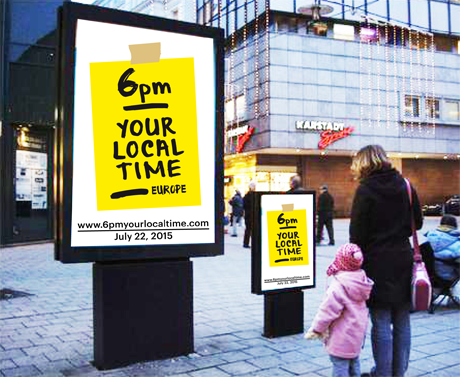
Daniel Rourke: There is something of Hakim Bey’s Temporary Autonomous Zones in your proposal. The idea that geographic, economic and/or political boundaries need no longer define the limits of social collective action. We can criticise Bey’s 1991 text now, because in retrospect the Internet and its constitutive protocols have themselves become a breeding ground for corporate and political concerns, even as technology has allowed ever more distributed methods of connectivity. You foreground network identity over individual identity in the 6PM YLT vision, yet the distinction between the individuals that create a network and the corporate hierarchies that make that networking possible are less clear. I am of course gesturing towards the use of Twitter as the principal platform of the project, a question that Ruth Catlow brought up at the launch. Do you still believe that TAZs are possible in our hyper-connected, hyper-corporate world?
Domenico Quaranta: In its first, raw conceptualization, 6PM YLT had to come with its own smartphone app, that had to be used both to participate in the project and to access the gallery. The decision to aggregate content published on different social platforms came from the realization that people already had the production and distribution tools required to participate in the action, and were already familiar with some gestures: take a photo, apply a filter, add an hashtag, etc. Of course, we could invite participants and audiences to use some specific, open source social network of our choice, but we prefer to tell them: just use the fucking platform of your choice. We want to facilitate and expand participation, not to reduce it; and we are not interested in adding another layer to the project. 6PM YLT is not a TAZ, it’s just a social game that wants to raise some awareness about the importance of documentation, the power of networks, the public availability of what we do with our phones. And it’s a parasitic tool that, as anything else happening online, implies an entire set of corporate frameworks in order to exist: social networks, browsers, operative systems, internet providers, server farms etc.
That said, yes, I think TAZs are still possible. The model of TAZ has been designed for an hyper-connected, hyper-corporate world; they are temporary and nomadic; they exist in interstices for a short time. But I agree that believing in them is mostly an act of faith.
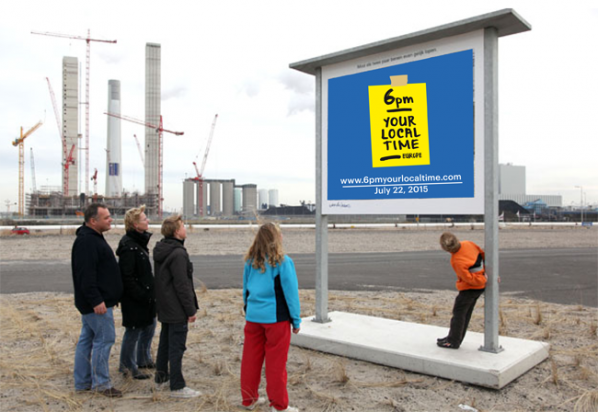
Daniel Rourke: The beta-tested, final iteration of 6pm YLT will be launched in the summer of 2015. How will you be rolling out the project in the forthcoming months? How can people get involved?
Domenico Quaranta: 6PM Your Local Time has been conceived as an opportunity, for the organizing subject, to bring to visibility its network of relationships and to improve it. It’s not an exhibition with a topic, but a social network turned visible. To put it simply: our identity is defined not just by what we do, but also by the people we hang out with. After organizing 6PM Your Local Time Europe, the Link Art Center would like to take a step back and to offer the platform to other organizing subjects, to allow them to show off their network as well.
So, what we are doing now is preparing a long list of institutions, galleries and artists we made love with in the past or we’d like to make love with in the future, and inviting them to participate in the project. We won’t launch an open call, but we already made the event public saying that if anyone is interested to participate, they are allowed to submit a proposal. We won’t accept anybody, but we would be happy to get in touch with people we didn’t know.
After finalizing the list of participants, we will work on all the organizational stuff, basically informing them about the basic rules of the game, gathering information about the events, answering questions, etc.
On the other hand, we have of course to work on the presentation. While every participant presents an event of her choice, the organizer of a 6PM Your Local Time event has to present to its local audience the platform event, as an ongoing installation / performance. We are from Brescia, Italy, and that’s where we will make our presentation. We made an agreement with MusicalZOO, a local festival of art and electronic music, in order to co-produce the presentation and have access to their audience. This is what determined the date of the event in the first place. Since the festival takes place outdoor during the summer, we are working with them on designing a temporary office where we can coordinate the event, stay in touch with the participants, discuss with the audience, and a video installation in which the live stream of pics and videos will be displayed. Since we are expecting participants from Portugal to the Russian Federation, the event will start around 5 PM, and will follow the various opening events up to late night.
One potential reference for this kind of presentation may be those (amazing) telecommunication projects that took place in the Eighties: Robert Adrian’s The World in 24 Hours, organized at Ars Electronica in 1982; the Planetary Network set up in 1986 at the Venice Biennale; and even Nam June Paik’s satellite communication project Good Morning Mr Orwell (1984).
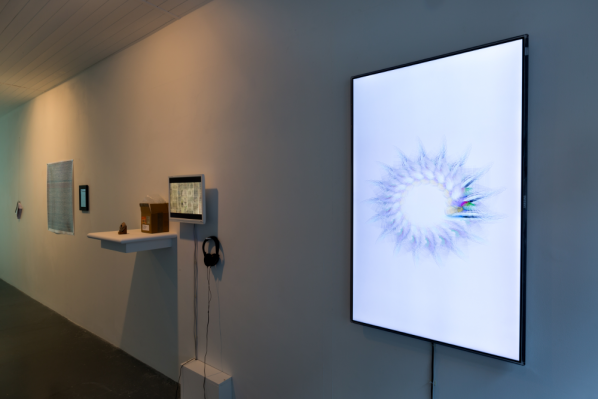
Daniel Rourke: Your exhibition Unoriginal Genius, featuring the work of 17 leading net and new media artists, was the last project to be hosted in the Carroll/Fletcher Project Space (closing November 22nd, 2014). Could you tell us more about the role you consider ‘genius’ plays in framing contemporary art practice?
Domenico Quaranta: The idea of genius still plays an important role in Western culture, and not just in the field of art. Whether we are talking about the Macintosh, Infinite Jest, a space trip or Nymphomaniac, we are always celebrating an individual genius, even if we perfectly know that there is a team and a concerted action behind each of these things. Every art world is grounded in the idea that there are gifted people who, provided specific conditions, can produce special things that are potentially relevant for anybody. This is not a problem in itself – what’s problematic are some corollaries to our traditional idea of genius – namely “originality” and “intellectual property”. The first claims that a good work of creation is new and doesn’t depend on previous work by others; the second claims that an original work belongs to the author.
In my opinion, creation never worked this way, and I’m totally unoriginal in saying this: hundreds of people, before and along to me, say that creating consists in taking chunks of available material and assembling them in ways that, in the best situation, allow us to take a small step forward from what came before. But in the meantime, entire legal systems have been built upon such bad beliefs; and what’s happening now is that, while on the one hand the digitalization of the means of production and dissemination allow us to look at this process with unprecedented clarity; on the other hand these regulations have evolved in such a way that they may eventually slow down or stop the regular evolution of culture, which is based on the exchange of ideas.
We – and creators in particular – have to fight against this situation. But Unoriginal Genius shouldn’t be read in such an activist way. It is just a small attempt to show how the process of creation works today, in the shared environment of a networked computer, and to bring this in front of a gallery audience.
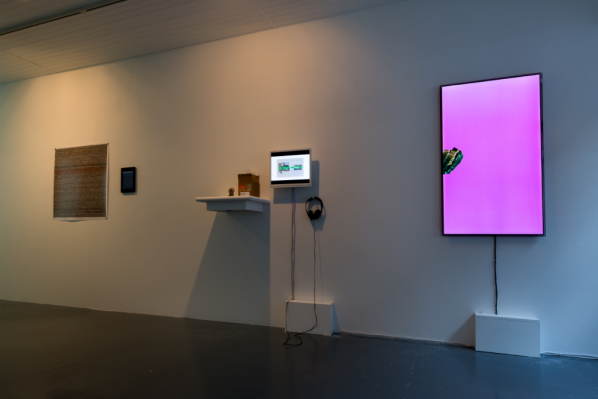
Daniel Rourke: So much online material ‘created’ today is free-flowing and impossible to trace back to an original author, yet the tendency to attribute images, ideas or ‘works’ to an individual still persists – as it does in Unoriginal Genius. I wonder whether you consider some of the works in the show as more liberated from authorial constraints than others? That is, what are the works that appear to make themselves; floating and mutating regardless of particular human (artist) intentions?
Domenico Quaranta: Probably Museum of the Internet is the one that fits best to your description. Everybody can contribute anonymously to it by just dropping images on the webpage; the authors’ names are not available on the website, and there’s no link to their homepage. It’s so simple, so necessary and so pure that one may think that it always existed out there in some way or another. And in a way it did, because the history of the internet is full of projects that invite people to do more or less the same.
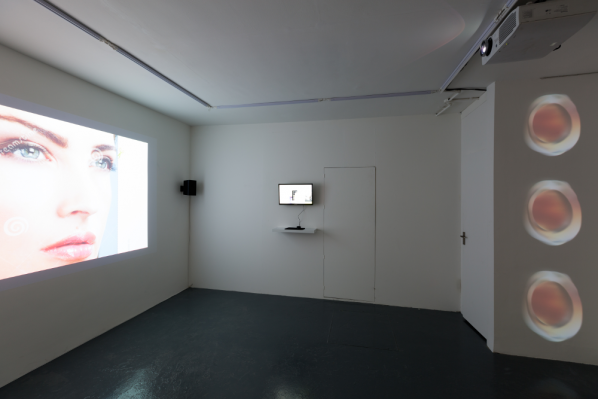
Daniel Rourke: 2014 was an exciting year for the recognition of digital art cultures, with the appointment of Dragan Espenschied as lead Digital Conservator at Rhizome, the second Paddles On! auction of digital works in London, with names like Hito Steyerl and Ryan Trecartin moving up ArtReview’s power list, and projects like Kenneth Goldsmith’s ‘Printing out the Internet’ highlighting the increasing ubiquity – and therefore arguable fragility – of web-based cultural aggregation. I wondered what you were looking forward to in 2015 – apart from 6PM YLT of course. Where would you like to see the digital/net/new media arts 12 months from now?
Domenico Quaranta: On the moon, of course!
Out of joke: I agree that 2014 has been a good year for the media arts community, as part of a general positive trend along the last few years. Other highlighs may include, in various order: the September 2013 issue of Artforum, on “Art and Media”, and the discussion sparked by Claire Bishop’s essay; Cory Arcangel discovering and restoring lost Andy Warhol’s digital files from floppy disks; Ben Fino-Radin becoming digital conservator at MoMA, New York; JODI winning the Prix Net Art; the Barbican doing a show on the Digital Revolution with Google. Memes like post internet, post digital and the New Aesthetic had negative side effects, but they helped establishing digital culture in the mainstream contemporary art discourse, and bringing to prominence some artists formerly known as net artists. In 2015, the New Museum Triennial will be curated by Lauren Cornell and Ryan Trecartin, and DIS has been announced to be curator of the 9th Berlin Biennial in 2016.
All this looks promising, but one thing that I learned from the past is to be careful with optimistic judgements. The XXI century started with a show called 010101. Art in Technological Times, organized by SFMoMA. The same year, net art entered the Venice Biennale, the Whitney organized Bitstreams and Data Dynamics, the Tate Art and Money Online. Later on, the internet was announced dead, and it took years for the media art community to get some prominence in the art discourse again. The situation now is very different, a lot has been done at all levels (art market, institutions, criticism), and the interest in digital culture and technologies is not (only) the result of the hype and of big money flushed by corporations unto museums. But still, where we really are? The first Paddles On! Auction belongs to history because it helped selling the first website ever on auction; the second one mainly sold digital and analogue paintings. Digital Revolution was welcomed by sentences like: “No one could fault the advances in technology on display, but the art that has emerged out of that technology? Well, on this showing, too much of it seems gimmicky, weak and overly concerned with spectacle rather than meaning, or making a comment on our culture.” (The Telegraph) The upcoming New Museum Triennial will include artists like Ed Atkins, Aleksandra Domanovic, Oliver Laric, K-HOLE, Steve Roggenbuck, but Lauren and Ryan did their best to avoid partisanship. There’s no criticism in this statement, actually I would have done exactly the same, and I’m sure it will be an amazing show that I can’t wait to see. Just, we don’t have to expect too much from this show in terms of “digital art recognition”. So, to put it short: I’m sure digital art and culture is slowly changing the arts, and that this revolution will be dramatic; but it won’t take place in 2015 🙂
AS FOUNDER/DIRECTOR OF THE MEDIA ARCHEOLOGY LAB IN COLORADO, LORI EMERSON HAS (since 2009) been surrounding herself with “dead” media technologies in order to help make sense of (and critique) today’s much-hyped alive ones. Being also a scholar and critic of contemporary poetics, she is keenly aware of how such devices are equipped to influence and constrain our writing/thinking.
Emerson’s work celebrates and calls for a “frictional media archeological analysis” aimed at the continual “unmooring” of the accepted conventions of reading and writing. Towards this end, she critiques consumer-oriented trends in computing–trends which unfortunately seek to “efface the interface” in the name of so-called user-friendliness. Montgomery Cantsin conducted the following interview by email upon the release of Lori’s new book, Reading Writing Interfaces (recently published by University of Minnesota Press).
Montgomery Cantsin: First, I want to point out that your new book is part of a series which was founded by Mark Poster, who passed away not too long ago. Can you talk about how your work fits into his “Electronic Mediations” series and what (if any) influence Poster has had on you?
Lori Emerson: Mark Poster has been an underlying, though subtle, influence on my work as I first read him in a graduate seminar I took on “cybercultures” in the mid- to late-90s with the Victorianist and early hypertext theorist Christopher Keep. That class and Poster’s work–his deeply political readings of digital media structures–stayed with me long afterwards. In fact, about seventeen years ago I gave a presentation on “Postmodern Virtualities” in that class and while I have no memory at all of what I said or even what I learned from reading his work back then, it’s remarkable that his opening sentence rings so true to the kind of work I now find myself doing–he writes that “a critical understanding of the new communications systems requires an evaluation of the type of subject it encourages, while a viable articulation of postmodernity must include an elaboration of its relation to new technologies of communication.” And so the point at which I realized I was, to my surprise, writing a political book that meshed together poetics and media studies was the point at which I realized that my work would likely fit in best (or, given its reputation in media studies, I wanted to make my work fit in) with the Electronic Mediations series, especially because of their books on tactical media, glitch and error, as well as the politics of archives and networks. It’s such a thrill and an honor to have my book included in that series.
MC: How did your Media Archeology Lab come about?
LE: I was fortunate enough to have the support of the past director of the Alliance for Technology, Learning, and Society when I was first hired here at the University of Colorado at Boulder in 2008. In 2009, the director, John Bennett, offered me a $20,000 startup grant to build a lab, any lab, that Atlas and English Department students could both use. I then began looking for a way to build a lab that wasn’t just another venue on campus to celebrate the perpetual new in computing and, since I was at the time fascinated with how the Canadian poet bpNichol wrote one of the first kinetic digital poems, “First Screening,” in 1983 using Basic on an Apple IIe, I decided to create a lab that had enough Apple IIe’s to teach bpNichol in a classroom full of 20 English majors. It didn’t take long before I moved on to acquiring Commodore 64’s and then to where we find ourselves now, with a collection of about a thousand pieces of still functioning hardware and software from the mid-1970s to the early 2000s. I also have to admit that the MAL wouldn’t be what it is now if we weren’t flying under the radar of the university for the first three years or so. The relative obscurity of the lab in those early years meant that we had little to no oversight, no one to report to, no metrics or outcomes to adhere to, and so on which meant we were free to be as wild as we wanted.
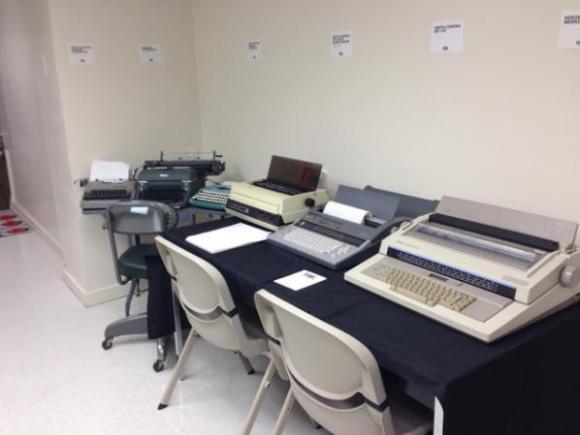
MC: In trying to explain your book to a friend, I admit I had some difficulty. I found that it was (for me) hard to do without making the subject of the book sound obscure. And yet I feel that the issues raised in the book are actually quite significant/fundamental. …Let’s delve right into the concept of the interface. As you point out, digital interfaces are now being made “invisible” by manufacturers in the name of “naturalness,” and so it is hard now to even point to a modern interface and say “this is an interface.” At one point you quote Alexander Galloway, who defines an interface as a “point of transition.” (In other words it is a sort of boundary?) You also quote Johanna Drucker, who says that a book can qualify as an interface!? …Is it useful here to ask what’s NOT an interface??!
LE: I think that, similar to Marshall McLuhan’s notion of ‘medium’ which he even extended to roads (and then had to endure a couple decades of ridicule from academics), interface can indeed be anything that’s an intermediary between a human user or creator and what is being created. But unlike using ‘medium’, ‘interface’ seems to allow us to focus our thinking on the particular affordances of specific intermediary structures. It’s not especially unusual or even useful to point out that paper is a medium but, by contrast, calling it an interface summons up not only the material qualities of paper (the grain, size, texture, limits and possibilities for inscription) but also pens and pencils along with that crucial point of interaction that’s between–between writer or artist and their materials. But I also suspect that some of the significance of the concept as I’m using is lost when you start from an arbitrary point in the past and think about needles as interfaces for needlework, or rocks as interfaces for etchings or engravings. Instead, ‘interface’ gains traction when we use contemporary notions of it to have a see-saw relationship between present and past–reading contemporary interfaces through past interfaces and vice-versa. In this way, my book is resolutely of the present because I tend not to delude myself into thinking I can have a pure, direct access to the past. Instead, I start with the closed interfaces of the present moment whose manufacturers try to convince us that a closed device is the only way for us to have a supposedly “natural,” “intuitive,” “seamless” experience with our digital devices; I then work my way back in time to reread typewriters and fascicles or handmade books as profoundly open and configurable interfaces but still with their own limitations.
MC: I was delighted to see that the first scholarly name you drop into your text is that of the amazingly awesome Florian Cramer, the second-wave Neoist. You say he importantly identified eight different types of interfaces. Of these eight, the type that you identify as being of particular interest to you is the “human-to-hardware” interface?
LE: I’m interested in thinking about how certain (largely profit-driven) decisions about interfaces for human-computer-interaction fundamentally affect the human user–determining their access to information along with what and how they’re able to create. This uneven distribution of power between user and digital computer is most obvious when we start to think about why the keyboard/screen/mouse interface has become the only way for us to interact with our machines or when we look at the history of how a particular notion of the Graphical User Interface was used to advance an ideology of the user-friendly. While I am obviously quite dedicated to certain aspects of media archaeology that believe in the value of looking at the operational undersides of machines and the ways in which these machines can now operate quite independently of humans, in Reading Writing Interfaces I’m most concerned with how humans are now almost totally unable to think outside of the current dominant paradigm in computing. This is why I’m less interested in hardware-to-hardware configurations and more interested in the space between human and hardware–as well as software.
MC: I like how you point out that the closed interface can be a sort of metaphor for ideology (‘that which we are not aware of’). This part of the book blew my mind and I’d love it if you could expand on this here.
LE: I’m fast and loose with how I use ‘ideology’ but, after going through every issue of Byte magazine from the late 70s through the mid-1980s after the release of the Apple Macintosh–mostly just to see what I’d find–I became convinced not even that contemporary computing interfaces are metaphors for ideology but that they are themselves expressions of an ideology. Somehow what was at first a battle between competing philosophies in the 1970s–between a model of computing based on openness and a model of computing based on a closed interface for the sake of a very particular notion of user friendliness–gradually turned into an all-out marketing campaign by Apple that was so successful users/consumers are barely even aware of other possible versions of computing. These closed interfaces have become so familiar, so accepted as the so-called ‘natural’ way for users to access their computers, that we are mostly utterly unable to imagine any other alternative. Over and over again, we’re told: “Computers are only getting easier, more intuitive, more natural to use!” Or so the story goes, until you either try to understand how exactly our digital devices work. Or until you try to create outside of a corporation’s rigid developer guidelines. Or until you come up against the impossibility of working with a closed device whose “seamless,” “natural,” “intuitive” user interface doesn’t in any way conform to your own sense of nature or intuition and can’t be rebuilt, remade, or reassembled in your own image because in computing words like “seamless” and “natural” are code for “closed.”
Something I’d love to research more is how this ideology of invisibility is not a reflection of a particular aspect of capitalism (as I thought when I wrote Reading Writing Interfaces) but is actually one of the key underpinnings of a capitalist economy. I recently learned from reading Kirstyn Leuner‘s dissertation that the diorama–which emerged in the 1820s in Paris not coincidentally at the same time as early industrial capitalism began to get its legs (and only twenty years before Marx would move to Paris and begin formulating Capital)–was also produced and marketed as a “magical” device whose inner workings were kept hidden from viewers in the interests of providing an immersive experience. But I admit this is all just a hunch.
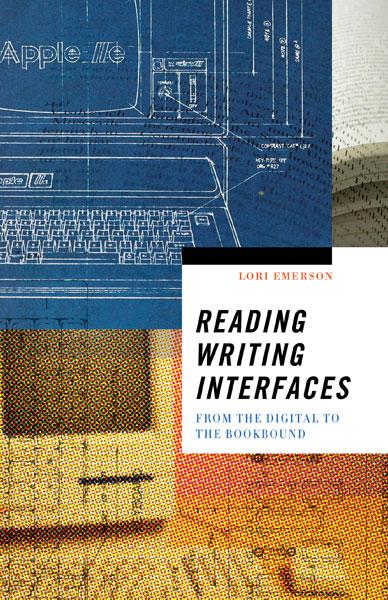
MC: The Situationists called for a seizing of the “means of conditioning.” Should we also aim to seize the means of programming? And what connections might we draw between these two projects?
LE: As I try to imply above, contemporary computing is one of the most profound manifestations of late capitalism–I only have a superficial understanding of the Situationists but, ultimately, the only reason why our devices are now not only closed to us but gradually disappearing under the guise of ‘seamlessness’ is because, from a profit-oriented perspective, a universal homogeneity of devices is the ideal; and now, to accelerate that homogeneity, these devices must also be invisible. It does seem to me that the way out is to hack, appropriate, seize, rebuild in our own image. The only problem is that even ‘hacking’ and ‘making’ have become big business, as Make Magazine and all its spin-off projects (Maker Faire, Craft Magazine, Maker Television etc.) continue to be enormously profitable and as mega corporations such as Google and Facebook hire hackers and even hire Occupy Wall Street activists. Nonetheless, I have a tremendous amount of respect for utterly unprofitable experiments in taking control of our technology–I’ve begun working on my next project I’m calling OTHER NETWORKS which looks at networks that exist outside of or before that behemoth “the internet” came to dominate our online interactions. One project in particular, Occupy.Here, seems to fit in nicely as a Situationist-inspired seizing of the means of programming in that it is a network that exists entirely outside of the internet via a wifi router near Zuccotti Park in New York City which anyone with a smartphone or laptop can access through a portal website. In other words, it offers us a beautifully simple, elegant way out of the way the internet disempowers us through a system of distributed control.
MC: It used to be that people could take apart and reassemble the mechanical devices in their lives (toasters for example), and these devices were constructed with universal parts (screws, etc) …How can the tinkering impulse survive in the face of smart devices, blackboxing, proprietary components, etc.? (Maybe not everyone is a tinkerer, but…)
LE: I’ve wondered the same thing but projects such as Occupy.Here and devices such as Raspberry Pi (that are as inexpensive as a book) or platforms such as Arduino that are meant to help us build other devices give me hope. But also I think it’s important to remember this blackboxing is largely (but of course not only) driven by Apple and that, as I’ve come to learn, this tinkering impulse is alive and well in countries outside of the U.S. For example, I recently met a graduate student from Israel who assured me that nearly all of her friends and family members living in Israel used PCs or Linux devices and everyone regularly takes apart and fixes their machines. This was quite a revelation to me, to realize that the overwhelming push to disempower users/consumers with closed devices may be a western phenomenon.
MC: Your book suggests that an interface that is truly going to be a “friend” to the user is NOT necessarily an interface that is going to make all the fundamental decisions in advance for the user, etc. Maybe talk about how future interfaces might possibly instead more fully engage the creativity of the user (and/or invite the user to engage at a deeper level with the capabilities of computers)? Also, can such be accomplished in a way that draws in all users and not just geeks?
LE: Uncovering documentation from the 1970s on Smalltalk and on Alan Kay’s vision of a Dynabook (as a device that would have given users the ability to create their own ways to view and manipulate information) demonstrated to me that there are real alternatives to the binary of experts on one side and everyday users on the other. This is a false dichotomy, a convenient construction invented to convince people that closed devices were, as an advertisement for Apple Macintosh put it, computers “for the rest of us.” It is perfectly possible in theory for us to have interfaces in the future that are open, extensible, and configurable to the expert or novice user. The problem is, first, that there’s no way to avoid the need to institute nationwide education in programming and digital literacy in public schools as I imagine that any device built for configurability will also have to be programmable; and second, it’s hard to imagine a configurable, programmable device that will generate maximum profit – companies and western consumers would have to change in a radical way that seems unsupportable by the dictates of late capitalism.
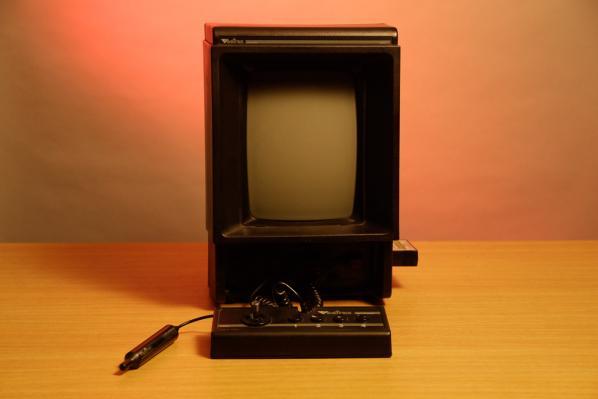
MC: The computer’s identity as tool for efficiency seems to overshadow the computer’s poetic potential. I use ‘poetic’ here to mean “the development of absolutely new forms of behavior”–a Lettrist definition of poetics which is notably similar to Mckenzie Wark’s definition of hacking (which you cite): “creating the possibility of new things entering the world.” …Has the poet always been a sort of hacker?
LE: I think so! Seeing writing, especially innovative poetry that lives on the edges of acceptability, as studies of media has brought about a profound shift in my thinking so that I’m no longer interested in trying to seeing through letters and words to get at the representational meaning but instead I think about how the writing registers media effects. I’m not sure how far back you can go in literary history and make this work, but there’s no question in my mind that poets such as Emily Dickinson, Stéphane Mallarmé, and of course a whole host of experimental early twentieth century poets were pushing up against the limits of what the media of their time could and could not do for/with writing. And to the extent that these poets are engaged in a continuous cycling of tinkering with the limits and possibilities of writing media of their time which in turn re-enlivens our language, it does seem like poetry [defined as such] could be seen as hacking.
MC: Diane di Prima wrote: “THE ONLY WAR THAT MATTERS IS THE WAR AGAINST THE IMAGINATION / ALL OTHER WARS ARE SUBSUMED IN IT” [emphasis in the original]. Do you think we have the means to win this war (which is also, it would seem, Richard Bailey’s “war against conventionality”)? To what degree is it a question of interface?
LE: Nearly all of our tools, no matter how simple, are interfaces for accessing other sets of tools (think of hammers and pens as interfaces to access nails and paper) so that not only are nearly all our actions mediated by interfaces of some sort but also there may not be such a thing as an unmediated, interface-free interaction. So, it’s possible to say that it’s always been a question of interface–the problem now is that corporations are making it as difficult as possible to perceive these interfaces and to see how they’re mediating and even determining our experience.
To get to your question about imagination, it’s getting harder and harder to be weird, or even encounter the truly weird which, for me, is “imagination”–existing in or seeing the world askew, envisioning new kinds of existence in the world because everything is indeed mediated tightly and thoroughly for us, making it next to impossible to be anything but a consumer. In this sense, winning the war could come down to making or producing either as an end in itself or as a means to just exercise imagination.
Featured image: Jane and Louise Wilson – ‘False Positive, False Negative’ (2012 Screen print on mirrored acrylic)
The Negligent Eye the Bluecoat Liverpool Sat, 08 Mar 2014 – Sun, 15 Jun 2014 http://www.thebluecoat.org.uk/events/view/exhibitions/1971
Featuring artists: Cory Arcangel, Christiane Baumgartner, Thomas Bewick, Jyll Bradley, Maurice Carlin, Helen Chadwick, Susan Collins, Conroy/Sanderson, Nicky Coutts, Elizabeth Gossling, Beatrice Haines, Juneau Projects, Laura Maloney, Bob Matthews, London Fieldworks (with the participation of Gustav Metzger), Marilène Oliver, Flora Parrott, South Atlantic Souvenirs, Imogen Stidworthy, Jo Stockham, Wolfgang Tillmans, Alessa Tinne, Michael Wegerer, Rachel Whiteread, Jane and Louise Wilson.
The Negligent Eye revolves around the way a digitally-native generation of artists – particularly printmakers – are questioning their relation to the digital, using the notion of ‘scanning’ as a kind of mid-state of the creative process of the human-digital hybrid. The show is co-curated curated by the Bluecoat’s Sara-Jayne Parsons and head of printmaking at the RCA, Jo Stockham, and features several works by her graduates, and other artists from around the RCA, such as Bob Matthews and Christiane Baumgartner. “The relationship between the material and virtual worlds is a question, a set of contradictions we are all inside and how technical images exert their influence on our everyday experience is of ever increasing importance.” Jo Stockham.

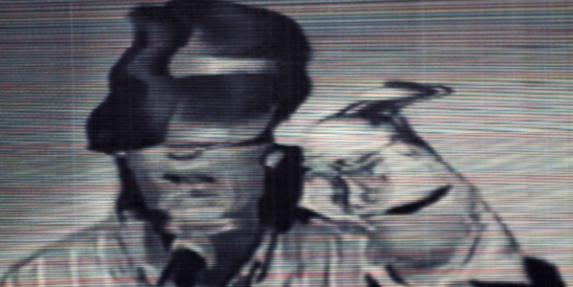
In her article Too Much World: Is the Internet Dead? Hito Steyerl asks what happened to the internet, after it died – that is, in an era of the “post-internet” after it stopped becoming a possibility, even in the midst, because of, and symptomized by, its permeation of everything. Steyerl is a major force in understanding our relationship to digital images, and her use of ‘death’ occurred to me often during viewings of this show and surrounding events, particularly as it could be applied to the post-digital.
So in a sense, I experienced the show as an autopsy of the digital image. From the tragic, simian face looking out from the first ever digital image, taken by Russell Kirsch of his son in 1950, exhibited at two points in the exhibition like an insistent memory. To Marilène Oliver’s figures from her 2003 Family Portrait series where bodies have been evoked as series of horizontal cross-section prints layered on acetate, so that they appear as though stored, but only partially in this world; the exhibition continually references, exemplifies and unpacks the death of its medium.
The post-digital is a paradoxical term – at once assuming the reliance of all contemporary culture in digitality, but also looking past it; affirming the death of a form, while embodying its afterlife. This is what Elizabeth Gossling’s images of a dead comedian says to me, when it is scanned from a computer screen and printed back on to archival paper, with his image waving from behind an ether of static, living in the solid pulp. The best works in this show, Gossling’s included, speak very eloquently about the post-digital, and how artists are motivated into hybrid forms of production, always acknowledging and working in a context of the saturation of the digital.

The notion of saturation, and its implications of the dissolution and liquidity, itself saturates the show: the first work, Maurice Carlin’s monumental print, scrolling down from the ceiling of the vide space is in one sense a spectral ancestor of Monet’s waterlilies, but with gashes and pustules of CMYK colour oozing up from behind the serine blue and greens of the pond, and white pixel-like rectangles plugging up the gaps; London Fieldworks’ 3D image of data collected from Gustav Metzger’s brain while he thought of nothing, is presented on a screen with a trickling sound – perhaps of information leaking inexorably back in?

Marilène Oliver’s glitch-sculpture of body parts fused in the heart of the 3D scan/print machine hang in the chute of the gallery corridor, their surfaces mid-ripple as though submerged; Jo Stockham’s etherized black and white shot of an element of the London skyline, seen perhaps through a teary bus window, but now writhing with red in its afterlife as a veined and depthless skin.

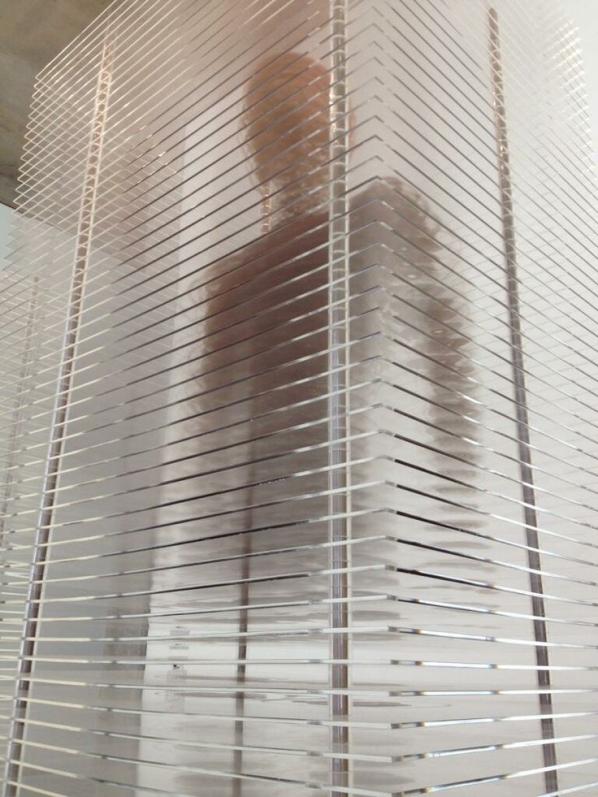
Using damage and error to expose the affectivity of a medium, particularly in the context of the digital is the central mode of Glitch Art. I have already used the term glitch to describe the aesthetic of Marilène Oliver’s sculptures, and the traces of digital-to-digital scan in Gosling’s work and the rich material pixilation of Christine Baumgarner’s inscription of CCTV camera stills into largescale wood prints, also contain these signatures.
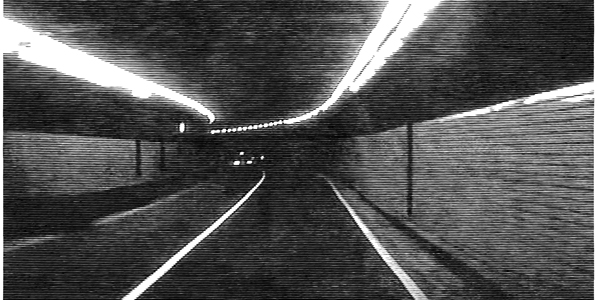
If there is a criticism to be leveled at these admirable and, frankly gorgeous, works. It is in their distance from what Rosa Menkman refers to as the moment(um) of the glitch. In the medium of print-making, the material fact of the object dominates, and with this show, no-matter the stated and playful interest in the ‘between-state’ of scanning, there remains the focus on material production – and therefore an irrefutable commodification.
Prints on archival paper and tempered steel, casts in plaster and large-scale hardwearing plastics, each speak of an appropriation of the tactical and fluid glitch, and its migration into commodifiable form. Maurice Carlin’s large-scale printwork could adorn a restaurant wall, just as Monet’s waterlilies functioned during his era, and Oliver’s sculptures also speak and modernise the language of sculpture as produced for private collections through the ages.
There are works also which say nothing of the ‘post-digital’, such as Imogen Stidworthy’s Sacha, a deeply thoughtful study of a wire-tap transcription ‘artist’ Sacha van Loo. Stidworthy’s enigmatic works are often hard to pin down thematically, and here it feels like the loft-type space of Gallery 3 has been used as an outer limit to the reach of the show. And then there are other works that say nothing at all and lessen the show’s conceptual rigor. I see Jeaneu Project’s peice, and think ‘smudge lawn’. I see a Cory Archangel print and a Rachel Whitereed miniture and their names flash through my consciousness like a Google Glass press release.
Truly though, this is a really refreshingly vibrant and precient show at the Bluecoat, and a great partner to the Mark Lecky exhibition featured at the venue last year in its pressing contemporaneity. The exhibition has also been a fulcrum for a really interesting series of events which have dealt with image production – including a day of talks and presentations, i-Scan, artist talks from contributing artists such as Imogen Stidworthy, and independently curated events such as the second in Deep Hedonia’s excellent Space/Sound series, where artists such as Madeline Hall, Jon Baraclough, Simon Jones and Andy Hunt explored the multiple angles from which digital scanning can be exploited as a performance and av medium. As with the Mark Lecky show, there is something about the context of the Bluecoat, as Liverpool’s most paradoxical space, which delivers an archival retrospective out of the most up-to-date material, and this tension is what pulls appart the body of works before us.
The Rubik’s Cube is not just a forgotten toy from the 80’s. The fact is that it’s even more popular than ever before. You can play with this great puzzle here.
First of 6 articles as part of the Piratbyrån and Friends exhibition at Furtherfield. Mariana Delgado, Coordinator of El Proyecto Sonidero (Mexico), writes about the Polymarchs posters (1980-1990) by Jaime Ruelas. Translation by Tess Wheelwright.
Panther / Jaime Ruelas / Polymarchs. On How We Came To a World of Legend By Mariana Delgado, Coordinator of El Proyecto Sonidero, I met José Luis Lugo in 2009 in the office above the Publicidades Panther print shop in Mexico City. Lupita La Cigarrita introduced us: sonidera, collaborator and number one follower of Sonido La Changa, el Rey de Reyes – the King of Kings. Later we learned from Lupita that José Luis had an important collection of sonidero event posters and flyers. Marco Ramírez, the co-founder of El Proyecto Sonidero, grew enthusiastic.
As soon as we released the book Sonideros en las aceras, véngase la gozadera (roughly Sonideros on the Sidewalks: Bring on the Revelry) in 2012, we began to see what should come next. In 2013 we launched the Proyecto de Gráfica Sonidera, in association with Panther, and in collaboration with draftspeople, poster artists, graphic designers, graffiti writers, sign painters, printers, promoters, collectors and researchers.
We are taken back to the origins of the tropical sonidero movement, which began in the 60s with turntables and LPs – loudspeakers and tweeters set up in the streets, dances thrown in the barrio. Over time various sound systems are added, each with its own crew; soon the multicolored Aztec or robotic lights are streaming. The biggest parties feature close to 50 systems at once, working simultaneously for hundreds of thousands of people. Music is introduced and mixed the Mexican way. Equipment is fiddled with; beats are slowed. Bass rumbles out from walls of speakers. Followers take their places and multiply along with vernacular genres. Transsexual dance clubs form circles on the dance floor; here a family, there a group of insiders – la banda – make their way through the crowd. The mic starts up, amplifying the shout-outs that will circulate the continent on CD and DVD, through streaming, links, posts. From Peñon de los Baños aka Colombia Chiquita to Neza York; from the barrio Tepito aka Puerto Rico to Chimalwaukee, out to all the brothers in Illinois.
In this world, all hatched from La Sonora Matancera. Cumbia and salsa are the queens of a grand court of rhythms. The Virgin of Guadalupe reigns supreme; it’s her congregation. Changó, San Judas Tadeo, and the Santa Muerte share the power thereafter. Epic is important, and family, too. What begins as a passion for Cuba soon builds: music from Colombia, Puerto Rico, Venezuela, Ecuador, Panama, Peru, the Dominican Republic, Buenos Aires, New York… The sonideros leave behind the established Mexican labels and their standardizing limitations, heading out on their own to comb the continent. They become vinyl diggers, import records, discover bands and musicians; they turn into promoters, create record companies and pirate labels, compile mixtapes to disseminate in the street markets and plazas, at parties and on commercial stands, through the internet.
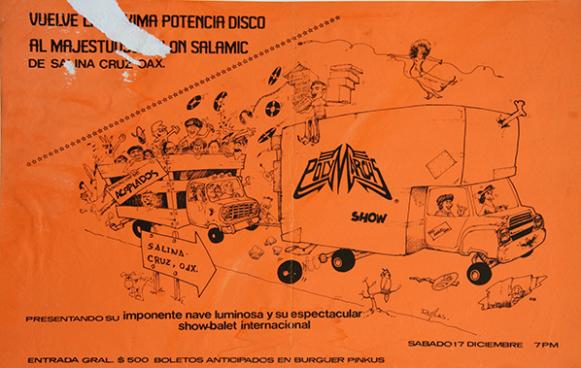
In the margin within – those more notorious neighborhoods of the Distrito Federal – embroidered logo jackets circulate, lending publicity to the sonidos along with their cards, posters, flyers, banners. Nonetheless, fewer and fewer dance parties are thrown. The city government has issued a discretionary ban of sonidero events in public spaces, canceling even traditional dances like the anniversary celebrations of Tepito’s markets. In the outer margins, ringing the DF and beyond, painted walls announce upcoming events and sonido trailers take over the streets. The dances go on.
We aren’t as familiar with the electronic scene, headed by Polymarchs. Our inroad is through the graphic materials comprising the collection Panther has amassed since 1979, which he rightly considers his primary asset. It all began in the Zona Rosa, where he used to go to trade posters, leaflets, stickers. At thirteen he formed part of the Polymarchs crew, coiling cables. Later he became a publicist, promoter, producer. He never stopped his gathering; stacks of paper tower in the office. Hundreds of posters and dozens of original drawings from the golden age of Hi-NRG pass in front of the camera, as José Luis remembers key scenes and events from this world: when they brought Gloria Gaynor to Mexico for the first time, when Sylvester came, when they packed the World Trade Center.
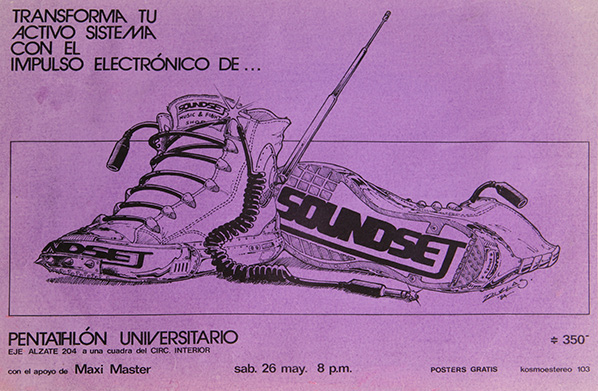
We are introduced to the world of artists and designers who created an imaginary to suit the precursors of the genre: pharaonic, galactic, utopian, spectacular, and futuristic. Always epic. Tailored to the moment, to the experience of the fans. The posters of the electronic sonidero movement are unique in format, employing unexpected techniques and materials; they are distinct, painstaking, sensational, new. In contrast, the works of tropical sonidos follow in the typographic vein of Mexico’s Gráfica Popular – reminiscent of the wrestling, taking the freedoms of the tropics, whether with box cutter or in full pixel. In the world of disco, Hi-NRG, and techno, the graphics are like the sound system: cult objects, concepts, myth.
“Do you want to meet Jaime Ruelas?” asks José Luis. The master of ink drawing, creator of logos and illustrations as iconic as La Changa or Polymarchs themselves. Of course we do. We are his fans, and we are an army. We arrive nearly punctually to the interview, with photography, audio and video gear in tow. Nearly punctually, because Jaime is already waiting; the son of a watchmaker, he knows machines, design and sound from the inside. He also knows the history of Polymarchs well, and from the beginning. Polymarchs’s first gig took place in his apartment in Tlatelolco. Later, Jaime became the sonido’s first DJ, before switching his focus to images.
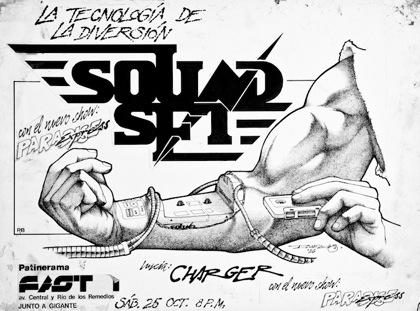
Like the sonidos thriving now in the capital, Polymarchs began in Puerto Ángel, on the Oaxaca coast, with a modest set-up – just a single Telefunken console and two baffles. The collective was formed by three siblings in 1975: Apolinar, Elisa and María de los Ángeles Silva Barrera. In 1978 they moved to Mexico City. Apolinar took charge of the sonido, and with Jaime Ruelas he discovered disco and Hi-NRG. The tenacity of Polymarches transcends mere selection of musical genres; the approach here is different. With tropical sonidos, the music, the equipment, the role of DJ and MC are the purview of one person, a single all-powerful figure operating from behind the console. Polymarchs is coming from somewhere else, assembling great towers of scaffolding, creating a spectacle, an experience, an environment. Neither DJ or MC, this is an entire machine. Polymarchs designs, produces and operates structures of light and sound as have never been seen before, radiant vessels that travel, carrying immense tech crews and companies of retro-futuristic dancers, from Tenochtitlan to outer space. There are explosions in the cosmos. On the floor all hands are up, cellphones by the thousands.
When Apolinar Silva and the Polymarchs team arrive at the Centro Cultural de España to give a conference in the context of the Proyecto de Gráfica Sonidera, the auditorium is brimming. Followers sport the distinctive t-shirts and jackets, hold up posters they’ve collected, wave cellphones. Apolinar is glowing; he is the supreme authority and, more than mythic, he is mystic. The audience takes the microphone to share their experiences. Like the time a Polymarchs event was organized in Mexico City’s Zócalo and what people thought was an earthquake turned out to be the earth shuddering under such dance. Below, in one of the exhibition spaces, Polymarchs set up a kind of black-light temple, aglow with, among many others, the visions we now share now with you.
The Proyecto de Gráfica Sonidera was an intensive program that resulted in records and research, specialized workshops and others for children, the painting of walls, the exhibition of graphic, photographic, and video material, and a series of talks along with book and documentary releases. We had the honor of including a drawing by Jaime Ruelas, and we kicked off with a dance party dedicated to Polymarchs… which was epic. There was a little boy who stole the dance floor, winning it against the odds from the more seasoned dancers.
All this was made possible thanks to many people and institutions. Shout-outs to the following generous collaborators: Marco Ramírez, José Luis Lugo, Javier Echavarría, Jaime Ruelas, Livia Radwanski, Mark Powell, Mirjam Wirz, Rocío Montoya, Tonatiuh Cabello, Diego Delgado, Alan Lazalde, Sonido Fajardo, Luis Sánchez, Héctor Rubí, Julio Díaz Corona, Sonido Leo, Christian Cañibe, Eduardo “Aníbal” Dueñas, Eleazar “Canuto” Escobar and the shop personnel of Publicidades Panther, Publicidades Lupano, Aisel Wicab, Citlali López Maldonado, Pedro Sánchez, Marisol Mendoza, Lupita La Cigarrita, Sonido Pío, Víctor Hernández, Edgar Ramírez, Laura Zárate, Griska Ramos, Mirna Roldán. Official respects to FONCA, to CONACULTA, to the Fundación Alumnos 47 and to the Centro Cultural de España.
Marc Garrett reviews Stefan Szczelkun’s book Agit Disco. He is an artist and author interested in culture and democracy. In the early Seventies he was fortunate to be part of the Scratch Orchestra and has since been involved with a series of artists collectives. His doctoral research into the Exploding Cinema collective was completed at the RCA in 2002. Recently his collaborative project Agit Disco was published as a Mute book in 2012. He has been on the Mute magazine editorial board since 2009, and currently working on photographic and performance projects.
“Just cause we can’t see the bars
Don’t mean we ain’t in prison.”
Kate Tempest (2009) [1]
The subtle and not so subtle domination by market interests of cultural production and dialogue denies us all access to a wide spectrum of creative expression, especially those that engage in subjects that conflict with the agendas of those in power. Agit Disco by Stefan Szczelkun combats this contemporary trend by focusing on music, politics, DIY culture, and freedom of expression. In doing so he starts to redress the lack of representation across the board for those in grass roots culture and working class lives, whose freedoms to have a voice in society are so commonly restricted.
The future does not look good for those who value cultural and social diversity; who look for a variety of activist histories and experiences to be seen and represented on their own terms. The UK government is changing university regulations so that private companies can become universities. This means tutors will end up replacing educational courses once devised with the public good in mind with modules designed for maximum profit. Luke Martell, a critic of the marketisation and privatisation of education and lecturer of Sociology at the University of Sussex, says “This will lead to a different content to education. Critical thinking is being replaced by conformity to cash. Money-spinning management and business courses are expanding and lower-income adult education is being closed down.” [2] (Martell 2013) Already, most researchers, academics and those in professional fields of practice mainly work within insider frameworks, “there is a qualitative difference between the conditions of people living in marginalized communities and those in middle-class suburbia.” [3] (Smith 2012)
The knock on effect of an unquestioning culture of compliance with the ‘free market’ is enormous. How ironic it is that the term ‘free market’ is attributed with so much value and (a presumed) logic when in actuality it constrains people’s freedoms and makes those who are already rich even richer. Because the politicians are not effected by the results personally, and because it also serves their interests, they have handed over their social responsibilities to these market systems. The neoliberal defaults that caused the financial crisis are untouched by our democratic processes. These out of reach, distant power systems are fixed towards property bias and occupy and govern our everyday experiences. How does freedom of expression fit into this and on whose terms?
“The more our physical and online experiences and spaces are occupied by the state and corporations rather than people’s own rooted needs, the more we become tied up in situations that reflect officially prescribed contexts, and not our own.”[4] (Garrett 2013)
Agit Disco offers a breath of fresh air, in the fug of the developing marketisation of everything. It presents grounded examples of difference that contrast with the dominating view of entertainment systems. Published through Mute Books in 2012, it features 23 playlists put forward by 23 different writers, artist and activists. It began as a set of mixed CDs and images, each chapter includes annotations and illustrations. Its contributors are Sian Addicott, Louise Carolin, Peter Conlin, Mel Croucher, Martin Dixon, John Eden, Sarah Falloon, Simon Ford, Peter Haining, Stewart Home, Tom Jennings, DJ Krautpleaser, Roger McKinley, Micheline Mason, Tracey Moberly, Luca Paci, Room 13 – Lochyside Scotland, Howard Slater, Johnny Spencer, Stefan Szczelkun, Andy T, Neil Transpontine, and Tom Vague.
Mostly from working class backgrounds the contributors were invited to focus on politics and music, and share memories relating to what the tunes meant to them at the time. In the preface Szczelkun states, his selection of contributors comes from his own worldview and personal contacts. Anthony Iles, in his introduction says most who have contributed “are closely associated with anti-authoritarian politics and DIY culture.”[5] (Iles 2012) Contributors offer insights into the connections between their music and the politics of the time. Louise Carolin says, “When I was a teenager in the ‘80s I lived through one of the golden ages of British chart pop, listening to music that was by turns, political, danceable, challenging and entertaining. I attended CND rallies, marched against South African Apartheid, ran the feminist group at school and went to GLC-funded music festivals.”[6] (Carolin 2011)
What adds depth to Louise’s story, as with the rest of the contributions is that many readers feel connected with these histories, and I am one of them. It highlights an indigenous, working class culture and their personal struggles in a period when neoliberalism was in its early stages of world domination. To say that these are merely anecdotal or subjective would completely miss the point. It calls for an awareness and understanding about people giving an account for themselves in relation to music, politics and their social contexts on their own terms.
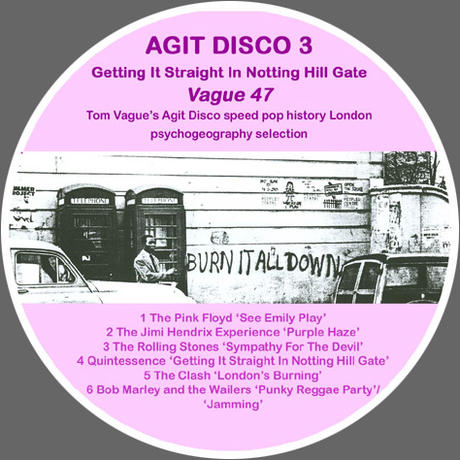
Just as it is important to ask contextual and critical questions of why a particular artwork is being shown at a certain venue or seen in an art magazine. It is also necessary to observe who published Agit Disco and why? It is no coincidence that it’s a Mute publication, Szczelkun has been on its editorial board since 2009, and has written various articles, reviews and interviews for Mute.
Agit Disco resonates with Mute’s dedication to DIY culture. Indeed, Mute has an excellent history in independent publishing alongside its DIY methods of production. Mute’s earliest incarnation used Financial Times’ pink paper, broadsheet printing cast offs. Later on a traditional magazine format. From 2005 onwards it moved onto its online site, and developed a publishing platform that allowed the publication of its POD (Print On Demand) magazine. [7] The design and production of Mute and its platforms have come a long way enabling a pamphlet-like production and distribution, echoing Thomas Paine’s own DIY releases of the Rights of Man.[8]
DIY Culture (and its distribution channels) offer a vital alternative to mainstream frameworks and their dominating hegemonies as a way to route around the restrictions to content, freedom of thought and free exchange. We have to contend with networked surveillance strategies initiated by corporations and state secret services. Censorship exists in many forms and recently there has been a rise of self censorship by workers and academics worried about losing their jobs if bosses see their interactions on Facebook or similar Web 2.0 social networks.[9] And the worrying antics of Britain’s GCHQ, in collaboration with America’s National Security Agency (NSA), targeting organisations such as the United Nations development programme, the UN’s children’s charity Unicef [10] reveal a greater investment in the surveillance of everyone, and the downgrading of privacy and fundamental human rights.
The credo that Anyone Can Do It reached a mass of individuals and groups not content with their assigned cultural roles as disaffected consumers watching the world go by. Like the Situationists, Punk was not merely reflecting or reinterpreting the world it was also about transforming it at an everyday level. Sadie Plant states that with the “emergence of punk in the late 70s […] lay the possibility of a threatening political response to the vacant superficiality of contemporary society.” [11] From this, a whole generation of diverse artists emerged; and through their practices they critiqued the very society they lived in, questioning authority and the authenticity of established politics, language, art, history, music and film.
Has the process of appropriating people’s civilian personas, and then replacing their social contexts with a corporate role as consumer created a more selfish world, lacking compassion for others and less interest for societal and ethical change? Ubermorgan discussed in a recent interview with Stevphen Shukaitis that people are in a state of ‘mediality’. “What we refer to as reality very often is just mediality, and also because that’s how human nature often prefers to observe reality, you know, via some media.” [12] Perhaps our constant interactions through different interfaces of proprietorial frameworks distances ourselves to what is important. In the 21st Century demonstrations and civil disobedience are policed intensively, and even though much of contemporary activism exists on-line. The frontline, or the heart of politics is still mainly a physical matter; it is still in our streets, our homes, our bodies, in our neighbourhoods and communities.
As Oxblood Ruffin a Canadian hacker and member of the hacker group Cult of the Dead Cow (cDc) and the founder/director of Hacktivismo, said “I know from personal experience that there is a big difference between street and on-line protest. I have been chased down the street by a baton-wielding police officer on horseback. Believe me, it takes a lot less courage to sit in front of the computer.” [13]
So Agit Disco reminds us that music is a vital way of both bringing people together in a space, story telling and communicating with each other, sharing what is happening with people’s lives. It is usually at the moment of censorship that we then realise how essential this freedom of expression stuff really is. For instance, nine months after Islamic militants had taken over in northern Mali they announced that all music is banned. “It’s hard to imagine, in a country that produced such internationally renowned music as Ali Farka Touré’s blues, Rokia Traoré’s soulful vocals and the Afro-pop traditions of Salif Keita. […] The armed militants sent death threats to local musicians; many were forced into exile. Live music venues were shut down, and militants set fire to guitars and drum kits. The world famous Festival in the Desert was moved to Burkina Faso, and then postponed because of the security risk.” [14] (Fernandes 2013)
In her article The Mixtape of the Revolution, Fernandes says that in Africa many rappers are “speaking boldly and openly about a political reality that was not being otherwise acknowledged, rappers hit a nerve, and their music served as a call to arms for the budding protest movements.”[15] Regarding Egypt, the rapper Mohamed el Deeb in an interview with Fernandes said, “shallow pop music and love songs got heavy airplay on the radio, but when the revolution broke out, people woke up and refused to accept shallow music with no substance.” [16] Music, politics and grass roots dissent are concrete expressions and an essential part of our collective freedoms. Alongside this, independent publishing as an alternative voice to the marketed franchises that dominate our gaze, sight, ears and minds, are needed more than ever. Yet, independent voices are being silenced and whittled down by wars, oppression and the neoliberal created financial crisis and its resulting austerity cuts.
What is to become of us if we lose our skills of discernment and slump into a homogenous consumer class, to define ourselves solely through marketed stereotypes and ideologies?
Agit Disco offers a festival of dance and dialogue for independent minded individuals and groups around the upturned burning car in the barricade against the coming zombie apocalypse.
It has been fun listening to all of the playlist contributions provided in Agit Disco. Below is my own Agit Disco playlist. You are welcome to add your own playlist in the comments section below (with links)…
Damien Dempsey – ‘Dublin Town’ (2000)
http://www.youtube.com/watch?v=brhO8pqTNHU
Asian Dub Foundation – ‘Modern Apprentice’ (2000)
http://www.youtube.com/watch?v=zgtWhjaOgQ4
Dan Le Sac & Scroobius Pip – ‘Great Britain’ (2010)
http://www.youtube.com/watch?v=YeV2cExvnMI
Kirsty MacColl – ‘Fifteen Minutes’ (2005)
http://www.youtube.com/watch?v=MSQrH3JUQ2s
Jeffrey Lewis – ‘Do They Owe Us A Living?’ (2007)
http://www.youtube.com/watch?v=jWU-W0SzVE0
The Pop Group – ‘Forces of oppression’ (1979)
http://www.youtube.com/watch?v=Txzmbu6o-gg
Kieron Means – ‘I Worry For This World’ (2005)
https://play.spotify.com/track/6AI2QujkrP6B2nfIUK55lY
Robyn Archer – ‘Ballad on Approving of the World’ (1984)
https://play.spotify.com/album/3hNQY8q9sO3M0R6es2d3ka
Robyn Hitchcock – ‘Point it at Gran’ (1986)
http://www.youtube.com/watch?v=_HFkimK9FAU
Sound of Rum – ‘End Times’ (2011)
http://www.youtube.com/watch?v=9dWPe7Au68A
Silver bullet – ’20 Seconds to comply (final conflict)’ (1990)
http://www.youtube.com/watch?v=24b6pYGT9MM
Maze – ‘Color Blind (Featuring Frankie Beverly)’ (1977)
http://www.youtube.com/watch?v=COY4gKLwV2I
Akala – ‘Bullshit’ (2006)
http://www.youtube.com/watch?v=mxpxpQ7j8Sg
Sarah Jones – ‘Your Revolution’ DJ Vadim (2000)
http://www.youtube.com/watch?v=E62SZ1CmBOI
Julian Cope – ‘Soldier Blue’ (1991)
http://www.youtube.com/watch?v=8dGOr-JpOmI
June Tabor – ‘A place called England’ (2009)
https://play.spotify.com/track/3YB6sSlLfB8kmMrrm5COKX
For over 17 years, Furtherfield has been working in practices that bridge arts, technology, and social change. Over these years, we have been involved in many great projects and collaborated with and supported various talented people. Our artistic endeavours include net art, media art, hacking, art activism, hacktivism and co-curating. We have always believed it is essential that the individuals at the heart of Furtherfield practice in arts and technology and are engaged in critical enquiry. For us, art is not just about running a gallery or critiquing art for art’s sake. The meaning of art is in perpetual flux, and we examine its changing relationship with the human condition. Furtherfield’s role and direction as an arts collective is shaped by the affinities we identify among diverse independent thinkers, individuals and groups who have questions to ask in their work about the culture.
Here I present a selection of Furtherfield projects and exhibitions featured in the public gallery space we have run in Finsbury Park in North London for the last two years. I set out some landmarks on the journey we have experienced with others and end my presentation with news of another recently opened space (also in the park) called the Furtherfield Commons.
Running themes in this presentation include how Furtherfield has lived through and actively challenged the disruptions of neoliberalism. The original title for this presentation was ‘Artistic Survival in the 21st Century in the Age of Neoliberalism’. The intention was to stress the importance of active and open discussion about the contemporary context with others. The spectre of neoliberalism has paralleled Furtherfield’s existence, affecting the social conditions, ideas and intentions that shape the context of our work: collaborators, community and audience. Its effects act directly upon ourselves as individuals and around us: economically, culturally, politically, locally, nationally and globally. Neoliberalism’s panoptic encroachment on everyday life has informed Furtherfield’s motives and strategies.
In contrast with most galleries and institutions that engage with art, we have stayed alert to its influence as part of a shared dialogue. The patriarch, neoliberalism, de-regulated market systems, corporate corruption and bad government; each implement the circumstances where we, everyday people, are only useful as material to be colonized. This makes us all indigenous peoples struggle under the might of the wealthy few. Hacking around and through this impasse is essential if we maintain human integrity and control over our social contexts and ultimately survive as a species.
“The insights of American anarchist ecologist Murray Bookchin into environmental crisis hinge on a social conception of ecology that problematises the role of domination in culture. His ideas become increasingly relevant to those working with digital technologies in the post-industrial information age, as big business develops new tools and techniques to exploit our sociality across high-speed networks (digital and physical). According to Bookchin, our fragile ecological state is bound up with a social pathology. Hierarchical systems and class relationships so thoroughly permeate contemporary human society that the idea of dominating the environment (to extract natural resources or to minimise disruption to our daily schedules of work and leisure) seems perfectly natural despite the catastrophic consequences for future life on earth (Bookchin 1991). Strategies for economic, technical and social innovation that focus on establishing ever more efficient and productive systems of control and growth, deployed by fewer, more centralised agents, have been shown to be both unjust and environmentally unsustainable (Jackson 2009). Humanity needs new social and material renewal strategies to develop more diverse and lively ecologies of ideas, occupations and values.” [1] (Catlow 2012)
It is no longer critical, innovative, experimental, avant-garde, visionary, evolutionary, or imaginative to ignore these large issues of the day. Suppose we, as an arts organization, shy away from what other people are experiencing in their daily lives and do not examine, represent and respect their stories. In that case, we rightly should be considered part of an irrelevant elite and seen as saying nothing to most people. Thankfully, many artists and thinkers take on these human themes in their work in various ways, on the Internet and in physical spaces. So much so, this has introduced a dilemma for the mainstream art world regarding its relevance and whether it is contemporary.
Furtherfield has experienced, in recent years, a large-scale shift of direction in art across the board. And this shift has been ignored (until recently) by mainstream art culture within its official frameworks. However, we need not only to thank the artists, critical thinkers, hackers and independent groups like ours for making these cultural changes, although all have played a big role. It is also due to an audience hungry for art that reflects and incorporates their social contexts, questions, dialogues, thoughts and experiences. This presentation provides evidence of this change in art culture, and its insights flow from the fact that we have been part of its materialization. This is grounded knowledge based on real experience. Whether it is a singular movement or multifarious is not necessarily important. But, what is important is that these artistic and cultural shifts are bigger than mainstream art culture’s controlling power systems. This is only the beginning, and it will not go away. It is an extraordinary swing of consciousness in art practice forging other ways of seeing, being, thinking, making and becoming.
Furtherfield is proud to have stuck with this experimental and visionary culture of diversity and multiplicity. We have learned much by tuning into this wild, independent and continuously transformative world. On top of this, new tendencies are coming to the fore, such as re-evaluations and ideas examining a critical subjectivity that echo what Donna Haraway proposed as ‘Situated Knowledge’ and what the Vienna-based art’s collective Monochrom call ‘Context Hacking’. Like the DADA and the Situationist artists did in their time, many artists today are re-examining current states of agency beyond the usually well-promoted, proprietorial art brands, controlling hegemonies and dominating mainstream art systems.
Most Art Says Nothing To Most People.
“The more our physical and online experiences and spaces are occupied by the state and corporations rather than people’s own rooted needs, the more we become tied up in situations that reflect officially prescribed contexts, and not our own.” [2]
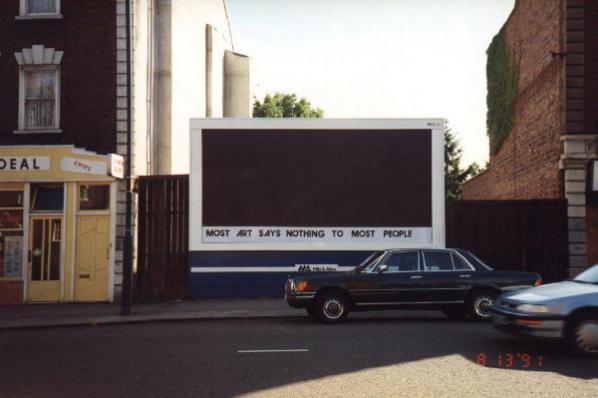
To start things off, I want to refer to a past work that Heath Bunting (co-founder of irational.org) and I were involved with in 1991. The above image is a large paste-up displayed on billboards around Bristol in the UK. At the time, as well as being part of other street art projects, pirate radio and BBS boards, Heath and I and others were members of the art activist collective Advertising Art. The street art we made critiqued presumed ownership of art culture by the dominating elites. The words “Most Art Says Nothing To Most People” have remained an inner mantra ever since.
Furtherfield is inspired by ideas that reach for a grassroots form of enlightenment and nurture progressive ideas and practices of social and cultural emancipation. The Oxford English Dictionary describes Emancipation as “the fact or process of being set free from legal, social, or political restrictions; liberation: the social and political emancipation of women and the freeing of someone from slavery.”
“Kant thought that Enlightenment only becomes possible when we are able to reason and to communicate outside of the confines of private institutions, including the state.” [3] (Hind 2010)

Well, a start would be getting organised and building something valuable with others.
As usual, it is up to those people who know that something is not working and those feeling the brunt of the issues affecting them who end up trying to change the conditions. It is unlikely that this pattern of behaviour will change.
To expect or even wish those who rule and those serving them to change, challenge their behaviours and seriously critique their actions is as likely as winning the National Lottery, perhaps even less.
Art critic Julian Stallabrass proposes that there needs to be an analysis of the operation of the art world and its relation to neoliberalism. [4]

In the above publication, Gregory Sholette argues “that imagination and creativity in the art world thrives in the non-commercial sector, shut off from prestigious galleries and champagne receptions. This broader creative culture feeds the mainstream with new forms and styles that can be commodified and utilized to sustain the few elite artists admitted into the elite. […] Art is big business: a few artists command huge sums of money, and the vast majority are ignored, yet these marginalized artists remain essential to the mainstream cultural economy serving as its missing creative mass. At the same time, a rising sense of oppositional agency is developing within these invisible folds of cultural productivity. Selectively surveying structures of visibility and invisibility, resentment and resistance […] when the excluded are made visible when they demand visibility, it is always ultimately a matter of politics and rethinking history.” [5] (Sholette 2013)
Drawing upon Sholette’s inspirational, unambiguous and comprehensive critique of mainstream art culture in the US. I want to consider examples closer to home blocking artistic and social emancipation avenues that also need an urgent critique. And this blockage resides within media art culture (or whatever we call it now) itself. Recently, I read a paper about ‘Post-Media’ – said to “unleash new forms of collective expression and experience” [6]- which featured in its text-only established names. Furtherfield is native to ‘Post-Media’ processes, a concept that theorists in media art culture are just beginning to grasp. This is because they tend to rely on particular theoretical canons and the defaults of institutional hierarchies to validate their concepts. Also, most of the work they include in their research is shown in established institutions and conferences. They assume that because a particular artwork or practice is accepted within the curatorial remits of a conference theme, the art shown represents what is happening, thus more valid than other works and groups not included. This is a big mistake. It only reinforces the conditions of a systemic, institutionalised, privileged elite and enforces a hierarchy that will reinforce the same myopic syndromes of mainstream art culture. The extra irony here is that many supposedly insightful art historians and theorists advocate a decentralised, networked culture in their writings or as a relational context. However, many do not support or create alternative structures with others. The real problem is how they acquire their knowledge. Presently the insular and hermetically sealed dialectical restraints and continual reliance on central hubs as official reference is distancing them from the actual culture they propose to be part of.
“We must allow all human creativity to be as free as free software” [7] (Steiner, 2008)
Furtherfield comes from a cultural hacking background and has incorporated into its practice ideas of hacking not only with technology but also in everyday life. Furtherfield is one big social hack. Hack Value advocates an art practice and cultural agency where the art includes the mechanics of society as part of its medium and social contexts with deeper resonances and a critical look at the (art) systems in place. It disrupts and discovers fresh ways of looking and thinking about art, life and being. Reclaiming artistic and human contexts beyond the conditions controlled by elites.
Hack Value can be a playful disruption. It is also maintenance for the imagination, a call for a sense of wonder beyond the tedium of living in a consumer, dominated culture. It examines crossovers between different fields and practices concerning their achievements and approaches in hacking rather than as specific genres. Some are political, and some are participatory. This includes works that use digital networks, physical environments, and printed matter. What binds these examples together is not only the adventures they initiate when experimenting with other ways of seeing, being and thinking. They also share common intentions to loosen the restrictions, distractions and interactions dominating the cultural interfaces, facades and structures in our everyday surroundings. This relates to our relationship with food, tourism, museums, galleries, our dealings with technology, belief systems and community ethics.
Donna Haraway proposes a kind of critical subjectivity in the form of Situated Knowledges.
“We seek not the knowledges ruled by phallogocentrism (nostalgia for the presence of the one true world) and disembodied vision. We seek those ruled by partial sight and limited voice – not partiality for its own sake but, rather, for the sake of the connections and the unexpected openings situated knowledges make possible. Situated knowledges are about communities, not isolated individuals.” [8] (Haraway 1996)
Furtherfield had run [HTTP], London’s first public gallery for networked media art, since 2004 from an industrial warehouse in Haringey. In 2012 the gallery moved to a public location at the McKenzie Pavilion in the heart of Finsbury Park, North London.
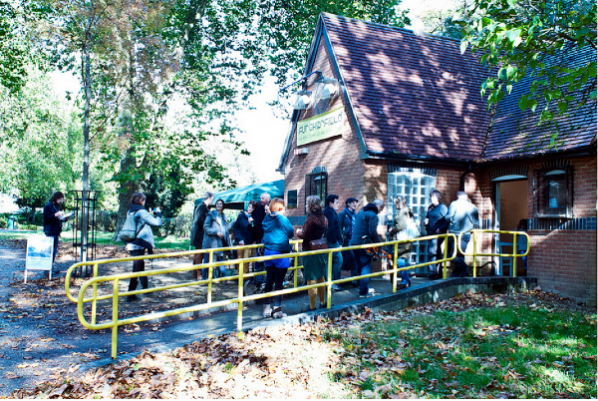
However, we are not just a gallery; we are a network connecting beyond a central hub.
“It is our contention that by engaging with these kinds of projects, the artists, viewers and participants involved become less efficient users and consumers of given informational and material domains as they turn their efforts to new playful forms of exchange. These projects make real decentralised, growth-resistant infrastructures in which alternative worlds start to be articulated and produced as participants share and exchange new knowledge and subjective experiences provoked by the work.” [9] (Garrett & Catlow, 2013)
The park setting informs our approach to curating exhibitions in a place with a strong local identity, a public green space set aside from the urban environment for leisure and enjoyment by a highly multicultural population.

We are simultaneously connected to a network of international critical artists, technologists, thinkers and activists through our online platforms, communities, and wider networked art culture. We get all kinds of visitors from all backgrounds, including those who do not normally visit art spaces. We are not interested in pushing the mythology of high art above other equally significant art practices. Being accessible has nothing to do with dumbing down. It concerns making an effort to examine deeper connections between people and the social themes affecting theirs and our lives. We don’t avoid big issues and controversies and constantly engage in a parallel dialogue between these online communities and those meeting us in the park.
We feature works incorporating local people’s contributions, bringing them closer to the art and engagement of social dialogue. For instance, London Wall, N4 by Thomson and Craighead, reflected a collective stream of consciousness of people all around Finsbury Park, gathering their Tweets to print out and paste onto the gallery walls. By retweeting the images of the tweet posters, we gathered many of the original authors in the gallery to see their words physically located among others made in the vicinity.
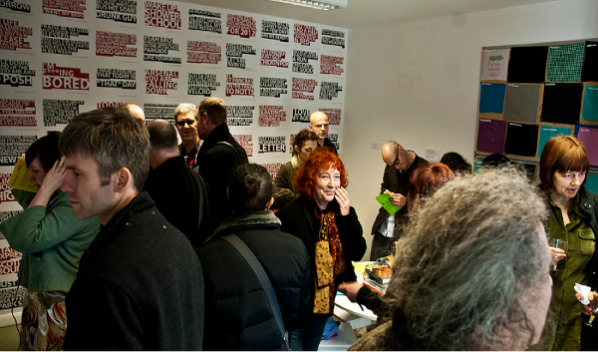
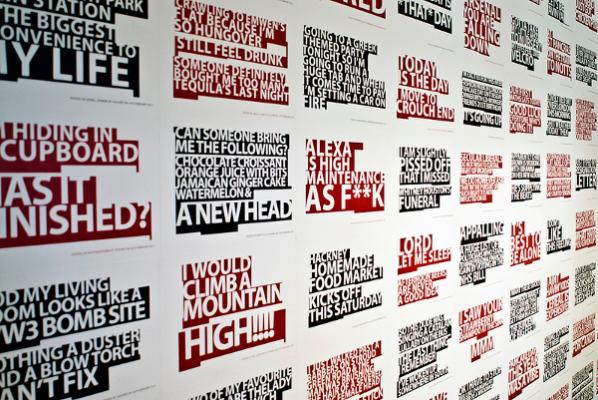
Crow_Sourcing by Andy Deck invited people to tweet animal expressions from around the world – illuminating the link between the formation of human language and our relationships with other wild webs of animal life. Gallery visitors illustrated their animal idioms, drawing directly onto the gallery walls, inspired by the ducks, crows, squirrels and dogs that inhabit the park.
We feature works dealing with networked and pervasive technologies’ human and social effects. Web 2.0 Suicide Machine by moddr_ proposed an improvement to our ‘real’ lives by providing a one-click service to remove yourself, your data, and your profile information forever from Facebook, Twitter and MySpace, replacing your icon (again, forever) with a logo depicting a noose. They also reflect on new forms of exposure and vulnerabilities they give rise to, such as Kay’s Blog, by Liz Sterry, which replicated in physical space the unkempt bedroom of an 18-year-old Canadian girl based only on her blog posts, to eerie effect. The intention is to reach people in a way that has people question their relationship with those technologies. This does not mean promoting technology as a solution to art culture but exploiting it to connect with others and critique technologies simultaneously.
Below: Selection of images from original slide presentation – exhibitions & events.
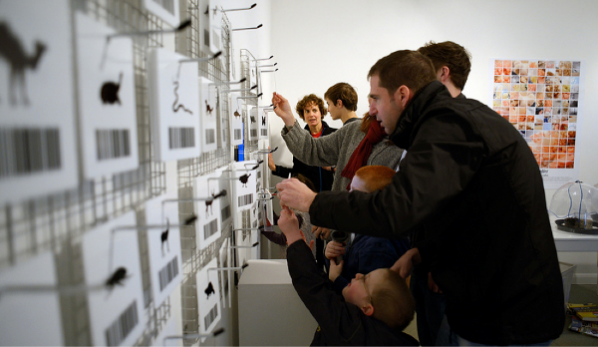

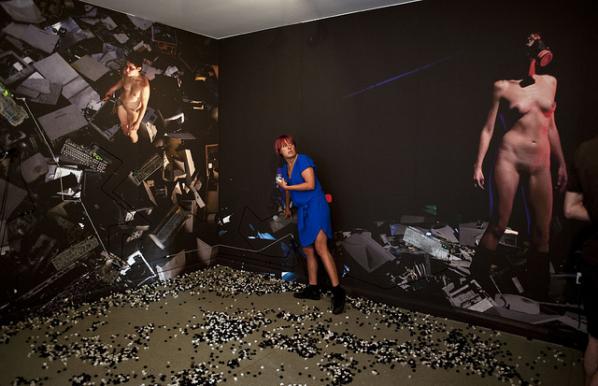
On the 23rd of November, we opened our second space in the park, ‘The Furtherfield Commons’. It kicked off with The Dynamic Site: Finsbury Park Futures, an exhibition by students from the Writtle School of Design (WSD) featuring ideas and visions for future life in Finsbury Park, coinciding with the launch.
This new lab space for experimental arts, technology and community explores ways to establish commons in the 21st Century. It draws upon influences from the 1700s when everyday people in England, such as Gerrard Winstanley and collaborators, forged a movement known as the Diggers, the True Levellers, to reclaim and claim common land from the gentry for grassroots, peer community interests. Through various workshops, residencies, events & talks, we will explore what this might mean to people locally and in connection with our international networks. These include free software works, critical approaches to gardening, gaming and other hands-on practices where people can claim direct influence in their everyday environments in the physical world, to initiate new skills and social change on their terms. From what we have learned from our years working with digital networks, we intend to apply tactical skills and practices into everyday life.
Furtherfield is a network across different time zones, platforms & places – online & physical, existing as various decentralised entities. A culture where people interact: to create, discuss, critique, review, share information, collaborate, build new artworks & alternative environments (technological, ecological, social or both), examine & try out value systems. “A rhizome has no beginning or end; it is always in the middle, between things, interbeing, intermezzo.” (Brian Massumi 1987)
DADA, Situationism, punk, Occupy, hacktivism, networks, Peer 2 Peer Culture, feminism, D.I.Y, DIWO, Free Software Movement, independent music labels, independent thinkers, people we work with, artists, activism, grassroots culture, community…
This comprises technological and physical forms of hacking. It also includes aspects and actions of agency-generation, skill, craft, disruption, self-education, social change, activism, aesthetics, re-contextualizing, claiming or reclaiming territories, independence, emancipation, relearning, rediscovering, play, joy, being imaginative, criticalness, challenging borders, breaking into and opening up closed systems, changing a context or situation, highlighting an issue, finding ways around problems, changing defaults, and restructuring things – Claiming social contexts & artistic legacies with others!
This text is a re-edited slide presentation first shown at the ICA, London, UK, on 16th November 2013 (Duration 25 min). Intermediality: Exploring Relationships in Art. Speakers Katrina Sluis, Peter Ride, Sean Cubitt & Marc Garrett.
http://www.ica.org.uk/39077/Talks/Intermediality-Exploring-Relationships-in-Art.html
Transdisciplinary Community (TDC) Leicester UK 27th Nov 2013 (45 min). Institute of Creative Technologies. De Montfort University.
Two projects Gregory Sholette is currently involved in:
It’s the Political Economy, Stupid. Curated by Oliver Ressler & Gregory Sholette
http://gallery400.uic.edu/exhibitions/its-the-political-economy-stupid
Matt Greco & Greg Sholette | Saadiyat Island Workers Quarters Collectable, 2013
http://bit.ly/1eSI5kX
—————————————————–
All exhibitions, events & projects at Furtherfield – http://www.furtherfield.org/programmes/exhibitions
Old Words Made New.
Ethical knowledge, sacred spaces, forgotten histories and challenging predispositions.
Furtherfield is pleased to present the excellent cross cultural project DISCLOSURE: Old Words Made New. We have collaborated with Medieval Studies Graduate Students from King’s College London, and artist Erica Scourti to reversion a contemporary representation on the subject of medieval social lives, based on the theme of ‘ethical knowledge’ through Old English. With a combination of works in the Finsbury Park surroundings, sound installations, collaborative writing, and performance.
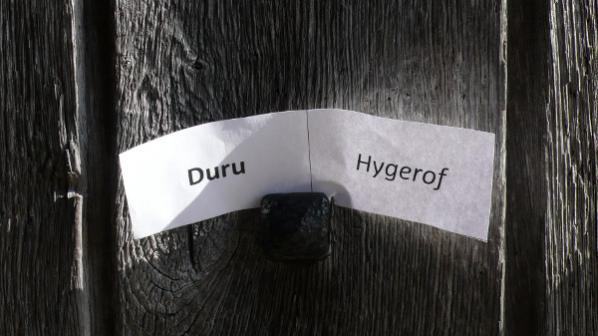
The project is part of Colm Cille’s Spiral project, a collaboration between Difference Exchange, King’s College London and Furtherfield, and takes place alongside a commission by artist Erica Scourti. It relates to a series of contemporary art and literature commissions and dialogues rethinking the legacy of 6th Century Irish monk Colm Cille, or St Columba, that unfolds across Ireland and the UK, starting and ending in Derry-Londonderry for City of Culture 2013.
Come and add an Old English phrase to the Wordhoard painted onto the walls of Furtherfield Gallery!
Help us create a visual hoard of words, received from scholars all over the world, which will show the extent of the current study of Old English. Explore the memories of our site-specific work at Bradwell-on-Sea, a church built in 654 by St Cedd, by watching our recording of the event. Walk through Finsbury Park listening to the sounds of Old English poetry and meditating on trees that bleed.

For the event, Erica Scourti will present another iteration of her video postcard project, currently existing as a series of empty, annotated videos on her Instagram profile. As a one-off, the full set of over 100 videos emailed out to friends, family and online contacts over the summer period will be screened, the only time they will be shown publicly. Also, the metadata the recipients provided for each video will form the basis of a sound piece that will play throughout the afternoon.
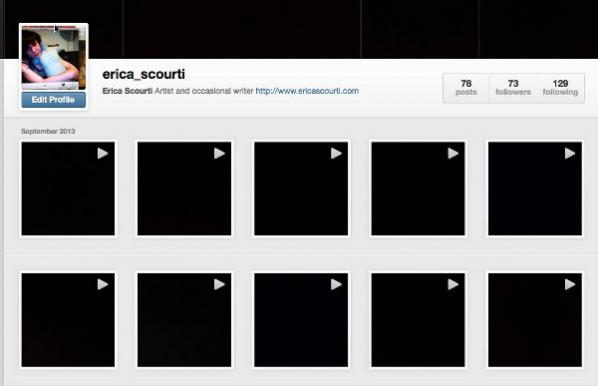
The project has explored new ways to understand and interpret the language and social contexts of a time where Christianity was at its early phase of using its people through networks around the UK, whilst pagan culture was still thriving.
The question posed to the King’s College students was “If we existed in a contemporary society where the Internet could no longer be trusted because of systems of networked surveillance, what would be the different ways in which we could communicate?”
In July 2013 they showcased their findings at a live public event at the historic Bradwell-on-Sea Church, which is now being held at Furtherfield.

A warm thanks to Kings College lecturers Professor Clare Lees, Dr Joshua Davies, Dr James Paz for collaborating.
Other Colm Cille’s Spiral projects have taken place across the UK and Ireland as part of Derry-Londonderry City of Culture and can be explored at www.colmcillespiral.net
Furtherfield Gallery
McKenzie Pavilion, Finsbury Park
London N4 2NQ
T: +44 (0)20 8802 2827
E: info@furtherfield.org
Furtherfield Gallery is supported by Haringey Council and Arts Council England.
LIVE LINK HERE
In collaboration with Annie Abrahams and Emmanuel Guez, Furtherfield presents two new ReadingClub sessions based on excerpts from McKenzie Wark’s A Hacker Manifesto [version 4.0] and the ARPANET dialogues.
ReadingClub proposes a text and an interpretive arena to 4 readers. These readers write together their reading of a text inside the text itself. The audience sees an evolving, cinematographic picture of thoughts and collaborative writing in the making.
Join the performance online at readingclub.fr and use the chat window to exchange, discuss and comment on the performance.
Monday 21 October 2013, 8pm London Time – A Hacker Manifesto [version 4.0]
Online performance session based on an excerpt from A Hacker Manifesto [version 4.0] by McKenzie Wark – with Aileen Derieg, Cornelia Sollfrank, Dmytri Kleiner and Marc Garrett.
Drawing in equal measure on Guy Debord and Gilles Deleuze, A Hacker Manifesto offers a systematic restatement of Marxist thought for the age of cyberspace and globalization. In the widespread revolt against commodified information, McKenzie Wark sees a utopian promise, beyond the property form, and a new progressive class, the hacker class, who voice a shared interest in a new information commons.
Tuesday 22 October 2013, 8pm London Time – The ARPANET dialogues
Online performance session based on an excerpt of the ARPANET dialogues from 1975-1976 – with Alessandro Ludovico, Jennifer Chan, Lanfranco Aceti and Ruth Catlow.
The ARPANET dialogues is an archive of rare conversations within the contemporary social, political and cultural milieu convened between 1975 and 1979 that were conducted via an instant messaging application networked by computers plugged into ARPANET, the United States Department of Defense’s experimental computer network. All participants in the conversation were given special access to terminals connected to ARPANET, many of them located in US military installations or DOD-sponsored research institutions around the world.
What was originally thought to be a historic moment, when figures from within and without the established art canon first encountered the disruptive effects of digital network communications, turned out to be an ongoing research project by Bassam El Baroni, Jeremy Beaudry and Nav Haq.
Further reading:
“This pre-Internet chatroom conversation between Jim Henson, Ayn Rand, Yoko Ono and Sidney Nolan is fake. But it’s amazing” – Robert Gonzalez in io9, December 2012.
“Ronald Reagan has joined the chatroom” – Interview by Richard Fischer, CultureLab with Jeremy Beaudry, one of the artists behind the project, April 2011.
The ReadingClub is a project by Annie Abrahams and Emmanuel Guez, inspired by Brad Troemel’s Reading Group and the Department of Reading by Sönke Hallman.
The project is supported by Dicréam.
+ More information about ReadingClub
Sam Renseiw and Philip Sanderson’s Lumière & Son project is a near perfect and altogether exhilarating sequence of moving image lyric poetry (though lyric here does not exclude humour or the grotesque) and a demonstration of how seriality and fragment – an unfolding over time, the diaristic – has quietly become one of the fundamental modes brought stage centre by the network (so much more than the rather dull ‘interactive’ which has so quickly become the standby of the monetised digital). Impossible to watch one of these pieces without the desire to watch just one more.
The set (which lives online but has been shown offline in whole and part) and its component pieces, moreover, are studies in various interesting things: the liberating effects of constraint and collaboration and what those both demand and imply; also of randomness, or perhaps better, the loose, the dashed off, differing degrees of accuracy in such collaboration (also the apparently dashed off, the apparently loose [also the apparently synchronised or ordered]).
To start with, a little history. In 2007 two young members of the digerati, Andreas Haugstrup Pedersen and Brittany Shoot, invented a form and threw down a gauntlet. The form, in fairness, was not exactly new – over 100 years old, actually – but its re-contextualisation within the digital realm and more particularly on the network was, without exaggeration, a stroke of genius[1]. It involved taking precisely the constraints affecting the films of the cinema pioneers, the Lumière brothers, and applying these to contemporary online video work. Films or videos of exactly one minute, fixed camera, no sound, no zoom, no edits. Such videos dubbed, naturally, ‘Lumières’. There was clear recent precedent in the constraints of the Dogme movement of Von Trier and others but the project also drew on the various little-bit-art-little-bit-geek, young, playful cultures which abutted and intersected the more formal area which we called, for a while, ‘net-art’, and which thrived on a sparky and often competitive and showy overcoming of the early net’s limitations of file size and bandwidth – projects like 5k.org, 10secondfilm.com spring to mind.
Additionally, because the start of modernism still does not really seem all that far away, early film was a natural reference point for many wrangling the early internet as art tool and channel both.
We responded viscerally to the sheer, almost willed-into-being, expressivity of the ad hoc devices and solutions of early film and this fitted snugly with the bodges we ourselves were employing. It gave us confidence, too, that our ducking and diving too could be expressive but also it confirmed a certain tendency to lo-fi-ness there in the zeitgeist. (I speculate – a lo-fi-ness which helped to define and declare art – useless, beautiful and human – as against the slickness of corporate design, communication and advertising… This has persisted remarkably – note the thriving on-going cult of the animated gif)
That was the form. The challenge – make some. Embrace that 100+ year old limitation and do something engaging with it. Push the form as far as it will go.
Pedersen and Shoot set up a web site where all contributions would be aggregated and indexed (in retrospect, somewhat unfortunately, by links rather than copies held on their server – much work of historical significance has already vanished. Shoot and Pedersen themselves have moved on and the site has a Marie Celeste feel). In addition to the site itself, there was a Lumière manifesto which, personally, I found a little narrowly focussed. Shoot and Pedersen seemed to invoke a near ethical dimension to the return to first principles and in their own moving image practice confined themselves to work (much of it very good) entirely within this discipline. It was clear from the huge response of other artists and film-makers though that the form clearly answered a diverse set of pressing needs. For some it was a cleansing activity, for some a sketchbook, for others a spur to invention and for others still, a challenge in the sense of “How can I observe the spirit of the rules whilst actually driving a coach and horses through them?”
Although the Lumière made next to no impression on the ‘official’ world of art video (one speculates – cynically, perhaps – too democratic and available to anyone with a cheap camera, too ontologically opposed to the expensive grandeur of high concept, too hands-dirty in a world where artists aspire to hire videographers and editors to realise their art; in short, too lacking in the conspicuous consumption that validates much contemporary work), it was enthusiastically taken up by a mixed bag of videobloggers and artists excited by the idea of video specifically made for the net.
An immediate adopter and one of the most enthusiastic and prolific makers of Lumières was the Danish architect, educator and thinker, Thomas Wiesner, who operates in online video as Sam Renseiw and maintains a quirky and engaging site called Spacetwo: Patalab. Renseiw (as he prefers to be known in a video context) is a maker of numerous very singular small video works, which evince his keen interest in space and movement within spaces. (He teaches not only architecture but also a course for dancers involving approaches to conceptualising movement in space). I’m not sure Renseiw completely understands how original his work is. It is characterised by a joy in careful, quizzical looking (and a spontaneity in finding or being gifted subjects for such looking, assisted enormously by the continual development of more portable and discreet video cameras). It is, in terms of the formal art world deeply unfashionable. Personal and diaristic, it eschews the grand concept and extravagant and expensive execution and is all the better for this.
Renseiw has a profound sensitivity to space and to how people and objects move along variously restricted and open trajectories but he is mindful too of what the ‘actors’ in these found scenarios, set out to do and in fact achieve as human beings. The gap between aim and reality provides fertile ground for Renseiw’s dry and humane sense of humour, which is never far distant.
Significantly his prolific Lumière making (337 at the time of writing) sits side by side with longer (though still lapidary) works with music, editing and the other things the Lumière eschews.
Renseiw’s Lumières are characterised by a number of quite distinctive things. Something that unites them all is a quite extraordinarily heightened sensitivity to both colour and composition, which formal feature hits us forcefully in the moments even before we begin to decode any content or action. Formally striking too is the way in which a number of the pieces are composed so to as to allow for action in the near, middle and far distance, sometimes in different sectors of the frame, sometimes simultaneously in a kind of layered visual counterpoint and sometimes spread out temporally. My imputed intentionality here is somewhat problematic, though Renseiw confirmed to me that he shoots much more material than he uses and that he will select a particular minutes worth of material from longer sequences so on two counts there is a rudimentary (though nominally forbidden) editing process occurring. A quick comparison with Lumières by other film-makers will however confirm that Rensiew’s singular vision distinguishes each of his pieces from the off.
Other signatures are extremely low, oblique or occluded camera positions, into the fields of which parts of human bodies mysteriously intrude. This sounds clinical. Curiously it is the opposite. Redeeming it is a genial humour which allows the part to stand for the whole – we perforce imagine the entire human being whilst smiling at the V-effekt with which we are presented – for example a pas de deux for a pair of woman’s black leather boots (on the ends of beyond-the- frame legs) and the four paws of a black dog – randomness, clumsiness, near misses, narrow escapes and – we just know because we are human – purposeful activity. Human life, in short.
Another defining stamp is a musician’s sensitivity to rhythm and tempo – rhythm as manifested both as near metronomic regularity – someone’s gait, traffic flow, a hammer, for example, with either disruptions – slowings down, speedings up, pauses, stutterings – to that regular pattern, or polyrhythms created by other simultaneous independent near regularities and variations therefrom.
There are three loose categories into which Renseiw’s Lumière work could be said to fall (of course they’re by no means entirely mutually exclusive) – we’ll call them the loop-able, the documentary and the performative. The loop-ables are kin to the still photograph, are often of natural phenomena or repetitive but irregular human engendered activity where one could imagine the minute’s imaging infinitely, hypnotically extended – the flashing light patterns in Belisha Code for example. The documentary tag applies where the topic itself might be assumed to have some independent interest, for example the workers transporting away in a sling Copenhagen’s Little Mermaid for a trip to Shanghai’s 2010 expo in Speaking Voice or Michelle Obama’s motorcade in Rite of Passage. In what I’ve called the performative, richest of all in my view, an amazing amount of stuff happens. And everyday stuff happening and rendered vital by keen eye, framing and selection rather than something we might have known to look out for, is key. The differently distanced layers referred to earlier partition the frame physically or the piece temporally and unexpected things happen against and within them. We participate in these dynamically as viewers – we view this strange jigsaw world and complete it mentally; sketch a world beyond which is not simply our lived world but that world somehow leavened with Renseiw’s odd and warm sensibility.
I’ve written pretty glowingly about these Lumières – constrained, silent but surprisingly un-austere and you could well think that to add sound, music or both and several layers of these to boot might be over-egging it all somewhat. So one would think, but I have complimentary things yet to say about skill, tact, panache, flair and sensitivity and they are heading the way of Philip Sanderson, Renseiw’s musical/sound collaborator in the extended Lumière and Son project.
Renseiw’s Lumières are, I hope I’ve established, rich, dense, multi-layered but remarkably uncluttered works. A number of these pieces approach as closely as possibly the condition of music whilst remaining wholly without sound. It might seem superfluous or an act of hubris to add sound to them, the consequence of which could be to render leaden, stiff and fixed what is light, playful, complex and turns on a sixpence.
With the exception of a couple of near misses Philip Sanderson’s sound and music additions triumphantly avoid this trap and indeed deepen those rich and quicksilver qualities.
It’s important to note that what Sanderson contributes is all found or appropriated material – it’s possible he’s added original material in, I don’t know, but it’s not a significant chunk if he has – he certainly reworks much of it intensively, usually in the form of a mix of several layers of sound, some musical, some textual. (And we should note that Sanderson’s wit and deftness is literary as well as musical).
The deployment of sound gains enormously from Sanderson’s huge and eclectic range of knowledge, reference and enthusiasms. There’s a cooking metaphor in here – mixing the ingredients, finding just the right, perhaps almost imperceptibly present flavourings, knowing the qualities of things and how to combine them well…
Elsewhere I have asserted that the key feature of the most successful short form video work is a combination of intense poetic compression with a huge range of suggestion. I called this opening-out – a universe from a speck of dust. An ability to evoke the range of connectedness of many disparate things by well-chosen images, sounds, texts, whatever can pertain to moving image. Certainly Renseiw’s work has this in spades. Sanderson’s sound opens-out the movies still further. It adds, almost literally, an extra dimension, as if enabling new angles of view. It provides paths, bridges, vistas, tunnels, maps, balloons, telescopes, and sonar.
The guiding methodological principle seems to be a species of metonymy and one moreover which suggests an, in practice entirely non-existent, explanatory or illustrative dimension. The flashing beacons in Belisha Code are accompanied by a recording of a numbers station where one’s immediate impulse is to construct entirely absent meaning in the correspondence of the binary on-off of the four beacons and the German numbers from zero to nine heard on the soundtrack. Let’s be clear that this is not a criticism – a rigorous correspondence would be leaden – closed-in – but what we do have is a rich package of suggestion and affect. The correspondence that does exist is formal and temporal, between the flashes of the beacons and the articulation of the words and where the same sort of rickety polyrhythms that we’ve observed within the original Lumières themselves ensue.
Although comparison of some of Sanderson’s sources with their use in the pieces evidences, on occasion, some quite detailed cutting, mending and buffing-up there is an inescapable sense in his deployment of sound of the somewhat aristocratic tradition of the modestly dashed off. It’s partly his clearly extensive knowledge of his sources and his evident skill with a huge variety of genres but it’s also to do with a certain ambiguity in how the sounds are placed – not four square upon, but athwart the images, the sound often only fading or vanishing well after we’re into Renseiw’s end titles. Sometimes the sound is clearly not cut to shape in the way one might at first expect – an introduction, for example proper only to the original sound itself and not to any clear visual motivation might be left standing. The imperfections, noise, oddities and glitches contained within each block of appropriated sound intensify this sense of informality as does the slightly culinary air referred to previously. On the other hand, often enough to matter, the sound directly lines up in a spine tingling way with a particular action. It’s a master class in expressive ambiguity.
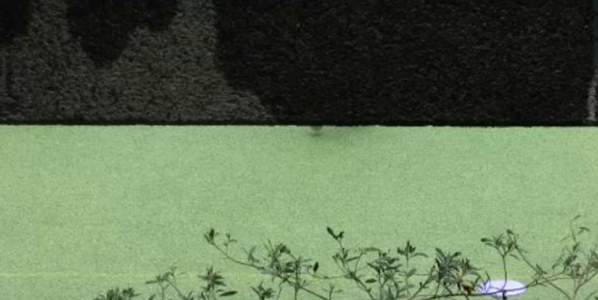
Renseiw – physical poetry, the occlusion, constraint. The careful choice of footage (variety and kind of motion within a narrowish range). Humanism: we don’t see faces, we don’t hear voices, we are amused but we recognise ourselves, youth and age &c.
Sanderson: The music found but could have been composed. The artfulness of placing it just thus. We will never know whether the way it ends with the action, the running off, taking place just after the repose of the final minor chord was deliberated or found. For me this placement implies a universe beyond the letterbox. It has a commonality with the treatment of time in many photographs and paintings – this is an instant, a fragment, but there was a before and an after.
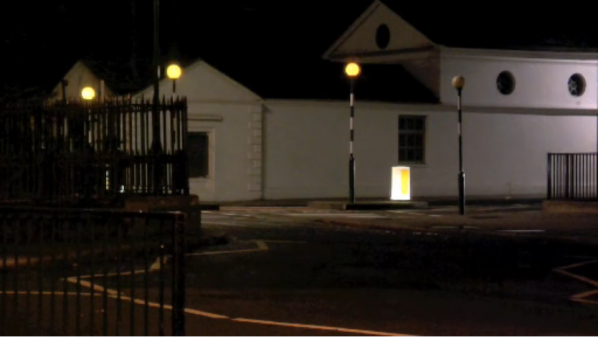
Note that there are four beacons. The sound (a numbers station, one can almost track the archaeology of impulse!) draws on the numbers 0-9, in German. It’s worth noting there is no obvious mathematical mapping between the pattern of the beacons and the numbers but the character in sound of the numbers is close to that of the beacons in light. Suggestion, metonymy.
This forces our attention very strongly on that area of the screen, with the concomitant effect that when we force our attention away it is as if our eyes have been suddenly opened. There is a world out there.
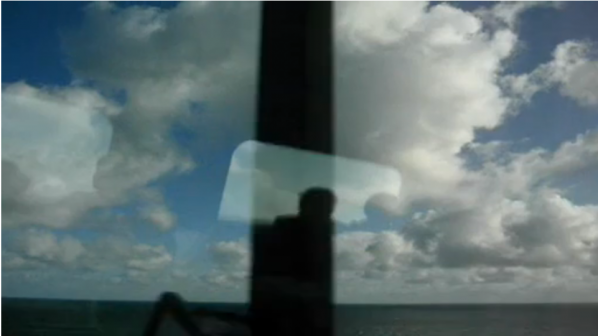
There is a hint of the transcendent in the title – how is this realized? Unless we know Denmark it takes a few moments to realize we are on a train rather than a boat or plane – we are clued into this by the close objects we clearly pass at speed and the reflection of passengers and seating in the windows. One speculates that the sound track is comprised of two elements – one the rhythmic and metallic pulse which somehow rhymes with the passing object (a kind of pseudo-diegesis) and the second an (Open University?) lecture on relativity.
Here, not exactly metonymy but something more fragile, delicate chains of suggestion and subtle resonance. No argument (to see an argument in any of this would be to commit a category error) but a complex and suggestive …um…thing. One should also note that this piece (in both its silent and extended versions) is extremely beautiful.
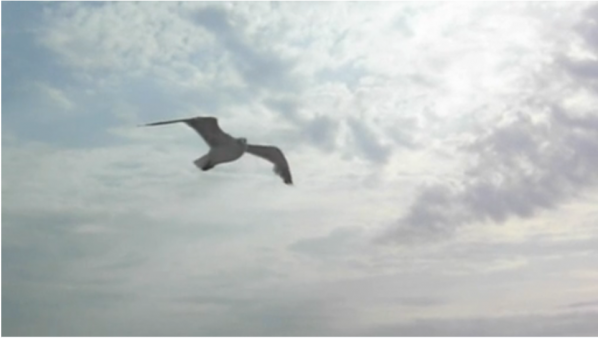
Let’s talk about the sensibility and taste of the makers. Renseiw offers something simple, a kind of tour de force – we perceive it as such although given the fixed camera constraint any virtuosity belongs to the seagull.
A banal seasoning of music would involve simply the seven note modal motif which hails, I’m almost certain, from American popular song of the 70s big country type – Wichita Linesman, you know the sort of thing. (I checked with Sanderson –it’s Bobby Goldsboro’s Summer The First Time) By itself it would be too perfect, too parallel to the floating bird (it seems to give way to a crashing wave sound in its looped form; interestingly the Goldsboro video I found on YouTube begins with a shot of gliding seagulls). With too much parallelism nothing extra arises but Sanderson spices the mixture by the addition of dialogue from what sounds like an American film of the forties or early fifties. It disrupts the idyll but only so as to make us more aware of it. There is a kind of musical V-effekt here (which could have been so badly handled and so isn’t). This is its ‘meaning’ – these things! Here, now!
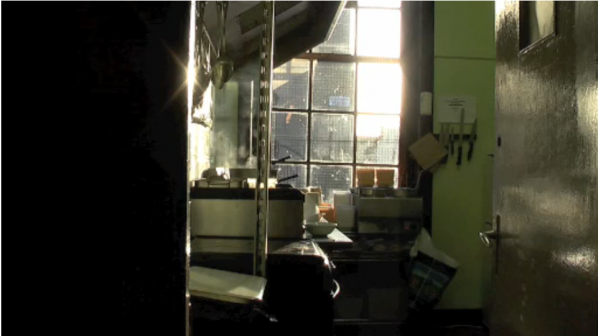
There is something of the dance about this. The music beautifully picks up both the nervous, sudden gestures of the cook but also suggests the process of cooking itself. The music has a funk component. One might say that it cooks.
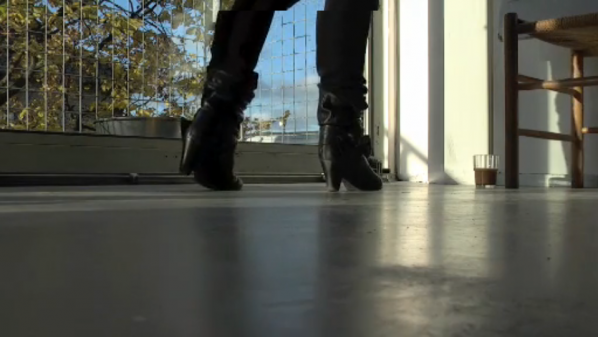
Visually – the low angle, the fragmented view of the body, the person here and not here. The focus on that person which permits and invites its opposite, in particular the framing of the sky and trees. The rhyme between the black-booted two legs of the woman and the black four legs of the dog. Their pas de deux. The music here subordinate, properly so. Ambient sounds, on the one hand, with odd vocal snatches on top. The strangeness doesn’t demand our attention because we are so focused on the visual.

Until the last moments we simply hear a fitting (slightly arch) accompaniment to the skating – we surmise that it is intended to pastiche the kind of accompaniments used in professional skating. At the last moment we realize this is exactly what it is, as the commentator’s voice breaks through. There is also a ‘skate’, ‘friction’ or ‘traveling’ noise which exactly underpins the final move we see, just before the humour of the juxtaposed text, which continues after the movie has gone to black, strikes us: “Delightful, skating of the highest quality” delivered in classic plummy BBC tones…

A hugely rich piece: visually there are a number of layers – the far left street background where distant people and vehicles process. The game of Petanque: – the actual participants (although glimpsed corporeally only twice: fleetingly at the very end and as one set of typical Renseiw-y legs) and the balls themselves (and the metonymic link between these and the planets). Thirdly, the large shadows. (And the apparent size of each of these layers allows for very clear visual interaction). Sound – the ‘light’, jokey, playful music. The University Challenge soundtrack, here unusually clearly cut up – questions – astronomy; replies – painters. A risk for Sanderson, but one that works.

A little detective work indicates the level of detailed truffling about by Sanderson – part of the sound, the text, is grabbed from a YouTube video about French patisseries in London and cut up considerably – in particularly yielding the repeated incantation “cream cakes, tarts, macarons” the latter word in a considerably overheated French accent following the sloaney first three, to deeply comic effect. Comic maybe but, repeated, as in a dream; this mood is reinforced by a rather beautiful waltz time solo piano loop of the opening line of The Associates’ Party Fears Too. Here’s another piece where the visuals, here also dreamy and wistful, set in a looking glass Copenhagen (and the disjuncture between the London-location heavy narrative and the visuals is simply ignored, taken for granted, part of the deal), support quite a complex sound assemblage. Utterly haunting and quite difficult to say exactly why.
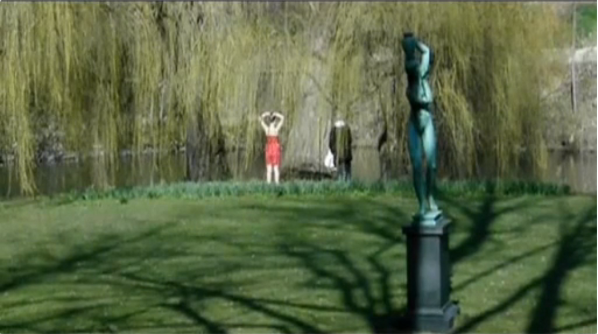
If one didn’t know it wasn’t one would surely assume this was carefully planned, and our knowledge it was not adds to our pleasure in it. Visually the rhyme between the woman and the near foreground statue is perfect – at one point she seems to mirror it exactly. Maybe she knows the area well and there is some unconscious mental echoing…we’ll never know. The other sharp visual pleasure is the smallness of the area of focussed distant activity, which again feels like a sort of directorial chutzpah, except, except…
Sanderson’s contribution is razor-sharp – the pseudo dialogue hits the mark precisely but doesn’t outstay it’s welcome – or at least there’s other stuff going on to detain us, not least the way the model’s preliminary warm-up shimmy becomes a perfect piece of minimal dance when set against the music.
Right of Passage/Speaking Voice
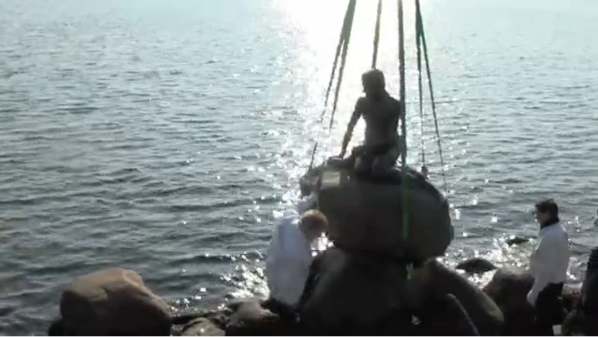
I wonder if when the content has it’s own ‘documentary’ interest, when the filming becomes a case of “Look at this remarkable thing not because of its intrinsic interest but because it happened”, the final result is somehow less engaging?
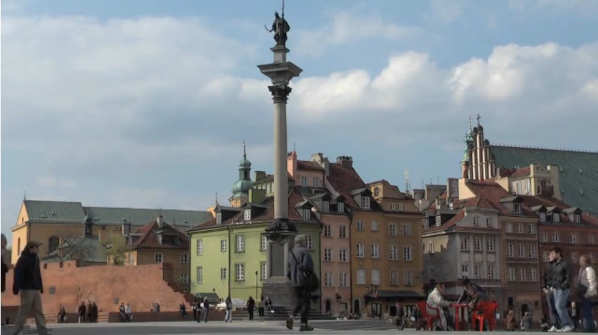
Again a dance related piece – the regular beat of the calling of the numbers one to eight sets up an aural grid against with which the implicit rhythms of the movement in, out and across frame interact in a sophisticated but subtle polyrhythm. Part two of the sound, with actual step instructions, ups the tension and the effect (especially the late entering ‘spinning’ man). Note how often in these pieces the sound fades out slightly later than the visuals, over Renseiw’s titles, thus emphasising its separate existence in an independent channel or dimension.
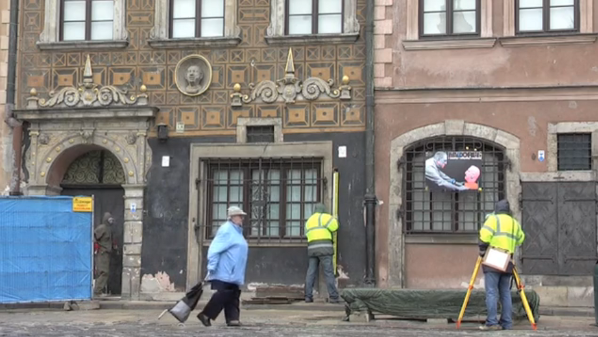
Beautiful found synthesis. Funny. Funny and truthful and touching.
The moving image is packed with incident at both different spatial levels and at different points in the piece. The Portsmouth Sinfonia version of Dance of the Sugar Plum Fairy underpins like a grid, as with Square Dance but in a more complex way, the visual rhythms of the film. Enough coincidence of rhythm to feel planned, enough ‘pull outwards’ to feel open… Again humour… Why does the Portsmouth Sinfonia track, in particular, work so well – atmosphere? the conjuring of a sort of raggedy clockwork ? – can we imagine in its place a more conventional rendering of the Tchaikovsky? Yes, but…
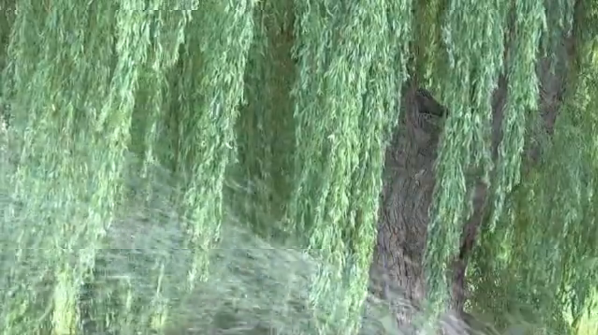
Prime example of Sanderson mind set – metonymy, suggestion – the trees are hair, the water appears exactly on cue (worked? Hmm – the audio appears to be cut to make the word ‘rinsing’ and the water jet coincide)
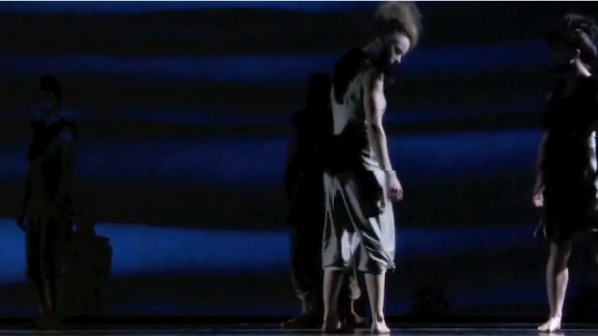
A one liner, but, given its place in the sequence, none the worse for it.
Brass band/Dancers.
*The pieces loosely divide into ones where either sound or vision predominate and some where they have equal roles.
* Not only does dance appear a couple of times explicitly as a subject but the spirit of dance pervades the project.
*The question of the success of individual pieces and of the sequence – a piece that seems less effective in isolation can well form an effective point of relaxation or reflection in the sequence as a whole…
*There are three pieces which, if one ‘re-removed’ the sound, would not strictly be Lumières – Check Out Art Fairs (speeded up), A Beauty Overblown (slowed down) & Sucked In (reversed). Sanderson performed the first two operations for reasons he felt the sound he used demanded. (To which one can only say: yes, this is right, a constraint is there for the sake of art, not art to be constrained.) Sucked In remains a mystery.
*The titles matter (note the re-titling of the composite works). They provide yet another dimension and illumination too.
*The prevailing tone is light, warm and playful. The darker side of life is largely absent, at least explicitly (though there are trails we could pick up to find it). Humour is everywhere. Only a philistine or fool would judge the work as a consequence to be less ambitious, significant or universal.
So Alan Turing was born 100 years ago today. More or less every esteemed field of technological discovery has been plugging certain events and exhibitions surrounding the Turing centenary this week, each one steadily demanding a greater recognition of Turing’s astonishing legacy and achievement. There have been articles aplenty; some seeking to identify Turing alongside other persecuted scientists. Others argue that Turing’s achievements should be listed alongside calculus and relativity – perhaps something which should have been common-place anyway given the precarious computer age which surrounds us – (rather bewilderingly, despite the increased media coverage the UK Government are still failing to issue a full pardon for Turing’s shocking treatment in the last two years of his life).
It’s a testament to Turing’s fascination with nearly everything that 76 years since his first major paper, there’s still so much to write about his work. Expect this week to offer more events and glimpses into these projects: Neuro-computational studies into the functional basis of cognition. The ever forward march for genuine artificial intelligence. New methods of simulating the complexity of biological forms nearly 60 years after Turing’s paper on the chemical basis of morphogenesis (indeed this area of complexity theory is now an established area of major research). The slippery mathematical formalist discoveries which define what can or cannot be computed. And not forgetting key historical developments in cryptography, perhaps the field which Turing is most respected for. Moreover, Turing wasn’t just one of the greatest mathematicians of the 20th Century, but also one of the greatest creative engineers; someone who wasn’t afraid of putting his ideas into automation, through the negotiation of materials.
So for the positivist sciences and technological engineers, Turing’s curiosity continues to bequeath low hanging research fruit ready to be picked. But what of the arts and humanities? How have they contributed to the Turing centenary? How are they influenced by Turing?
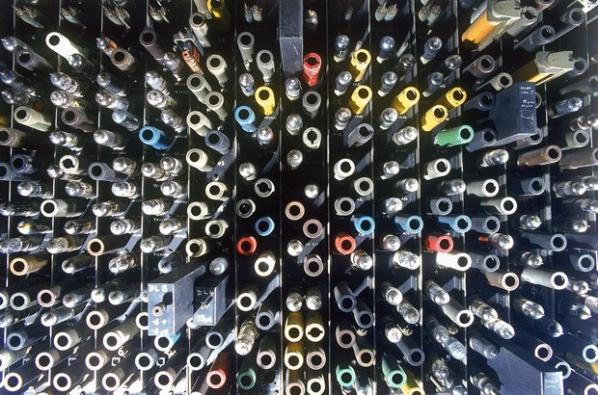
Indeed, its always more deeper than is actually realised. Clearly, in Analytic Philosophy where cognitive science is dominant, Turing’s legacy continues to elevate epistemological, ethical or moral questions about the nature of the human mind – with many offering high bids on the future foundation of a computable brain, by reducing the cognitive understanding into its putative evolved material constituents (see Daniel C. Dennett’s recent article in The Atlantic) – Others completely vilify the idea that consciousness could ever be fully engineered. Others speculate (naturally).
In the arts, a special Alan Turing centenary committee has been set up to fund art projects which deal with Turing’s legacy in various ways. The “Intuition and Ingenuity” exhibition in particular features work by Ernest Edmonds amongst others. In a more direct link, the mathematician Robert Soare has even argued for the existence of a pesudo-cryptic ‘Turing Renaissance’, establishing a link between classical recursion theory and the classical art of the Italian High Renaissance (which has more than a potent ‘Da Vinci Code’ whiff about it).
Some academics have chosen to focus on the biographical details of Turing’s own short life. In particular Homay King (and I only found out about this in conversation last week) has offered key insights into Turing’s research methods using Queer Theory, not simply because Turing was openly gay and speculated on thought experiments involving gender, but because Turing wanted to understand peculiar sociabilities of ambivalent miscommunication. Evan Selinger has written a recent article on how social scientists are using the “Turing test” to observe and understand deception in social groups. And also influenced by these same deceptive qualities, Prajwal Ciryam clarifies its influence on psychopathy and predicting when a psychiatric patient should be released. Here, difficult questions emerge as inspired by the difficult questions Turing himself raised, even if the fields wildly diverge from his own.
But here’s a question – could the arts and humanities move further into Turing’s legacy than admirable commentary on specific biographical revelations of his life, or questions which bother cultural ambiguity?
Perhaps we should ask whether the Turing Centenary will actually convince the humanities and the sciences to attentively read Turing’s work? Forgive the disingenuous patronising structure of the question; I clearly realise that people have read Turing’s work, especially his most famous and readable article, Computing Machinery and Intelligence published in 1950. But think back, have you actually read it?
Written off the back of a report done for the National Physical Laboratory between 1948-1949, Turing’s succinct article famously speculated on machinic intelligence, as well as launching the infamous Turing Test (the moniker “Turing Test” is a bit of a misnomer, Turing himself called it an imitation game). And yet, it strikes me as absurd that more hasn’t been written on how strange, bizarre, hysterical, paradoxically informal and wonderfully written this text is, as a text. Especially since it is a text which is often considered ‘scientific’ and ‘academic’ as opposed to ‘mere literature’.
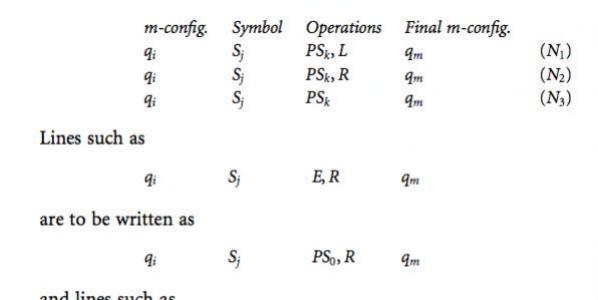
In a 2008 article, which again, no-one seems to have read (‘Powers of the Facsimile: A Turing Test on Science and Literature‘, written for an edited collection on the novelist Richard Powers) – Bruno Latour makes this strategic point about the ambivalent qualities of Turing’s 1950 article. For him, Turing’s text contains not clear analytic rigour, but “metaphors, tropes, anecdotes, asides and self description”; features of what he calls “matters of concern”. Turing considered the idea of machines having intelligence through the “most bizarre, kitschy, baroque text ever submitted to a scholarly journal“. Latour even jokes that Alan Sokal would no doubt have interpreted it as a hoax. It’s no wonder that Turing’s friend and logician Robin Gandy said of the essay that, “it was intended not so much as a penetrating contribution to philosophy but as propaganda […] He wrote this paper – unlike his mathematical papers – quickly and with enjoyment. I can remember him reading aloud to me some of the passages – always with a smile, sometimes with a giggle.“
“The problem” Latour states, “is that people never read.” Well, by ‘reading’ Latour means that the analytic sciences didn’t really pay attention to what Turing is saying. Even worse, some just ignore the deliberate ambiguity of Turing’s text by reading through it as a transparent window onto whether the mind is computational in nature or whether machines can actually think or not (a question which in the same article and subsequent lectures, Turing considered “too meaningless to deserve attention”, as well stating that his aim wasn’t to give a definition of thinking).
This, for Latour, begs a different type of Turing test; can one distinguish between a Richard Powers novel of realist literature (an exposition of which is given in the first half of the paper) and the scientific realism of Turing? If one is sufficiently fooled, then Latour “will have at least indicated that matters of concern might be best accessible through the joint inventions of literature and science.” And it’s here where the humanities and the arts should claim Turing as a kindred spirit, for Latour’s test terminates any significant difference between “an important scientific text and an important novel” precisely insofar as one cannot distinguish “dealing with demonstrations while the other deals with rhetoric, one dealing with proofs while the other deals with stories[…]” Turing had the nerve to slice and dice allusive, eloquent and creative persuasion together with an empirical understanding of electrical computation. I doubt various scientific proponents of the Turing centenary would take this significance with much seriousness, but I’m convinced artists and literary scholars would do.
So this begs a question, which should resonate loud and clear on Turing’s 100th birthday. What happens when we treat Turing even more seriously; not just as a mathematician, engineer or scientist, but also as a cryptic creative thinker and writer? What happens if we follow his words and not just his conclusions (although certainly the conclusions are worth following, if not extensively by others).
One element which stands out time and time again, is how much Turing was influenced by the reality of unproved conjecture rather than designating reality through deductive proof. This isn’t a quirky coincidence. Turing’s negative solution to Hilbert’s decision problem in his equally famous 1936 paper On Computable Numbers – the paper which conceived the computer as an abstract mathematical concept – showed that there was an intrinsic paradox at the heart of automation. It’s impossible to systematically predict what a certain function will do before you execute it. So in Turing’s 1950 article, we shouldn’t be at all surprised when he espouses the following point;
“The popular view that scientists proceed inexorably from well-established fact to well-established fact, never being influenced by any unproved conjecture, is quite mistaken. Provided it is made clear which are proved facts and which are conjectures, no harm can result. Conjectures are of great importance since they suggest useful lines of research.” Computing Machinery and Intelligence, p.49.
Another point of semblance is how uninfluenced Turing was by the work of his peers. Max Newman one said of him that it was a “defect of his qualities that he found it hard to use the work of others, preferring to work things out for himself.” I very much doubt it was a defect. To consider it so, probably undermines what was so particular and unique to Turing’s creativity. Turing wasn’t persuaded by other interpretations of computing machines other than his own personal tinkering, and this leads to some important insights worthy of aesthetic concern.
For instance in a surprisingly frank passage, Turing lays bare how little knowledge he has when it comes to speculating on the constructions he himself had constructed.
“A better variant of the objection says that a machine can never “take us by surprise.” This statement is a more direct challenge and can be met directly. Machines take me by surprise with great frequency. This is largely because I do not do sufficient calculation to decide what to expect them to do, or rather because, although I do a calculation, I do it in a hurried, slipshod fashion, taking risks. […] These admissions lay me open to lectures on the subject of my vicious ways, but do not throw any doubt on my credibility when I testify to the surprises I experience.” Computing Machinery and Intelligence, p.56-57.
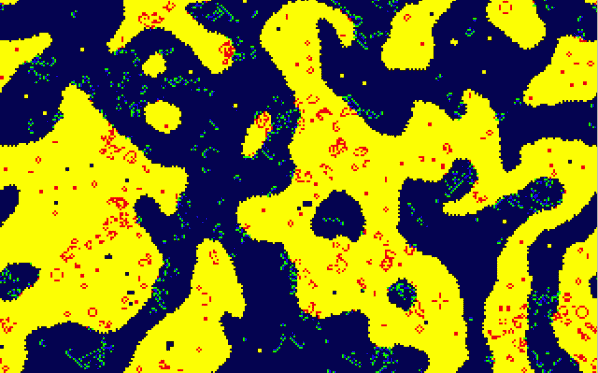
If Turing – the godfather of universal computation – had little knowledge on the output of his own discovery, what does this say about us now? (what does it say about Google’s own recent tribute?) Turing’s famous article lays bare a different interpretation; that he certaintly didn’t envisage computers as simple communication tools for human whims, but did he indirectly expose automatons with agency. What the hell is an automaton?
How he came to define what this agency is, was brutally cut short. However it’s clear from his work on morphogenesis (which Turing began at the same time as his theoretical forays into machinic thought) that some preliminary form of complexity theory was the way forward. It certainly undermines the positivist wing of artificial intelligence research which invests in some predictable form of knowledge where machinic intelligence can only be ‘known in advance’ when it passes for sentience. Do real world formal language systems already contain the type of surprising ambivalence which Turing noticed? Furthermore, do machines experience this level of ambivalence between each other themselves? This is a question which the transparency of analytic rigour and scientific provability would remove for being undisciplined. Turing’s own words suggest otherwise.
In a subsequent lecture broadcast on BBC Radio in May 1951 called “Can Digital Computers Think?“, Turing elaborates on this further using some exquisite metaphors and analogies;
“It is not difficult to design machines whose behaviour appears quite random to anyone who does not know the details of their construction. Naturally enough the inclusion of this random element, whichever technique is used, does not solve our main problem, how to programme a machine to imitate a brain, or as we might say more briefly, if less accurately, to think. But it gives us some indication of what the process will be like. We must not always expect to know what the computer is going to do. We should be pleased when the machine surprises us, in rather the same way as one is pleased when a pupil does something which he had not been explicitly taught to do.”
We have here, in the pangs of its birth, a self-confessed weird quality to the construction of computing in its preliminary stages. It’s this otherness, notably absurd quality to the agency of computing which the humanities (and especially the digital arts) could re-appropriate for it’s own unpredictable ends.
And to some extent this hardly exists as new territory for practising artists who began working with early structural computing systems from the late 1960s – the surprising reality of deterministic rules. I’m sure many artists and programmers, especially those who constantly negotiate their way through complex compilers, stack libraries, code, bugs, glitches and information loss, testify to the same surprises that Turing experienced. For it was Turing who originally suggested that writing and mechanism were almost synonymous.
While I’m sure no aficionado of the Turing Centenary would refute our own particular conjecture, they wouldn’t admit to a conflict between the rhetorical primacy of Turing’s text against the dominant and subsequent scientific uptake. For while the sciences of predictability continue to locate Turing’s legacy as their own, they leave open the chance for the humanities to account for the unpredictable qualities of Turing’s legacy which are ignored. I look forward to the next 100 years.

Featured image: Sculptured relief of Roman soldiers fighting the barbarians.
Lies, Lawlessness and Disbelief 1. Thinking Art and Capital: Unknown Unknowns, is the second of five essays by Canadian artist & critical thinker, Katie McCain. McCain discusses how capitalism has become on the one hand all encompassing and on the other utterly unreal. Arguing that we need to be prepared to think the impossible so that resistance is able to grow.
DOWNLOAD the full text (including all 5 parts) here, or read part two below:
In 1942 the Ministry of Defense labeled Gruinard Island as X Base. It was an isolated island that had been deemed acceptable for testing the viability of an anthrax weapon, as it was unknown if the spores be able to survive the blast. An anthrax bomb was dropped on a herd of sheep kept in individual crates, their heads in hoods so they could not lick the spores. Of 15 sheep, only 2 survived. The test was repeated with less success as a change in wind direction caused the bomb to land in a peat bog where it sank. The test was moved to Wales. In 1981 operation dark harvest – led by a team of microbiologists – collected soil samples from Gruinard Island, which had since been quarantined. Their demand was for the government to decontaminate the island or the samples would be weaponized and distributed. Two samples were found outside a research facility in Porton Down, and in Blackpool, where the ruling conservative party were meeting.[1]
Unknown unknowns are intrinsic to this conceptual, contemporary capitalism, and operate as the risk that can eventually cause a system to fail. Failure emerges from the unprecedented, from the unthinkable, from the things you do not know you do not know.[2] Instead of attempting to predict these events for market gains, what would it mean to merely acknowledge the paradoxical nature of thinking the unthinkable? Unthinkable operates as the other to any thought capacity, and in an attempt to access this impossible, it would be possible to access a non-knowledge, something on the edge of logic, of research, of ideas.
Non-knowledge is not the same as ignorance, but rather references the other of the knowledge system itself, an indeterminate zone between knowledge and ignorance.[3] Huberman addresses this topic in the exhibition catalogue: For the Blind Man in the Dark Room Searching for the Black Cat that Isn’t There. The phrase was initially attributed to Charles Darwin’s description of a mathematician, but here is used to underscore the type of knowledge, the type of logic, that art explores. A work of art that isn’t. As a method of generating new forms of thinking and unknown circuits of consciousness, visual art often verges on logic.[4]
Quantum physics is constantly pushing the boundaries of the unknown. If these formulations, these theories, constitute the boundary of the known, imagine the possibilities contained in unknown unknowns. This of course is impossible, but in the impossible lays unimaginable possibilities. The acceptance of the fact that there are unknown unknowns and, like dark matter, they are invisible, but make up the majority, could operate as a placeholder for limitless possibilities.[5] The things we do not know are impossible, contradictory and badly behaved; the things, then, that we do not know we do not know could be more radical still in terms of reality and the perception of it –an impossibility for thought, but this is the heart of it, the possibilities contained in the impossible. It is fundamentally possible for anything to be true (or conversely false), to be known (or to be unknown)[6]. The more this point is exhumed the more amazing and simultaneously frustrating it can become.
Quantum reality proves that we can alter reality just by looking at it. Photons behave differently under scrutiny than when left to their own devices, which leaves us incapable of describing their behaviour.[7] Einstein asked physicist Niels Bohr if he really believed that the moon disappears when no one is looking at it, to which the retort was “can you prove otherwise?”[8] The answer is of course no, we are incapable of removing ourselves, of removing our relation to the thing-in-itself, of removing the impact of thought from suppositions of reality.
‘Quantum physics is an exciting theory because it is extremely precise, it is mathematically beautiful, it describes everything. It just doesn’t make sense.’[9]
Perhaps the language of mathematics is not a language invented in order to describe reality, but rather is the basis on which the physical world manifests, and slowly consciousness grasps more and more of this structure. If the theory is wrong, fundamental physics will hit a roadblock beyond which is it impossible to tread; if the theory is right everything is potentially understandable, dependant on thought’s capacity to understand.[10] These fundamentally opposite poles of reality offer, to us, the same plain of comprehension – the capacity of thought, the very limit of which we cannot pass.
Dreamwork, specters, illogic, the impossible – it is where thought begins to break down in terms of accuracy or coherent narrative that it begins to get interesting. On the fringes of thought lie truth, radicalism, subversion and change. And on the fringes of reality are lies, paradox and the imaginary. Does this mean that truth can be found in lies, paradox and the unreal?
The market depends on our belief in it, and our lack of faith can have catastrophic results. So bolstering collective belief in markets is the main strategy for their stabilization. But consciousness is not so simple; the market begins to rely not only on our belief in it, but in our belief in our belief in it[11], and so on ad infinitum. An infinite regress of belief created in order to prop up that self-same belief. How can consciousness continue to reconcile itself with this infinite regress? In quantum physics, observing photons can change how they behave. In the market, disbelief can cause it to collapse. A ping pong ball, by the time it’s bounced nine times factors the gravitational pull of a body standing next to the table into it’s bounce, by the 56th bounce ever single elementary particle of the universe has to be present in your assumptions [12]. In reality, many things are affected by human existence, but thought, or existence itself is not one of them.
It is not true that in order to live one has to believe in one’s own existence. There is no necessity to that. No matter what, our consciousness is never the echo of our own reality, of an existence set in “real time.” But rather it is its echo in “delayed time,” the screen of the dispersion of the subject and of its identity – only in our sleep, our unconscious, and our death are we identical to ourselves. Consciousness, which is totally different from belief, is more spontaneously the result of a challenge to reality, the result of accepting objective illusion rather than objective reality. This challenge is more vital to our survival and to that of the human species than the belief in reality and in existence, which always refers to spiritual consolations pertaining to another world. Our world is such as it is, but that does not make it more real in any respect. “The most powerful instinct of man is to be in conflict with truth, and with the real.”[13]
Asleep, unconscious or dead. These are the three options in which one is identical to oneself. But what does that mean? Harman discusses sleep as a lack of relations. We still exist as pieces that make a physical whole, but the thing we lack in sleep is relations. ‘Sleep is our closest approach to the freedom from relations in which we are most ourselves’[14]
An object, too, can be dormant. It is capable of existing apart from a specific situation, and therefore is capable of existing apart from any situation at all; therefore, it is relationless, or has the possibility to be relationless. Unlike objects, however, this dormancy is not so much a freedom from the world, as a dormancy to the world, withdrawn, incapable of anything else.
Yet, in a sense we are always inside the world through the fact that we are made up of pieces – and only therefore are we free, with our components doing the work of liberty on our behalf. For there is an excess in our pieces beyond what is needed to create us, and this excess allows new and unexpected things to happen.[15]
So perhaps seeking freedom in individuation, in isolation, as the linking of subject to object, in the perpetual delay of satisfaction that capitalism offers is the achievement of the exact opposite of the freedom sought. Perhaps the individual freedom presented by capital and democracy is in fact a relationless sleep that removes the other, the alternative, removes the opportunity for change, and ultimately time itself.
sl
sle
slee
sleep
Freudian kettle logic is an example, a joke employed by Freud to explore the mind’s capacity for self-deception. It is this logic, or rather this illogic that some manages to access the impossible. Kettle logic refers to the thought process of a mind on the defensive. It shows the impossibility of thought or rather it’s circular nature, that manages to disregard laws of non-contradiction. It goes as follows:
A neighbour is accused of borrowing a kettle and returning it with a hole. He answers simultaneously that 1) he did not borrow the kettle; 2) it was unbroken when he returned it, and 3) that it was broken when he borrowed it.[16]
Freud uses this to unpack dream logic, during which time mutually exclusive answers or states can easily co-exist. “Wendy Brown says that dreamwork provides the best model for understanding contemporary forms of power. It produces a confabulated consistency that covers over anomalies and contradictions”[17]. Žižek uses Freudian kettle logic to explain the U.S.’s right to wage war on Iraq, and the notion of the pre-emptive strike, which renders events of the future to a fictional or probabilistic past.[18]
Žižek also argues:
If we postpone our action until we have full knowledge of the catastrophe, we will have acquired that knowledge only when it is too late. The certainty on which to act is never a matter of knowledge, but a matter of belief. If, accidentally, an event takes place, it creates a preceding chain which makes it appear inevitable – Hegelian dialectic of contingency and necessity. In order to confront a disaster – we should accept it as fate, as unavoidable, and then retroactively insert into the past of the future possibilities on which to act in the present.[19]
This is frighteningly similar to the rhetoric of war used by the right, but employed by the left with regard to environmental disaster. Both the right, and the quite radical left in this instance, are using the same logic of prediction to validate an action. The difference, it seems, is Žižek’s disbelief, or awareness of the impossibility of a situation that requires action despite the fact that the specifics of the situation itself are still largely unknown.
Link to first article
https://www.furtherfield.org/lies-lawlessness-and-disbelief-1/
Adorno, Theodor.W. Negative Dialectics. Translated by E.B. Ashton. New York: Continuum, 2005. First Published 1966 by Suhrkamp Verlag.
Associated Press. “Romanian Witches Curse Latest Government Clampdown,” The Guardian, February 9, 2011, main section, 20.
Bartlett, Monica Y., Aida Cajdric, Nilanjana Dasgupta and David DeSteno, “Prejudice from Thin Air: The Effect of Emotion on Automatic Intergroup Attitudes.” Psychological Science 15, no. 5 (May, 2004): 319-324.
Baudrillard, Jean. Global Debt and Parallel Universe. Translated by Francois Debrix. http://www.egs.edu/faculty/jean-baudrillard/articles/global-debt-and-parallel-universe/ (accessed April 4, 2011).
Baudrillard, Jean. Radical Thought. Translated by Francois Debrix. Edited by Sens & Tonka. Paris: Collection Morsure, 1994.
Bey, Hakim. T.A.Z.: Temporary Autonomous Zone, Ontological Anarchy, Poetic Terrorism. New York: Autonomedia, 2003. First Published 1985.
Bradley, Will. “Guarana Power.” in Self-Organization/Counter-Economic-Strategies, edited by Bradley, Hannula, Ricupero and Superflex, 311 – 333. New York: Steinberg Press, 2006.
Brassier, Ray. “I Am a Nihilist because I Still Believe in Truth” Interview with Marcin Rychter. Kronos: March 4, 2011 http://kronos.org.pl/index.php?23151,896 – accessed: march 23rd, 2011.
Brassier, Ray. Nihil Unbound: Enlightenment and Extinction. Basingstoke: Palgrave McMillan, 2007.
Critical Art Ensemble. Marching Plague: Germ Warfare and Global Public Health. New York: Autonomedia, 2006.
Declercq, Frédéric. Lacan on the Capitalist Discourse: Its Consequences for Libidinal Enjoyment and Social Bonds. Psychoanalysis, Culture & Society 2006, 11, (74-83).
Fisher, Mark. Capitalist Realism: Is There No Alternative? Winchester: Zero Books, 2009.
Foucault, Michel. Power/Knowledge: Selected Interviews & Other Writings: 1972-1977. New York: Pantheon Books, 1980.
Fromm, Erich. The Fear of Freedom. London: Routledge & Kegan Paul Ltd., 1966.
Groys, Boris “Art and Money,” E-Flux 24 (2011), http://www.e-flux.com/journal/view/226.
Harman, Graham. Circus Philosophicus. Winchester: Zero Books, 2010.
Hofstadter, Douglas R. Gödel, Escher, Bach: An Eternal Golden Braid. London: Penguin Books Ltd., 1979.
Holt, Jim. “The Way We Live Now: Against Happiness,” New York Times, June 20, 2004.
Horizon: What is Reality? Documentary. Directed by Helen Shariatmadari. BBC: ep. 9, 2011.
Huberman, Anthony, ed. For the Blind Man in the Dark Room Looking for the Black Cat that Isn’t There. St. Louis: Contemporary Art Museum St. Louis, 2009.
Huxley, Aldous. Brave New World. London: Vintage Books, 2007. First published 1932 by Chatto & Windus.
K-Punk Blog. http://k-punk.abstractdynamics.org/archives/004421.html
Kafka, Franz. The Castle. Middlesex: Penguin Books Ltd., 1964. First published 1926 by Das Schloss.
Kurant, Agnieszka and Nassim Nicholas Taleb. “Unknown Unknowns: A Conversation between Agnieska Kurant & Nassim Nicholas Taleb about the Benefits of Uncertainty.” Frieze, September 2010, 127 -135.
Lacan, Jacques. “Seminar on the Purloined Letter.” Yale French Studies 48 (1972): 39-72.
Lacan, Jacques. The seminars of Jacques Lacan: Book II: The Ego in Freud’s Theory and in the Technique of Psychoanalysis 1954-1955. Ed: Jacques-Alain Miller. New York: W. W. Norton and Co., 1991.
MacKinnon, Catharine A. “Feminism, Marxism, Method and the State.” Chicago Journals 8, no. 4 (1983), 635-658.
Meillassoux, Quentin. After Finitude: An Essay on the Necessity of Contingency. London: Continuum, 2008.
Mouffe, Chantal. The Democratic Paradox. London: Verso, 2000.
Noys, Ben. Persistence of the Negative: A Critique of Contemporary Continental Theory. Edinburgh: Edinburgh University Press, 2010.
Place, Vanessa and Robert Fitterman. Notes on Conceptualisms. New York: The Ugly Duckling Presse, 2009.
Stephen, Kylie. “Sexualized Bodies.” in Real Bodies: A Sociological Introduction, edited by Evans and Lee, 29-45. Basingstoke: Palgrave MacMillan. 2002.
Taleb, Nassim Nicholas. The Black Swan: The Impact of the Highly Improbable. London: Penguin Books Ltd., 2007.
Thacker, Eugene. “Nihil Unbound” review of Nihil Unbound: Enlightenment and Extinction, by Ray Brassier, Leonardo 42: no.5, (2009): 459-460, http://muse.jhu.edu/journals/leonardo/v042/42.5.thacker.html (Accessed April 2, 2011).
The Trap: What Happened to Our Dream of Freedom? Documentary. Directed by Adam Curtis. BBC Two: March 2007.
Trotta, Roberto. “Dark Matter: Probing the Arche Fossil.” Interview with Robin Mackay. Collapse: Philosophical Research and Development 2 (2007): 83-169.
Vidal, John. “Bolivia Enshrines Natural World’s Rights with Equal Status for Mother Earth.” The Guardian. April 11, 2011. Main section, 15.
Weaver, Matthew. “Romanian Witches to Cast Anti-Government Spell.” The Guardian. January 7, 2011. Main section, 23.
Wilson, Eric G. Against Happiness. New York: Sarah Critchton Books, 2008.
Žižek, Slavoj. First as Tragedy, Then as Farce. London: Verso, 2009.
Žižek , Slavoj. The Iraqi Borrowed Kettle. http://www.lacan.com/zizekkettle.htm (accessed April 4, 2011).
Žižek, Slavoj. What Rumsfeld Doesn’t Know that He Knows About Abu Ghraib. (2004) http://www.lacan.com/zizekrumsfeld.htm (accessed April 4, 2011).
No archive is perfect. No one, I assume, will contest this claim – especially, in this day and age, where archives are everywhere and everything is miscellaneous (Wiser). It is a reasonable claim that this new way of using archives, socially and privately, has created a new understanding of what archives are – and what they are not. At least, it seems much more logical today to claim that any archive including the ‘grand’ and professional (scientific) archives of national and international libraries and museum are imperfect and even selective. People are selective in their choices and tastes and their archives are a mirror of their biases and behaviours. Personal taxonomies are contextualizing social networks. As a mirror of professional and scientific networks, it is easy to assume similar processes of (in this case academically grounded) choices and tastes taking place in the formation and construction of ‘grand’ archives.
My claim is that there are huge lacunas in the construction of the ‘grand’ archives, as well as in the construction of our ‘collective’ knowledge, and it would be tempting – if we consider the other end of the argument that Mark Wiser makes, which indicates that we may never bridge or fill all of them (the idea would be absurd) – to claim that none of it matters. The ‘homemade’ logic being that there is not anything interesting to find, anyway – and if there were, ‘they’ (the professional and scientific networks) would certainly know about it.
This paper argues that this is certainly not the case. The professional and scientific networks did not find, and do not know everything (!) – a lot of dynamic and significant cultural knowledge remain unheard of. Therefore, it is important and should be a priority to examine the lacunas and gaps (if we can find them) and understand them in a cultural and scientific context. Somehow they were excluded or sifted out of the ‘official’ construction of archived knowledge, and how and why this happened is an important scientific question to ask. Furthermore, the notion (it does not qualify as an argument) that only the important stuff made it into the archives, and that it only made it exactly because it was important, is as absurd as it is, almost, a dangerous (and not scientific) point of view.
In any case, the unheard avant-gardes are a part of the lacunas and gaps of the ‘grand’ archives. However, they are the very stuff of private and social networks and ‘small’ archives – to be considered as precursors (avant-garde) of the social media revolution. Maybe it is not until now that we are able to imagine the formats of an archive for ephemeral and mediated art practices – as well as other innovative and technologically experimental modalities of cultural production.
What is an unheard avant-garde? Of course, the answer may be tautological: no one has ever heard of the unheard avant-garde, as it were.
And then again – rumours and curatorial intuition has it that private and ‘small’ archives around the globe are full of unheard stuff. In this case, I am focusing on the ephemeral, experimental, performative and intermedial art practices and projects by energetic project makers (often long since deceased) that never made it into the ‘grand’ archives – and, after a time, are forgotten, simply.
This project has the anterior purpose to define the modalities needed and methodologies to obtain them in order to reactivate, on a curatorial and humanistic level, the field of the ‘unheard avant-gardes’ (if it indeed is one field) – what are the categories? How do we describe them? Do they manifest themselves into (new) paradigms? And what would be best practice for metadating and documenting the field? Furthermore, these questions also point towards a more fundamental problematic regarding the definition and function of ‘art’ in a mediated cultural context and environment.
What is invested or, indeed, put at risk by reactivating the unheard? This is a question pointing back to the discussion of the transforming ontology of humanstic reception and its modality of ’archiving’ (a discussion I partake in another paper (Flexowriter…).
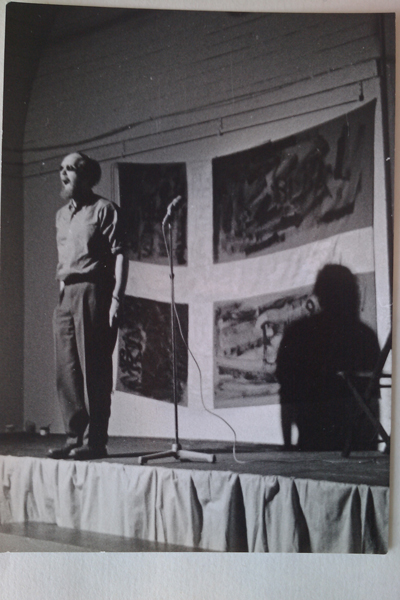
Some remarks on my use of the Avant-garde concept.
A Classical approach would be to explore the history (of known representations) & theories of the avant-garde, describe and discuss in inter(con)textual views. Fine as this may be, however, there is a tendency to overlook or exclude the experimental practices of the avant-garde artists. Look at it as a production of new meaning or sensuous technologies, as it were, rather than something ‘finished’ and ‘fitting’ the (largely) ocular/text-based production of knowledge in classical academia and/or archives. The Avant-garde is never finished. It is always messy, and still searching, I would say, for the right eyes and ears – even after 40, 60, 80 years.
I would like to propose to make experimental avant-garde practices enhance the debate within the research in & of the History and Theories of Avant-garde Art. My approach – and transdisciplinary take on the avant-garde – is based on the assumption that the avant-garde practices in e.g. technology and sound was, essentially, part of the formation of a ‘media art’ – a kind of off-road history-in-the-making running below the ‘official’ history-as-it-were of art.
The modalities of this subterranean ‘media art’, or experimental avant-garde, are:
My research project focuses on three levels: how and why sound art became unheard (of) in the ‘grand’ archives?; what archive-formats are needed to ‘store’ the unheard avant-gardes (so they do not become unheard (of) again?; and how it may enter the sphere of the general public?
The silence of sound art is symptomatic of certain cultural, aesthetic and scientific paradigms that are inherited via the knowledge systems and epistemologies that define the institutionalized archive competences (Joseph Beuys, Michel Foucault).
How to change the traditional status of sound art, in archives and elsewhere: it has more often than not gone silent – out of reach for researchers and a general public.
The Unheard Avant-gardes project, then, focuses on a critical re-activating of sound art as an experimental practice – getting and letting the silent Avant-gardes out of the boxes and off the shelves – and into a network of digital distribution where it may be accessed, exhibited and explored – listened to – in detail and in a context.
Thus, I will claim, that to be ’unheard’ is a fundamental condition and premise for performative and mediated art practices – in the ‘grand’ archives (in the sense, that they are not ‘on the shelves’) as well as in the construction of the cultural contexts and social memories (history). I refer to the unheard avant-garde in the sense that it is experimental and in the forefront of a cultural and technological transformation in its day. It formed it’s own networks and worked from there. However, I do not intend to refer to the ‘avant-garde’ in the sense of a specific (artistic) genre or group or period or style or whatever (that may be). My argument will be that the unheard condition, and the reappearance of unheard avant-gardes and their (somewhat) hidden networks, is something that ’mirrors’ a change in the modes and modalities of the production of knowledge in a distributed, post-digital culture. Thus, the unheard condition is as fundamental an aspect in the understanding of the formation of ‘grand’ archives, as it is a key-element in an analysis of change and transformation of paradigms – and how science and art performs in and respond to those transformations. On one level, the existence of unheard avant-gardes is the mark of mediated, fugitive and ephemeral strategies and tactics in the art practices that emerged in the late 1950s and during the 1960s. On another level, it is a true ontological gap – and the reappearance of the unheard avant-gardes may very well prompt us to rewrite history.
It is about time we put an ear to the archive ground.
To limit myself, I am putting a special focus on cases that turned up in my search after the particularly unheard (of) in the ‘grand’ archives: POEX65. First a note on how to search and identify the unheard avant-garde in (or, rather: outside) existing archives. I particularly looked for sound material from collaborative, performative, time-based, intermedia art, media art, and new media art projects from 1920s to present day; and I looked at small and private archives and triangulated what I found here – dates, persons, places, other artists – with the databases (or, in most cases, before 1983, written / printed records) of the Danish Broadcast Company and Statsbiblioteket (The Danish National Library).
I also put an ear to the collection of (inter)media art from 1950s and onwards at the Museum of Contemporary Art in Roskilde, of which I was the Curator between 1999 and 2008. This archive encompasses art, which is practicing “fusions of words, images and sounds”, often in different variations of performative, fluxid, conceptual, and mediated situations. The archival status is marked by varied and fugitive material, to say the least.
In my search I was also preoccupied with finding adequate framings for the categorization and contextualization of the archive (which was being established at the time and still is under construction), which (quite naturally, it seemed) proved inadequate on closer inspection and formulation. This certain affinity with the ear in the archive-context further sparked my interest in finding a systematics and methodology of the unheard; which, in turn, enhanced the attempt to implement a transdisciplinary practice and a sensuous technology into the core of the construction of the archive, allowing a dynamic flow of domains to establish themselves in a real time dialogue with an audience.
The sensuous material of sound, and the modalities of using the ears in new ways – exploring sonic perception – is the issue.
The ontology of an archive of media / sound art. Two ontological factors: 1) Instability of the material (and its contexts); 2) The material is in need of reactive strategies in order to be ’heard’ or merely ’noticed’ by recipients. The unheard status is an unwanted, but nevertheless actual status of most of the media art material that is existing in the archives.
Key-instabilities of sound-based / documented media art:
POEX 65 was a transdisciplinary experiment and event, which took place in ‘Den Frie Udstillingsbygning’ (The Independent Exhibition Building) in Copenhagen, December 10-20, 1965. Short for ’POetry EXperiment’, POEX 65 was an exhibition event curated and created by Danish artist Knud Hvidberg (1948-91). It aimed at breaking the boundaries of art genres, the false division of professional and amateur, as well as the autonomy of the ‘work of art’ through the active use of technological and mediated platforms such as Flexowriters, Punch Paper Poetry, and Electronic Visual Music. As such, it was a very important event in Scandinavian media art history with more than 80 participants from 5 countries – many of whom became part of the leading class of artists in Scandinavia.
Nevertheless, POEX 65 somehow was forgotten – and almost erased from the academic memory and public archives.
The Danish Broadcast Company (DR) did broadcast two programs, of which at least one was dedicated to POEX65: ‘A Sunday’s Walk w. Ella Wang’. However, the tape with this particular program was not in the archives of DR anymore – erased or reused, or?… no one can tell from the records. It is simply not there: Truly, an unheard avant-garde!
Long story short: I managed to locate a taped copy of the program in the private collection of one of the participants at POEX65, Kirsten Lockenwitz. From that tape, I managed to get a number of other information that led me to other recordings – and, suddenly, we had sound! Slowly, POEX65 came ‘alive’ again – for the first time in more than 40 years.
A very important part of the POEX65 event was the large number of experiments with cross-overs between musical artforms, from electronica to beat, to other artforms. This may also explain why the event never became part of official records or archives – and was erased from the DR broadcast-archive: It was transdisciplinary before that word even existed… it was way ahead of its time.
From the sources available to us, it seems fair to establish as a fact that five ‘stages’ were active in POEX 65: The ante-room (visual poetry), the Large Exhibition Room (Happenings and Live Music), the Centre Hall (Theatre), the expanded poetry space (+ Flexowriter), and the so-called ‘Co-ritus’ Environment by Jørgen Nash, Jens Jørgen Thorsen, Hardy Strid and Carl Magnus). (Hvidberg, Invite to participate in POEX 65 (in danish) 1965) (Barbusse 1991) (Rubin 1987)
From the program, it is possible to collect a list of ‘new’ concepts for these crossover categories:
This is just a loose collection of the terms mentioned in the program and in other material… and it shows, I think, the boundary breaking range that the POEX65 experiment had as well as the amount of collaborative artistic, creative and intellectual efforts that were put into the project. They really sought to work across the different artistic sections as well – Fluxus, Situationists, EKSskolen, DUT, as well as Jazz, Beat, and Electronic Music, and amateurs and technicians / engineers etc..
There was a heated discussion over the issue of artists’ autonomy, which was written down by Knud Hvidberg. The Danish EKSskole wanted a space they could control, however Knud Hvidberg did not want that – but insisted on an open space for everyone (including audience and ‘amateurs’) where anything might happen. Finally, the EKSskole did not participate as a group in POEX65, but a number of the artists (more loosely) associated with EKSskolen did participate individually.
It is a fact, however, that POEX65 did manage to bring together a large variety of artists from all kinds of art genres and ‘ideologies’. And they did work together in a number of ways. So far, I have identified some 128 ‘actors’ – artists, engineers, dancers, musicians, active audiences etc. – that were part of POEX65.
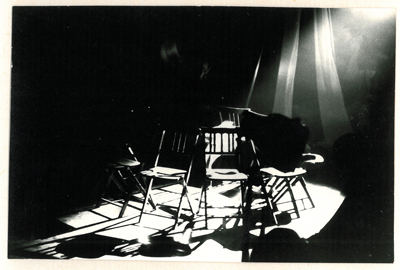
Together with Knud Hvidberg and the Danish Visual poet Vagn Steen, Karsten Vogel was at the ‘centre’ of the POEX65 event. Since the early 60s, and together with two other Danish semioticians and theoreticians, Peter Madsen and Per Aage Brandt (the latter was also a jazz pianist), Vogel had run an informal ‘study-group’ of new tendencies and theories of collaborative work-formats and actions of art. POEX65, in many ways, fed into the ideas and thoughts coming out of that group – who also participated with an event during the 10 days of activies. Vogel, however, had his main role as the experimental jass-musician who inspired the music-paint-light situated works happening at POEX65. A short clip from Jazz News in december 1965 was recovered from the personal archive of Kristen Lockenwitz, from which you may hear a ‘glimpse’ of what was going on. From this recording we hear Vogel and Brandt playing in a set-up, where certain ‘signals’ or ‘motions’ by the painters or light-artists, triggers a chaotic outbrake of sounds from a number of acoustic instruments.
Another important (artistically experimental) grouping was centred around Knud Hvidberg, William Soya, and Hans Sandmand. Together, those three artists had made a number of technology-based exhibitions and projects since 1957 – and, even though William Soya did not participate in person at POEX65, it is him who introduced the Flexowriter into the context, and experimented with how to use it for art purposes (see Flexowriter…). Hans Sandmand, however, participated with a number of interactive sound installations – most noteworthy, perhaps, the Radar which was standing (and turning) in the central hall where people entered the space. When you pushed a button on the radar, a voice said: ‘I am looking for the great intuition’. In another work, a pile of used car tires revealed a mirror when you looked down into the pile – and, as you looked, a voice recording was activated, saying: ‘poetry is something you carry in yourself’.
Not all artists participated on the same level of collaboration. Not everyone was ‘living out’ the radical ideas of Knud Hvidberg about collaboration, loss of autonomy, and the ‘exhibition as show’. Even so, they all seem to adopt some element of the conceptual framing of POEX65, like the processuality and audience participation. A good example would be the Danish Fluxus artist Eric Andersen. He contributed to POEX65 with a number of original works. Among them, ‘Her Bathing Suit Never got Wet’ and ‘I Regret the Bad Circumstances for Recording’ were all sound recordings and part of the ‘record bar’. ‘Opus 51’ was a performative event operating within the Fluxus methodology and aesthetics. Photos exist showing Eric Andersen sitting in the ‘central hall’, waiting for the audience to arrive. This event made the audience actively collaborate in realizing the work by running through a combination of operations based on rules defined by Andersen.
Time and chance would make Eric Andersen well-known (and well-represented) in Danish archives, whereas William Soya, Hans Sandmand, and Knud Hvidberg – despite their visionary and innovative use of technology and sound as media in visual arts at a very early stage (for DK as well as internationally) – more or less went into obscurity. Lost in translation… from moving media and sound to text and (still) images.
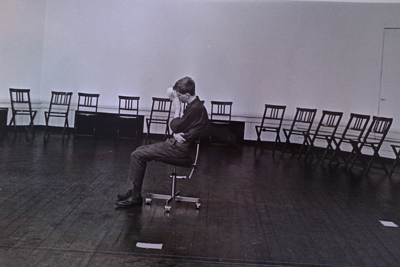
From all this, it appears that the Unheard Avant-gardes project is more than ‘just’ an archive project. It is as much a re-investigation of the fundamental conditions and status of ‘media art’ – the experimental avant-garde. As such, it may also be viewed as an attempt to re-configure (the academic ideas about) the relations between technology, media, and art, and write a theory of this re-configuration.
The reconfiguration is being put to a test when a number of ‘interfaces’ to the unheard avant-garde is presented (in a special section with focus on Scandinavia) at the exhibition TONKUNST – Sound as Medium for the Visual Arts in the 20th Century at ZKM (opens March 17, 2012).
The unheard avant-garde section will present three platforms. Each platform presents a notable and important ‘hub’ for the experimenting Scandinavian scene, in which technology, media and artistic practices are mixed and remixed into ‘sound art’.
The platforms are presented and designed by invited artists, as an independent work of art, or a new artistic platform, in such a way that the unheard avant-gardes get a voice in (the construction of) history.
For that purpose, I am operating with a methodology in three steps. 1) Instead of reENactments, which would focus on restaging artworks, I want to reactivate an entire event and context – including its ideas and methodologies. 2) I am dividing the reactivation-strategy into two modalities, Enacts and Reacts, which are focused on, either, the works and contexts of a single artist (enacts), or the idea and context of an entire event. 3) I am using ‘new’ media artists to reactivate the unheard media artists – adding a third element into the reactivation-strategy: that of re-working and re-actualizing works, technology, events and processes.
The first platform will focus on EMS (Elektronmusikstudion, Stockholm). Since 1964, EMS, formerly known as Electroacoustic Music in Sweden, prior to that known as Elektronmusikstudion, is the Swedish national centre for electronic music and sound art.
The second platform will reactivate the particular electronic aesthetics of Finnish Electronic Music Studio & Errki Kurenniemi (FIN). Errki Kurenniemi’s Electronic Music Studio was set up in 1962 with the vision of an automated composition system. In the 1960’s Kurenniemi built Integrated Synthesiser and in the 70’s, a series of custom built music instruments called DIMI.
The third platform will re-activate POEX65. It will include reactive radar, collaborative chairs, and a giant TONEHEAD as sensuous interface for an archive of the unheard avant-garde.
It is from this unheard status of experimental media art that the re-activation of the unheard avant-gardes finds its momentum: Not only in giving the unheard a voice in a number of ways, but also in addressing some fundamental issues concerning the way new transdisciplinary domains are renegotiated across disciplines and boundaries of competences. History will never be the same (again).
For more information visit: http://www.sondergart.dk
“Does Lara Croft Wear Fake Polygons?” that was the question Anne-Marie Schleiner (http://www.opensorcery.net) asked in a gender analysis essay of the popular videogame Tomb Raider published year 2000 in the Switch magazine.
The videogame Tomb Raider was released by Core Design in 1996 and the heroine a British archaeologist named Lara Croft did not only have big guns but also big breasts. In a couple of years she became a well known character not only in the games world but also for the general public when she entered the silvercreen, played by Angelina Jolie. You could say that Lara Croft is the Mona Lisa of the game world, beautiful, mysterious and well known for a large audience outside the games world.
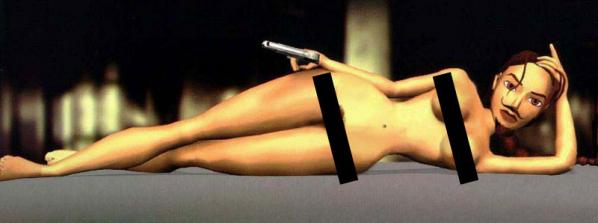
In her essay Anne-Marie Schleiner mentions the famous Nuderaider patch, a game add-on that strips Lara Croft’s clothing so you could play her naked.
The artist Robert Nideffer’s Nuderaider patch made in 1999 consisted of three-parts:
1) an appropriated website where he repurposed the existing commercial site
2) a spoofed mail-server that re-routed messages submit to Lara Croft fan club website to the Director of development at Eidos UK as if it were coming from the Director of Marketing in the US branch
3) a patched version of the Nude Raider patch, which placed police blotter style bar codes across Lara’s private parts (and gave her a goatee as a Duchampian homage), thwarting the game player’s expectation of seeing her polygonal private parts.
“This shows the male dominancy within the game world by having a female lead appearing like a super model. By presenting her naked, it makes the game seem satirical just pushing the creators’ ideas a little further.” Nideffer [2]
In 1919 the artist Marcel Duchamp used a cheap postcard-sized reproduction of Leonardo da Vincis famous painting Mona Lisa on which he drew a moustache and a goatee, in the same way Nideffer later did with Lara Croft. Duchamp called his work L.H.O.O.Q a titled that pronounced in French should be “Elle a chaud au cul”, which translated to English means “She has a hot ass”.
Eidos sent cease and desist letters to the owners of nuderaider.com who were hosting the Nude Raider patch, enforcing their copyright of Tomb Raider.[3]
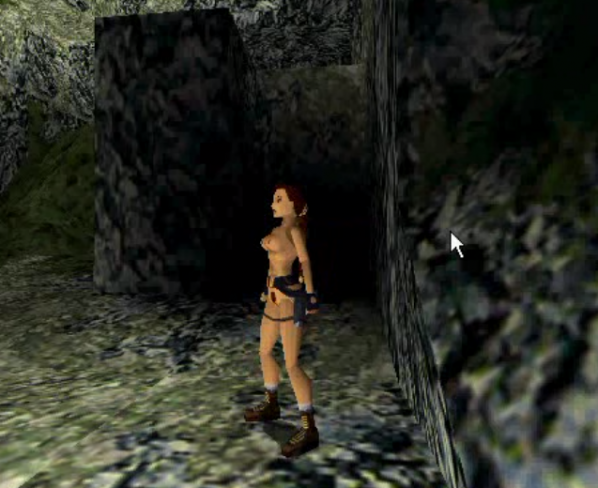
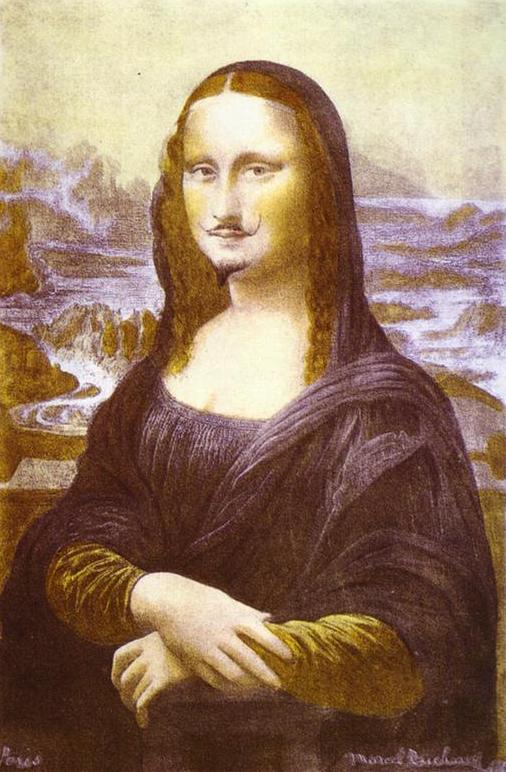
In the machinima “She Puppet” from 2001, the American artist Peggy Aswesh also investigates the gender and cultural identities of Lara Croft by mixing scenes from the Tomb Raider game. Aswesh describes Croft as a virtual girl-doll of the late 20th century, perhaps boy-doll would be a better description since most of the player of the early Tomb Raider games were men or boys. In her essay Schleiner makes the observation that Lara Croft is a “well-trained techno-puppet created by and for the male gaze.” It’s obvious that the videogame Tomb Raider has played a major role in stirring up emotions with its out of date and suspect attitude towards women. But Lara Croft has not only been a subject for critically engaged, artistic gender discussions.
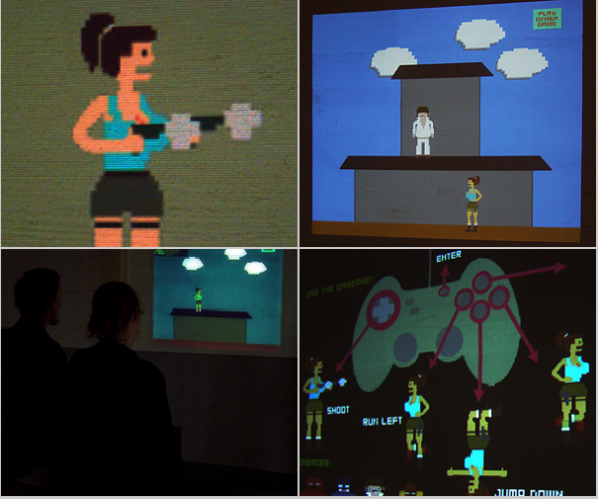
The artists Marieke Verbiesen has created the game Tombraider 0.1 in which she flattened the 3D game into a 2D-world and borrowed aesthetic from the early game consoles. In the new game you could also find references to classic computer gaming experiences such as the stuck “loading” screen, bad language translations and space-invader attacks. It is not unusually that artist create copies of videogames, with 3D hyperrealism graphic, in a retro old-fashioned style.
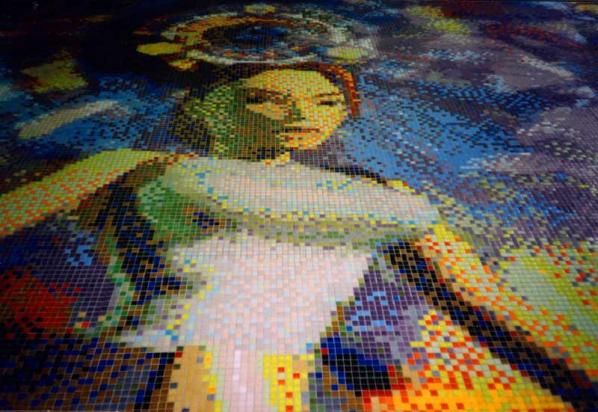
Another way to do this is to use pixel-graphic. That is exactly what Arno Coenen, Rob Coenen and, Rene Bosma did when they re-created he 3D game character into a 2D experience with a touch of pixel-feeling. The project Output: 62.500 materialized pixels, used 62.500 pieces to create a floor mosaic measuring 5,25 x 5,25 meters of the videogame icon Lara Croft. The mosaic has been exhibited at different places in Amsterdam and Kiasma at the Alien Intelligence exhibition in 2000.
So fake polygons or not, it looks like Lara Croft has not only made an impression in the history of videogames but also in the history of art.
Tombraider 0.1 – Single-player game installation based on the famous 3d game Tombraider, starring the female fightingmachine Lara Croft. http://www.marieke.nu/tombraider01/eng/
MUTATION.FEM. Anne-Marie Schleiner “An Underworld Game Patch Router to Female Monsters, Frag Queens and Bobs whose first name is Betty” http://www.opensorcery.net/mutation/
A Computer in the Art Room: The Origins of British Computer Arts 1950-1980
Catherine Mason
ISBN: 1899163891
JJG Publishing 2008
Computing anywhere else but its history often seems like a carefully guarded secret. This has been alleviated by activity around the resurrected Computer Arts Society in the 2000s, notably the acquisition of CAS’s archives by the V&A and the CaCHE project at Birbeck College which ran from 2002-2005. CaCHE, run by Paul Brown, Charlie Gere, Nick Lambert and Catherine Mason, produced conferences, exhibitions, and publications including the book “A Computer In the Art Room”, by Mason.
The art room of the title is the art department of British educational institutions prior to art becoming a degree-level subject. From the 1950s to the 1970s, when the cost of computing machinery dropped from the level where only major government and corporate organizations could afford them to the level where you only needed a second mortgage to afford one, the best way for artists to get access to the enabling technology of computing machinery was usually in an educational institution.
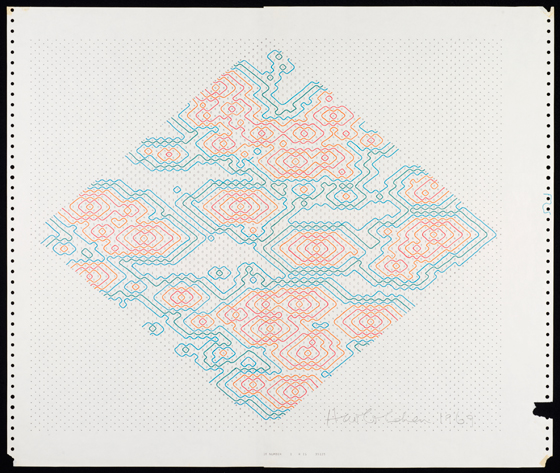
Mason starts out by describing the artistic and art educational situation in the UK at the time of the Festival Of Britain and the foundation of the ICA in London in the early 1950s. She then explains the structure and significance of the emergence of Basic Design teaching, the impact of the Coldstream report on art education, and the rise of the polytechnic colleges over the next thirty years. This provides vital context for the emergence of art computing teaching in the UK. It is also of more general interest for British art history. Conceptualism, performance, Land Art, the Hornsey Art School occupation, and the educational and media graphics that are currently being used as the basis of “hauntological” art all share this background and can better be understood and critiqued with better knowledge of it.
Basic Design courses started in London but didn’t remain there for long. They spread and matured throughout the UK, becoming entangled with the earliest teaching of art computing in provincial technical colleges. Mason traces the family trees of art computing teaching over time through these institutions and back to London-based institutions. Some of the names are familiar from art history (Richard Hamilton, Stephen Willats), some from art computing history (Harold Cohen, John Latham). Where the people involved cross over with cybernetic art, Conceptualism or other artistic currents Mason shows how their ideas fed into and from their art computing work.
The conceptual content of art computing followed the Bauhaus, cybernetics, systems, sociological and environmental influences on art from the 1950s to the 1970s. Its technological forms likewise followed those of mainstream computing. In the 1960s time was leased on mainframes or computers were built by hand. In the 1970s, minicomputers became available and art domain-specific software frameworks or programming languages were written by their users. In the 1980s, workstations with touch tablets, framebuffers, and increasingly proprietary software brought previously unprecedented power and ease of use at the cost of more fixed forms.
The history that I had to piece together as a student from hearsay and from hints in old publications, of the PICASO graphics language at Middlesex University that I found a print-out of the manual for when I was there in the 1990s, of Art & Language’s use of mainframe computers, of early cross-overs between art computing and dance, of cybernetic systems and games that attracted mass audiences before disappearing, is detailed, illustrated and contextualized in page after page of descriptions of hardware, software, institutions, courses and projects. The detail would be overwhelming where it not for Mason’s ability to bring the human and broader cultural aspect of it all to life.
There’s Jasia Reichardt’s Cybernetic Serendipity show at the ICA, Andy Inakhowitz’s Senster robot, John Latham’s dance notation experiments, The Environment Game, and computer graphics drawn with the languages and environments developed in UK art institutions. There’s pictures of the computer systems at the Slade, the RCA, Wimbledon and other art schools that serve as insights into the artists’ studios. There’s the Computer Arts Society, IRAT, APG. And, crucially, there’s the links between them told in a narrative that is coherent while still presenting the breaks and false starts in the story.
The history of “A Computer In The Art Room” reads all too often as brief moments of individuals triumphing against the odds to produce key works of art computing then fading into obscurity, academia or commerce. But any art history that considers a specific context at such a level of detail will look like this. Mason describes works, institutions and artists that deserve broader recognition, although she is under no illusion about how far the road to that recognition may be, citing the example of how long it has taken for photography to be recognized as art in the culturally conservative UK.
The social and pedagogical changes of the period covered by “A Computer In The Art Room” reflect a time of hope and ambition for education in society that made the academy less remote. Mason provides the social, technological and educational context needed to appreciate the very real achievements of art computing that she describes against this backdrop. As a slice of art history this is richly detailed. It touches on subjects far beyond art computing that will help any art student of history better understand the period covered. And it is both a relief and an inspiration to finally have a public record of this important aspect of the history of art computing in the UK.
The text of this review is licenced under the Creative Commons BY-SA 3.0 Licence.